89 Places And Major Tourist Attractions In Bhutan
- Thimphu
Thimphu is the capital city of the Kingdom of Bhutan, nestled in the western part of the country. It is situated in a valley at an altitude of 2,320 meters, making it the highest capital city in the world. The city’s unique blend of traditional Bhutanese architecture and modern developments offers visitors a glimpse into the country’s rich cultural heritage and its rapid modernization. Thimphu is the center of Bhutan’s government, religion, and commerce, and it is home to numerous government offices, religious institutions, and markets. The city is also known for its vibrant nightlife, bustling streets, and a wide range of restaurants serving traditional Bhutanese cuisine as well as international dishes. Despite its rapid modernization, Thimphu retains its traditional charm, and visitors can still witness locals in their traditional dress, go on hikes and treks, and explore the many historical and cultural sites scattered throughout the city. Thimphu is a must-visit destination for anyone who wants to experience the unique culture, traditions, and way of life of Bhutan.
History and Culture of Thimphu:
Thimphu, the capital city of Bhutan, has a rich history and culture that reflects the country’s unique heritage. The city’s history dates back to the 13th century when it was a small hamlet. However, it was only in the 1960s when Thimphu became the capital of Bhutan, replacing Punakha.
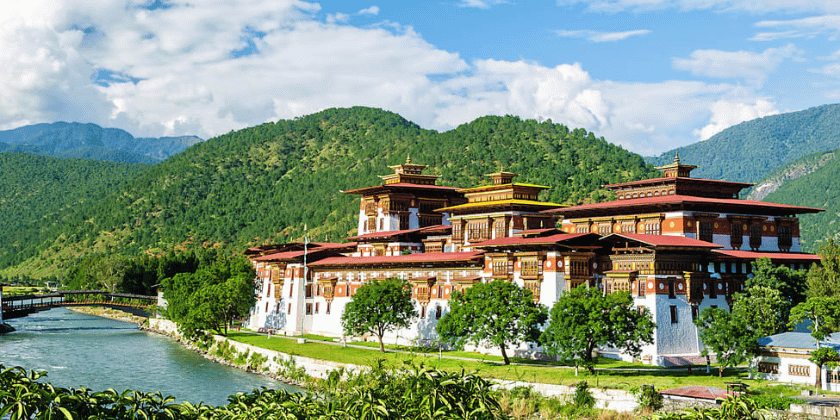
Thimphu has managed to preserve its traditional architecture and culture while embracing modernity. The city’s architecture is dominated by traditional Bhutanese style buildings adorned with intricate carvings and paintings. The streets are lined with prayer flags, and the air is filled with the soothing sound of temple bells and Buddhist chants.
The city is home to several important cultural and religious sites, including the Tashichho Dzong, the National Memorial Chorten, the Buddha Dordenma Statue, and the Changangkha Lhakhang Temple. These landmarks are not only important religious sites but also represent Bhutan’s rich cultural heritage.
Bhutanese culture is deeply rooted in Buddhism, and Thimphu is no exception. The city’s inhabitants follow a unique blend of Buddhism, Bonism, and Hinduism. The Bhutanese people are known for their warm hospitality and friendly nature, making Thimphu a welcoming and safe place for visitors.
Thimphu’s cultural calendar is packed with festivals and events, including the Thimphu Tshechu, a vibrant and colorful festival that celebrates the life of Guru Rinpoche, and the Royal Bhutan Flower Exhibition, a showcase of Bhutan’s unique flora and fauna.
Overall, Thimphu’s history and culture offer a fascinating glimpse into the unique heritage of Bhutan, making it a must-visit destination for anyone interested in exploring the country’s rich cultural and religious traditions.
Must-visit places in Thimphu:
Tashichho Dzong: Also known as the “Fortress of Glorious Religion,” Tashichho Dzong is a stunning traditional Bhutanese architecture that serves as the administrative seat of the Bhutanese government.
- Buddha Dordenma Statue: This is one of the largest Buddha statues in the world, standing at 169 feet tall. The statue is made of bronze and gilded in gold, and offers breathtaking views of the surrounding mountains.
- Changangkha Lhakhang: This 12th-century temple is one of the oldest temples in Thimphu and a popular place of worship for locals. It offers a great view of Thimphu valley.
- National Memorial Chorten: A stupa built in memory of the third king of Bhutan, Jigme Dorji Wangchuck. The chorten attracts both locals and tourists for its religious significance and architectural beauty.
- Thimphu Weekend Market: A bustling market where locals come to buy and sell fresh produce, handmade crafts, and traditional Bhutanese goods.
- Motithang Takin Preserve: A wildlife reserve where visitors can see Bhutan’s national animal, the takin, in their natural habitat.
- Simtokha Dzong: This fortress-turned-monastery was built in 1629 and is considered one of the oldest dzongs in Bhutan. It now serves as a center for Buddhist studies.
- Royal Textile Academy of Bhutan: A museum and educational institution that showcases Bhutan’s rich textile heritage and offers weaving workshops.
- Dechen Phodrang Monastery: A 12th-century monastery that serves as a school for Buddhist studies and houses a statue of Zhabdrung Ngawang Namgyal, the founder of Bhutan.
- National Folk Heritage Museum: A museum dedicated to preserving Bhutan’s rich cultural heritage through exhibits on traditional Bhutanese crafts, costumes, and customs.
- Bhutan Postal Museum: A unique museum that showcases the history of Bhutan’s postal service, including the famous stamps and postcards.
- Jungshi Handmade Paper Factory: A paper factory that produces traditional Bhutanese paper made from the bark of the daphne plant.
- Zangthopelri Lhakhang: A temple built in 1976 that features elaborate murals and paintings depicting the life of Buddha.
- Coronation Park: A large park with walking trails, a large amphitheater, and a peaceful stream running through it.
- National Institute for Zorig Chusum: An educational institution that teaches traditional Bhutanese arts and crafts, including painting, sculpting, and weaving. Visitors can watch students at work and purchase handmade goods at the gift shop.
Must-do activities
Thimphu is a fascinating destination with plenty of activities to do for travelers. Here are some of the must-do activities while visiting Thimphu:
- Visit the Tashichho Dzong: This impressive fortress is the seat of Bhutan’s government and religion. Visitors can tour the dzong and admire its beautiful architecture and intricate details.
- Hike to the iconic Tiger’s Nest Monastery: This famous monastery is located in Paro, just outside of Thimphu, and requires a challenging hike to reach. The stunning views of the monastery and the surrounding area make it well worth the effort.
- Explore the Buddha Dordenma statue: This 169-foot-tall bronze statue is a modern marvel and a must-see in Thimphu. Visitors can climb up to the statue’s base for panoramic views of the city.
- Visit the National Memorial Chorten: This impressive stupa is a monument to Bhutan’s third king and serves as a popular place for locals to pray and meditate.
- Check out the Folk Heritage Museum: This museum provides a glimpse into the daily life and traditions of Bhutanese people through exhibits and demonstrations of traditional crafts, farming, and cooking.
- Shop at the Centenary Farmers’ Market: This bustling market is the largest in Bhutan and is a great place to find local produce, handicrafts, and souvenirs.
- Try Bhutanese cuisine: Thimphu has many restaurants and cafes that serve traditional Bhutanese dishes, such as ema datshi (chili cheese), momos (dumplings), and suja (butter tea).
- Take a walk in the Botanical Garden: This peaceful garden is home to many native plant species, including rhododendrons, primroses, and magnolias. It’s a great place to relax and enjoy nature.
- Visit the Textile Museum: Bhutan is known for its intricate textile weaving, and this museum showcases the different types of weaves, patterns, and styles used throughout the country.
- Attend a traditional Bhutanese festival: Thimphu hosts several festivals throughout the year, such as the Thimphu Tshechu, which features colorful dances, costumes, and music.
- Learn about Buddhism: Thimphu has many temples and monasteries that offer opportunities to learn about Buddhism and participate in religious practices, such as meditation and prayer.
- Take a day trip to nearby attractions: Thimphu is located in a scenic area with many nearby attractions, such as the Dochula Pass, Punakha Dzong, and Chimi Lhakhang Temple.
- Explore the Changangkha Lhakhang Temple: This temple is a popular pilgrimage site for Bhutanese families who come to receive blessings for their newborn babies.
- Visit the National Library: This library is home to an extensive collection of Buddhist manuscripts and other texts, including the world’s largest book, which is 5 feet tall and weighs 133 pounds.
- Attend a traditional archery competition: Archery is the national sport of Bhutan, and Thimphu has several archery grounds where competitions are held regularly. Watching a competition is a unique and exciting experience.
Food:
As the capital city of Bhutan, Thimphu offers a diverse culinary experience that blends traditional Bhutanese flavors with international influences. Visitors to Thimphu can expect to find a wide range of options that cater to different tastes and dietary requirements.
One of the must-try dishes in Thimphu is ema datshi, which is considered the national dish of Bhutan. This spicy dish is made with green chili peppers and a cheese sauce that is rich and creamy. It is typically served with red rice and is a staple in most Bhutanese meals.
Another popular dish in Thimphu is momos, which are small dumplings filled with a variety of savory ingredients such as minced beef, pork, or vegetables. These can be found at many street vendors and restaurants throughout the city.
For those who prefer vegetarian or vegan options, Thimphu also offers a range of options. Many restaurants serve dishes such as vegetable stir-fries, lentil soups, and potato curries that are both flavorful and filling.
Visitors to Thimphu should also make sure to try traditional Bhutanese drinks such as butter tea and ara. Butter tea is a salty tea made with yak butter that is a staple in Bhutanese culture. Ara is a local alcoholic drink that is made from fermented grains such as rice or maize.
In addition to traditional Bhutanese cuisine, Thimphu also has a growing international food scene. Visitors can find restaurants that serve everything from Indian and Chinese food to Italian and American cuisine.
Overall, Thimphu offers a culinary experience that is both unique and diverse. From traditional Bhutanese dishes to international cuisine, visitors are sure to find something that satisfies their taste buds.
Weather in Thimphu and the best time to visit:
Thimphu, the capital city of Bhutan, has a subtropical highland climate with mild winters and cool summers. The weather in Thimphu varies based on the elevation, with the higher areas being colder and the lower areas being warmer. The best time to visit Thimphu is during the spring (March to May) and fall (September to November) when the weather is mild and pleasant.
During the spring season, the temperature ranges from 10°C to 25°C, and the skies are clear, making it a great time for outdoor activities such as trekking and hiking. The famous Paro Tsechu festival is also held during this time, attracting many tourists to Thimphu.
During the fall season, the temperature ranges from 7°C to 23°C, with clear skies and bright sunshine. This is also the time when the famous Thimphu Tshechu festival is celebrated, with vibrant cultural performances and colorful masked dances.
Summer in Thimphu (June to August) is relatively warm and rainy, with temperatures ranging from 15°C to 25°C. This is also the time when the monsoon season hits Bhutan, causing heavy rainfall and making it difficult to go for outdoor activities. However, the countryside is lush and green, and the Wangduephodrang Tshechu festival is held during this time.
Winter in Thimphu (December to February) is cold, with temperatures ranging from -2°C to 15°C. The higher elevations of the city may receive snowfall, making it a popular destination for winter sports enthusiasts. This is also the time when the Punakha Tshechu festival is held.
Overall, Thimphu can be visited throughout the year, but the best time to visit would be during the spring and fall seasons when the weather is mild, and the festivals are held. The weather in Thimphu can be unpredictable, so it’s advisable to pack layers of clothing to be prepared for any weather conditions.
Shopping:
Thimphu, the capital city of Bhutan, is a hub of traditional Bhutanese handicrafts and souvenirs. Tourists can find a wide range of unique and authentic items to take home as a souvenir of their trip to Bhutan.
The main shopping areas in Thimphu are Norzin Lam, the main street, and the handicrafts market near the Taj Tashi Hotel. Tourists can find a range of products such as hand-woven textiles, wooden bowls, prayer wheels, traditional masks, and other handicrafts.
One of the most popular items to purchase in Thimphu is the traditional Bhutanese dress known as the Kira (for women) and Gho (for men). The Kira and Gho are hand-woven and come in a variety of colors and patterns. They are worn by locals on a daily basis and are also worn during festivals and other special occasions.
Another popular item to purchase in Thimphu is Bhutanese handicrafts such as hand-woven textiles, wooden bowls, traditional masks, and prayer wheels. These handicrafts are made by skilled artisans and are unique to Bhutan. They make excellent souvenirs to take home to remind you of your trip to Bhutan.
Tourists can also purchase traditional Bhutanese souvenirs such as prayer flags, prayer beads, and traditional Bhutanese incense. These items are commonly used in Bhutanese households and are considered auspicious.
For those interested in food, Thimphu also has a vegetable market that sells fresh produce and local delicacies such as dried yak cheese and Bhutanese red rice. Visitors can also try Bhutanese cuisine at local restaurants and cafes.
It is important to note that bargaining is not a common practice in Bhutan, and prices for handicrafts and souvenirs are generally fixed. However, tourists can be assured that the handicrafts they purchase are of high quality and are unique to Bhutan.
Overall, shopping in Thimphu offers tourists a chance to purchase unique and authentic Bhutanese handicrafts and souvenirs that are not available elsewhere in the world.
How to reach:
As the capital city of Bhutan, Thimphu is a popular destination for tourists visiting the country. While it may seem remote, there are several options available to reach Thimphu.
- By Air: The easiest and most convenient way to reach Thimphu is by air. The Paro International Airport is the only international airport in Bhutan, located about 50 kilometers from Thimphu. Several airlines operate flights to Paro from major cities such as Delhi, Kathmandu, Bangkok, and Singapore. Once you land in Paro, you can hire a taxi or take a bus to reach Thimphu.
- By Road: If you are traveling from neighboring countries like India, you can reach Thimphu by road. The border town of Phuentsholing, located in the southern part of Bhutan, is the main entry point for road travelers. From here, you can hire a taxi or take a bus to reach Thimphu. The journey is around 6 hours long and takes you through scenic mountain roads.
- By Bus: Bhutan has a good network of public buses that connect different towns and cities. You can take a bus from neighboring towns like Paro, Punakha, or Wangdue Phodrang to reach Thimphu. The buses are comfortable and affordable, but the journey can be slow and time-consuming.
- By Bike: If you are an adventure enthusiast, you can rent a bike and ride to Thimphu. The roads in Bhutan are well-maintained and offer a breathtaking view of the mountains and valleys. However, you need to be an experienced rider as the roads are steep and narrow in some places.
Overall, traveling to Thimphu is a unique and rewarding experience. With the right planning and preparation, you can reach Thimphu comfortably and enjoy the beauty and charm of this unique city.
- Paro
Introduction: Paro is a small town situated in the Paro Valley of Bhutan. This beautiful valley is surrounded by snow-capped mountains and lush green forests. The town is famous for its historic landmarks, beautiful landscapes, and unique culture. Paro is also the gateway to Bhutan, as it houses the country’s only international airport.
History and Culture: Paro has a rich history and culture that dates back to the 7th century. The valley is home to several historic landmarks, including the famous Paro Dzong, which was built in the 17th century. Paro is also home to the National Museum of Bhutan, which houses a vast collection of artifacts that showcase the country’s history and culture.
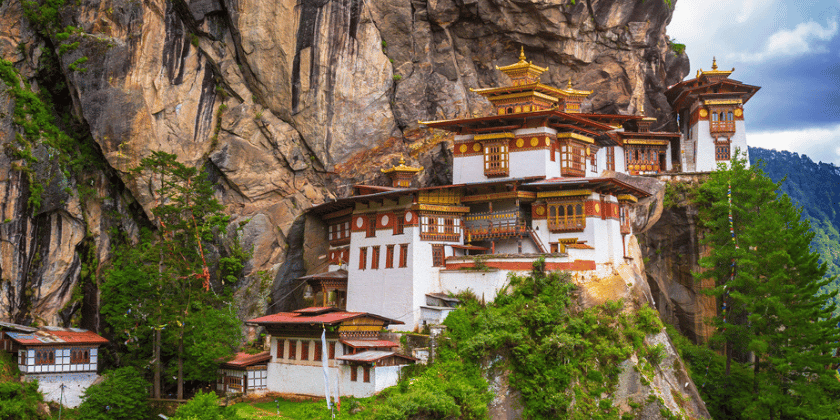
Paro is known for its vibrant festivals, which are celebrated throughout the year. The most popular festival in Paro is the Paro Tsechu, which is held in the spring season. During this festival, locals dress up in traditional attire and perform masked dances to commemorate the teachings of Guru Rinpoche.
Must-Visit Places:
- Paro Dzong: This historic fortress is one of the most popular tourist attractions in Paro. It houses government offices, monasteries, and a museum.
- Tiger’s Nest Monastery: Located on a cliff, this iconic monastery is a must-visit for tourists. The monastery is surrounded by beautiful landscapes and offers a breathtaking view of the valley.
- Kyichu Lhakhang: This ancient temple is one of the oldest and most sacred temples in Bhutan. It was built in the 7th century and is dedicated to Guru Rinpoche.
- National Museum of Bhutan: This museum houses a vast collection of artifacts that showcase the history and culture of Bhutan.
- Drukgyel Dzong: This fortress was built in the 17th century to commemorate Bhutan’s victory over the Tibetan invasion.
- Chele La Pass: This scenic pass offers a breathtaking view of the Himalayas and is a popular destination for trekking and hiking.
- Dumtse Lhakhang: This temple is famous for its beautiful murals and intricate architecture.
- Paro Weekend Market: This vibrant market offers a wide range of traditional handicrafts, food, and souvenirs.
- Zuri Dzong Hike: This picturesque hike offers a stunning view of the valley and takes tourists through beautiful forests and waterfalls.
- Dzongdrakha Temple: This temple is perched on a cliff and offers a panoramic view of the valley.
Main Activities for Tourists:
- Trekking and Hiking: Paro is a popular destination for trekking and hiking, with many trails leading to beautiful landscapes and ancient monasteries.
- Cultural Tours: Paro is home to several historic landmarks and cultural sites, making it an ideal destination for cultural tours.
- Festivals: The Paro Tsechu is a popular festival celebrated in the spring season and is a must-attend for tourists.
- Adventure Sports: Paro offers a wide range of adventure sports, including rafting, mountain biking, and rock climbing.
Cuisine: Paro offers a unique cuisine that is a blend of Bhutanese, Tibetan, and Indian flavors. Some of the must-try dishes in Paro include ema datshi (a spicy cheese and chili dish), momos (steamed dumplings), and phaksha paa (pork cooked with spicy chilies).
Accommodation: Paro offers a wide range of accommodation options, from luxury resorts to budget-friendly guesthouses. Some of the popular options include Uma Paro, Amankora Paro, and Naksel Boutique Hotel & Spa.
Weather in Paro and best time to visit:
The weather in Paro can be described as a mild temperate climate, with four distinct seasons. The winter season lasts from December to February and is characterized by cold temperatures, with occasional snowfall in the higher elevations. The spring season, from March to May, brings moderate temperatures with clear skies, making it a popular time for trekking and sightseeing. The summer season, from June to August, is characterized by monsoon rains and high humidity, although the rainfall can bring lush greenery to the region. The autumn season, from September to November, is another popular time to visit Paro due to its mild temperatures, clear skies, and stunning autumn foliage.
The best time to visit Paro is generally in the spring and autumn seasons, from March to May and September to November, respectively. During these times, the weather is generally mild, with clear skies and comfortable temperatures for sightseeing and outdoor activities. However, it’s important to note that these seasons can be busy with tourists, and prices for accommodation and tours may be higher than other times of the year.
Visitors who are interested in trekking in Paro should plan their visit for the spring or autumn seasons, as the summer monsoons can make trekking trails slippery and dangerous. Winter can also be a good time for trekking, but visitors should be prepared for cold temperatures and potential snowfall. Overall, the weather in Paro is generally pleasant throughout the year, although visitors should plan accordingly based on their preferences and interests.
Shopping in Paro:
Shopping in Paro is an exciting and unique experience for tourists. The town is famous for its traditional handicrafts, textiles, and souvenir shops. The main shopping areas in Paro are located in the town center, where a variety of goods are available.
One of the most popular items to buy in Paro is Bhutanese textiles, which are known for their intricate designs and beautiful colors. Tourists can find a wide range of textiles, including hand-woven fabrics, silk scarves, and traditional Bhutanese dresses, known as kiras and gho. These textiles make great souvenirs or gifts for friends and family back home.
Another popular item to buy in Paro is traditional Bhutanese handicrafts. Tourists can find a variety of items, including wooden bowls, carved masks, prayer flags, and woven baskets. These handicrafts are made by local artisans using traditional methods and materials.
Tourists can also find a range of souvenirs in Paro, including postcards, keychains, and magnets. These items are sold in many shops and markets throughout the town.
One of the most popular shopping destinations in Paro is the Paro Weekend Market, which is held every Saturday and Sunday. The market is located in the town center and offers a wide range of goods, including fresh produce, handicrafts, textiles, and souvenirs. It is a great place to experience the local culture and to interact with the locals.
Overall, shopping in Paro is a unique and enjoyable experience for tourists. Tourists can find a range of traditional handicrafts and textiles, as well as souvenirs and other items. The Paro Weekend Market is a must-visit for those looking for an authentic shopping experience in Bhutan.
How to reach Paro:
Paro is one of the major tourist destinations in Bhutan, and it is easily accessible via air and road. The Paro International Airport is the only international airport in Bhutan, and it is located in Paro. There are regular flights from major cities like Delhi, Bangkok, Singapore, Kathmandu, and Dhaka to Paro International Airport.
For those who prefer to travel by road, there are several options available. One can hire a private car or take a shared taxi from Thimphu, the capital city of Bhutan, to reach Paro. The journey from Thimphu to Paro takes around 1.5 hours by car.
Another option is to take a bus from Thimphu to Paro, which is a more economical option. The bus service is operated by the Bhutan Transport Corporation Limited, and buses run regularly between the two cities. The journey takes around 2 hours by bus.
Tourists can also travel to Paro from other parts of Bhutan, such as Punakha, Wangdue Phodrang, and Trongsa. There are regular buses and taxis available for these routes, and the journey times vary depending on the distance.
It is important to note that foreign tourists are required to obtain a visa before traveling to Bhutan, and this can only be done through a registered tour operator. The tour operator will also arrange for transportation and accommodation in Paro as part of the tour package.
- Gelephu
Introduction: Gelephu is a bustling town located in southern Bhutan, bordering the Indian state of Assam. The town is situated in the Sarpang district, around 250 kilometers away from the capital city, Thimphu. Gelephu is an important commercial hub in Bhutan, and it is also a popular stopover for tourists traveling between Bhutan and India. The town offers a unique blend of modernity and tradition, making it an intriguing destination for tourists.
History and Culture: Gelephu has a rich history that dates back to the early 20th century. The town was established as a trading center in the 1930s, and it quickly became an important commercial hub in the region. Today, Gelephu is a thriving town with a vibrant culture that reflects the influence of its neighboring Indian states.
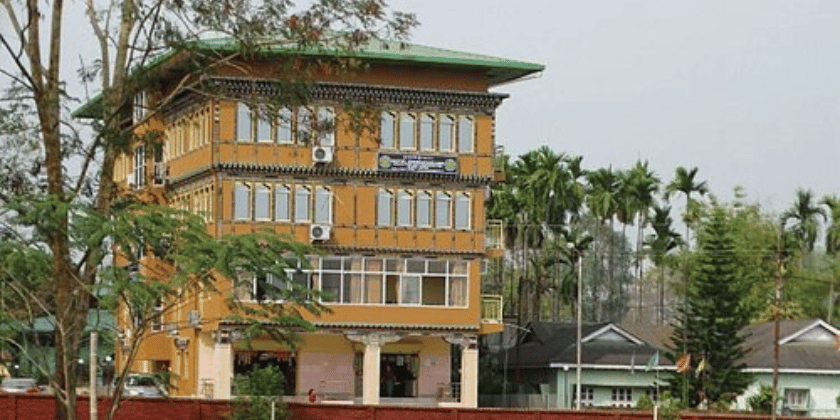
Must-Visit Places:
- Royal Manas National Park: Located around 60 kilometers away from Gelephu, the Royal Manas National Park is a must-visit place for nature lovers. The park is home to an abundance of wildlife, including tigers, elephants, and Indian rhinoceros.
- Sarpang Dzong: The Sarpang Dzong is a fortress located in the Sarpang district, around 25 kilometers away from Gelephu. The dzong is an impressive architectural marvel, and it offers a glimpse into Bhutan’s rich history.
- Zangdo Pelri Lhakhang: The Zangdo Pelri Lhakhang is a Buddhist temple located in Gelephu town. The temple is known for its ornate architecture and beautiful murals, and it is an important religious site for the locals.
- Gelephu Saturday Market: The Gelephu Saturday Market is a vibrant marketplace where tourists can experience the local culture and buy handicrafts, fresh produce, and other local goods.
Main Activities for Tourists:
- Wildlife Safaris: Gelephu is an excellent destination for wildlife safaris, and tourists can explore the Royal Manas National Park and other nearby reserves.
- Trekking: The hills surrounding Gelephu offer excellent opportunities for trekking, with several trails offering stunning views of the surrounding landscape.
- Cultural Tours: Gelephu is a great destination for cultural tours, with several important religious sites and historical landmarks to explore.
Cuisine: The food in Gelephu is a unique blend of Bhutanese and Indian cuisine, reflecting the town’s proximity to the Indian border. Tourists can try local delicacies like Ema Datshi (a spicy cheese and chili dish), Momos (steamed dumplings), and Phaksha Paa (pork curry).
Accommodation: Gelephu offers a range of accommodation options for tourists, including budget guesthouses and luxury hotels. Some popular options include the Gelephu Central Hotel, the Riverfront Lodge, and the Pelri Cottages.
Weather and Best Time to Visit: The weather in Gelephu is tropical and humid, with temperatures ranging from 25°C to 35°C throughout the year. The best time to visit Gelephu is from October to December when the weather is cooler and drier, making it more comfortable for outdoor activities.
How to Reach: The easiest way to reach Gelephu is by road from the capital city of Thimphu. It is a long drive of around 10 hours, but the scenic journey is worth it. Tourists can also fly into the nearby town of Guwahati in India and then take a taxi or bus to Gelephu.
- Paro Taktsang (Tiger’s Nest) Monastery
Paro Taktsang Monastery, commonly known as Tiger’s Nest, is one of the most iconic and awe-inspiring places to visit in Bhutan. Nestled on a cliff at an altitude of 3,120 meters, the monastery offers stunning views of the Paro Valley and is considered a must-visit destination for any tourist traveling to Bhutan.
As a tourist visiting Tiger’s Nest, the journey to the monastery begins with a hike through the mountains. The trailhead is located about 10 kilometers north of Paro town, and visitors can choose to either hike or ride a horse up to the monastery. While the horse ride can be convenient for those who are not used to hiking or have mobility issues, the hike itself is a rewarding experience that allows visitors to fully immerse themselves in the natural beauty of Bhutan.
The hike to Tiger’s Nest takes about two to three hours, depending on one’s physical condition and pace. The trail is steep and rocky in some places, but it is well-maintained and offers stunning views of the valley below. As visitors climb higher, they can see the monastery perched on the cliff in the distance, creating a sense of anticipation and excitement for what’s to come.
Upon reaching the monastery, visitors are greeted with a stunning sight. The monastery is built into the cliffside and features four main temples and several smaller buildings. The intricate architectural details and colorful decorations add to the grandeur of the structure, making it an unforgettable sight.
Inside the monastery, visitors can explore the different temples and learn about the history and significance of each one. One of the most famous temples is the Guru Rinpoche (Padmasambhava) Temple, which is said to be the spot where Guru Rinpoche meditated for several months in the 8th century. The temple is adorned with beautiful murals and statues, and visitors can feel the sense of peace and spirituality that permeates the space.
One of the most unique experiences of visiting Tiger’s Nest is the chance to witness the daily life of the monks who live and work at the monastery. Visitors can observe the monks as they perform their daily rituals, including chanting and meditation. The peaceful and serene atmosphere of the monastery is a stark contrast to the hustle and bustle of everyday life, and visitors can’t help but feel a sense of calm and serenity while in this holy place.
After exploring the monastery, visitors can take in the breathtaking views from the balcony that overlooks the valley. The view is nothing short of spectacular, and it’s easy to see why Tiger’s Nest is such an iconic and beloved destination in Bhutan.
In conclusion, a visit to Paro Taktsang Monastery (Tiger’s Nest) is an unforgettable experience that every tourist should make a priority when visiting Bhutan. From the breathtaking views to the spiritual and peaceful atmosphere of the monastery, it is a destination that is sure to leave a lasting impression on anyone lucky enough to visit. The hike to the monastery is challenging but rewarding, and the experience of exploring the temple and observing the daily life of the monks is one that will stay with visitors long after they leave.
- Punakha Dzong
Punakha Dzong, also known as Pungtang Dewa chhenbi Phodrang, is one of the most iconic and historic landmarks in Bhutan. As a tourist visiting Punakha Dzong, one is immediately struck by the grandeur and beauty of the structure, which stands majestically at the confluence of two rivers – the Pho Chhu (male river) and Mo Chhu (female river).
The journey to Punakha Dzong takes visitors through scenic landscapes, dotted with traditional Bhutanese houses and rice paddies. As one approaches the dzong, the sight of the towering white walls and golden roofs is breathtaking, and it’s easy to see why Punakha Dzong is considered one of the most beautiful dzongs in Bhutan.
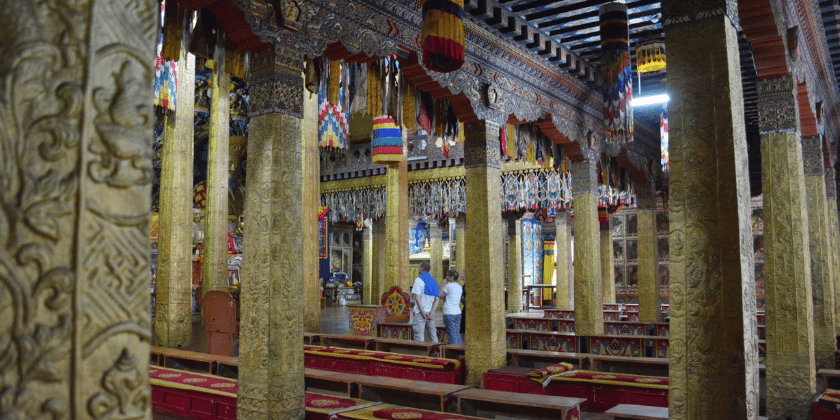
Upon entering the dzong, visitors are transported back in time, as they walk through the intricate courtyards and passageways of the ancient structure. The architecture of Punakha Dzong is a remarkable fusion of Bhutanese and Tibetan styles, with intricate carvings and artwork adorning the walls and pillars.
One of the highlights of a visit to Punakha Dzong is the opportunity to witness the daily life of the monks who reside within its walls. Visitors can observe the monks as they go about their daily routines, which include chanting, meditating, and performing various religious rituals. The peaceful and serene atmosphere of the dzong is truly captivating, and it’s easy to see why it is considered a sacred and holy place in Bhutan.
Another notable feature of Punakha Dzong is the stunning prayer hall, which houses a large statue of Buddha and is adorned with beautiful frescoes and murals depicting scenes from Buddhist mythology. The prayer hall is a peaceful and contemplative space, and visitors can’t help but feel a sense of spirituality and reverence while inside.
Beyond its religious significance, Punakha Dzong also played an important role in Bhutan’s history. It was here that the first king of Bhutan was crowned in 1907, and it continues to serve as the winter residence of the Je Khenpo (the Chief Abbot of Bhutan).
In addition to its cultural and historical significance, Punakha Dzong also offers stunning views of the surrounding landscape. The dzong is situated at the confluence of two rivers, and visitors can take in the beauty of the rivers and the surrounding mountains from the dzong’s observation deck.
In conclusion, a visit to Punakha Dzong is a must for any tourist visiting Bhutan. From the grandeur and beauty of the structure to the spirituality and serenity of the monks who reside within its walls, it is a destination that offers a unique and unforgettable experience. The fusion of Bhutanese and Tibetan architecture, the stunning frescoes and murals, and the rich history and culture of the dzong all come together to make it a truly remarkable and awe-inspiring destination.
- Thimphu Memorial Chorten
The Thimphu Memorial Chorten is a stunning and significant landmark in the heart of Bhutan’s capital city, Thimphu. As a tourist visiting the chorten, one is immediately struck by its grandeur and beauty, as well as the peaceful and serene atmosphere that surrounds it.
The chorten was built in 1974 in memory of the third king of Bhutan, Jigme Dorji Wangchuck, who was instrumental in ushering in modernization and development in the country. The chorten is a popular destination for locals and tourists alike, who come to offer their prayers and seek blessings.
As one approaches the chorten, the first thing that catches the eye is its striking white exterior and the golden spires that rise up into the sky. The chorten’s unique design combines traditional Bhutanese architecture with modern elements, and its intricate carvings and artwork are a testament to the country’s rich cultural heritage.
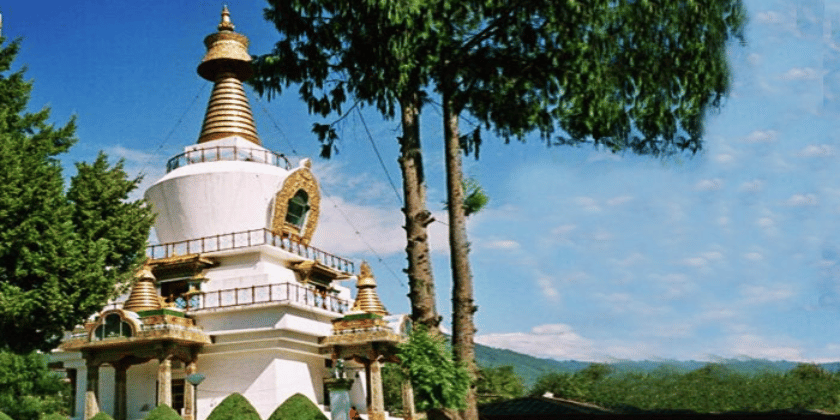
Upon entering the chorten, visitors are greeted by a serene and tranquil atmosphere, as they walk around the circular corridor that surrounds the inner sanctum. The walls of the corridor are adorned with beautiful frescoes and paintings depicting scenes from the life of Buddha, as well as important events in Bhutanese history.
The inner sanctum of the chorten houses a large golden statue of Buddha, surrounded by offerings of flowers and prayer flags. Visitors are welcome to offer their prayers and circumambulate the statue, as they soak in the peaceful and meditative atmosphere of the chorten.
One of the highlights of a visit to the Thimphu Memorial Chorten is the opportunity to witness the daily life of the Bhutanese people, as they come to the chorten to offer their prayers and seek blessings. It’s a fascinating glimpse into the country’s culture and traditions, and visitors can’t help but feel a sense of reverence and awe in the presence of so much devotion and faith.
Beyond its religious significance, the Thimphu Memorial Chorten also serves as a community center and a hub for social gatherings and events. Locals can often be seen sitting and chatting outside the chorten, enjoying the peaceful surroundings and the company of friends and family.
In conclusion, a visit to the Thimphu Memorial Chorten is a must for any tourist visiting Bhutan. From its striking white exterior to its intricate carvings and artwork, it is a destination that offers a unique and unforgettable experience. The peaceful and serene atmosphere, the fascinating glimpse into Bhutanese culture and traditions, and the opportunity to witness the daily life of the Bhutanese people all come together to make it a truly remarkable and awe-inspiring destination.
- Buddha Dordenma Statue
The Buddha Dordenma Statue is one of the most iconic and impressive landmarks in Bhutan’s capital city, Thimphu. As a tourist visiting the statue, one is immediately struck by its immense size, stunning beauty, and the sense of peace and serenity that surrounds it.
The statue, which was completed in 2015, stands at an impressive 169 feet tall, making it one of the largest Buddha statues in the world. It is made of bronze and gold and is gilded with 125,000 smaller Buddha statues that were placed inside the larger statue. The Buddha Dordenma is located on a hill overlooking the Thimphu Valley, making it a popular destination for both locals and tourists alike.
As one approaches the statue, the first thing that catches the eye is its sheer size and grandeur. The statue is visible from all parts of Thimphu, and its striking golden exterior seems to glow in the sunlight. Visitors can reach the statue by climbing a flight of stairs that leads up to the base, where they can take in the sweeping views of the valley below.
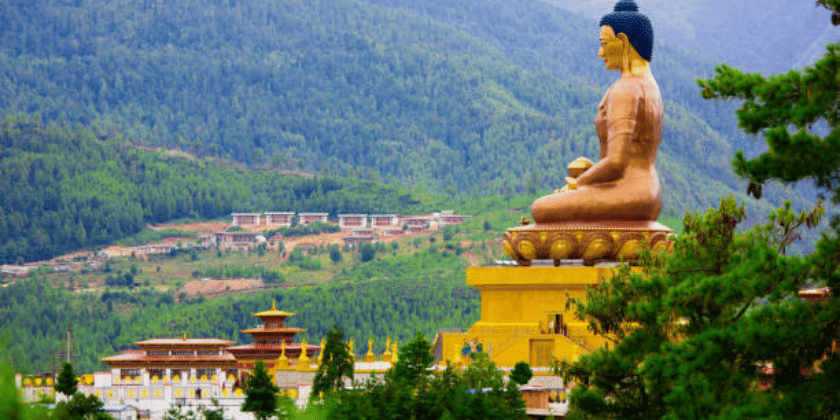
Upon entering the statue, visitors are greeted by a serene and peaceful atmosphere, as they walk around the circular corridor that surrounds the inner sanctum. The walls of the corridor are adorned with beautiful frescoes and paintings depicting scenes from the life of Buddha, as well as important events in Bhutanese history.
The inner sanctum of the Buddha Dordenma houses a large golden statue of Buddha, surrounded by offerings of flowers and prayer flags. Visitors are welcome to offer their prayers and circumambulate the statue, as they soak in the peaceful and meditative atmosphere of the statue.
One of the highlights of a visit to the Buddha Dordenma Statue is the opportunity to witness the daily life of the Bhutanese people, as they come to the statue to offer their prayers and seek blessings. It’s a fascinating glimpse into the country’s culture and traditions, and visitors can’t help but feel a sense of reverence and awe in the presence of so much devotion and faith.
Beyond its religious significance, the Buddha Dordenma Statue also serves as a symbol of Bhutan’s commitment to preserving its cultural heritage and traditions. The statue was built as part of the government’s efforts to promote spiritual well-being and to celebrate the 60th anniversary of the fourth king’s reign.
In conclusion, a visit to the Buddha Dordenma Statue is a must for any tourist visiting Bhutan. From its immense size and stunning beauty to the peaceful and meditative atmosphere that surrounds it, it is a destination that offers a unique and unforgettable experience. The opportunity to witness the daily life of the Bhutanese people, to take in the sweeping views of the Thimphu Valley, and to soak in the spiritual and cultural significance of the statue all come together to make it a truly remarkable and awe-inspiring destination.
- Dochula Pass
Nestled in the heart of the Himalayan Mountains, the Dochula Pass is a must-visit destination for any tourist exploring Bhutan. The pass sits at an altitude of 3,100 meters above sea level and is located on the road that connects Thimphu to Punakha. As a visitor to the pass, one is immediately struck by the stunning natural beauty, serene atmosphere, and fascinating history that surrounds it.
One of the highlights of a visit to Dochula Pass is the panoramic view of the Himalayan Mountains that it offers. On a clear day, visitors can see up to 13 of the highest peaks in Bhutan, including the majestic Gangkhar Puensum, which is the highest unclimbed peak in the world. The view from the pass is simply breathtaking and is a testament to the natural beauty that Bhutan is known for.
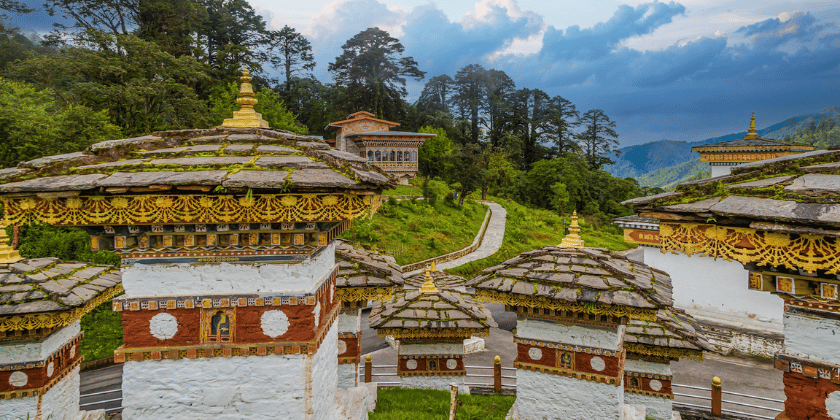
Another attraction at Dochula Pass is the 108 chortens or stupas that are built in three tiers. These chortens were built by the Queen Mother to honor the soldiers who lost their lives in the battle against Assamese insurgents in 2003. The chortens are a beautiful and poignant reminder of the sacrifices that the Bhutanese people have made to protect their country.
In addition to the chortens, there is also a temple at the pass called the Druk Wangyal Lhakhang. This temple was built in honor of the fourth king of Bhutan and serves as a place of worship for the locals. The temple is also home to a collection of beautiful murals and paintings that depict scenes from Bhutanese mythology and history.
For those interested in hiking and outdoor activities, the Dochula Pass offers several opportunities to explore the surrounding mountains and valleys. The pass is surrounded by lush green forests and scenic hiking trails that are perfect for a day trip. The trails are well-marked, and visitors can hire a local guide to lead them through the area.
Beyond its natural beauty and cultural significance, Dochula Pass is also an important landmark in Bhutan’s history. The pass was once used by invading armies to enter the country, and it was the site of many historic battles. Today, the pass stands as a symbol of Bhutan’s strength and resilience in the face of adversity.
In conclusion, a visit to Dochula Pass is a must for any tourist exploring Bhutan. From its stunning views of the Himalayan Mountains and the beautiful chortens to the cultural significance and fascinating history that surrounds it, there is something for everyone to enjoy. Whether you are interested in hiking and outdoor activities or simply soaking in the natural beauty and peaceful atmosphere, Dochula Pass is an unforgettable destination that will leave you with lasting memories of your time in Bhutan.
- Gangtey Valley
Nestled in the heart of the Himalayan Mountains, the Gangtey Valley is a hidden gem of Bhutan that offers a serene and peaceful escape from the hustle and bustle of modern life. The valley is located in the district of Wangdue Phodrang, and is home to one of the most beautiful and important wildlife reserves in the country.
As a tourist visiting the Gangtey Valley, one is immediately struck by the stunning natural beauty that surrounds it. The valley is located at an altitude of 3,000 meters above sea level and is surrounded by majestic mountains and lush green forests. The valley is also home to the Black-Necked Crane, an endangered species that is revered by the Bhutanese people.
One of the highlights of a visit to the Gangtey Valley is the Gangtey Monastery. This historic monastery was built in the 17th century and is one of the most important religious sites in Bhutan. The monastery is perched on a hill overlooking the valley, and offers stunning views of the surrounding mountains and forests.
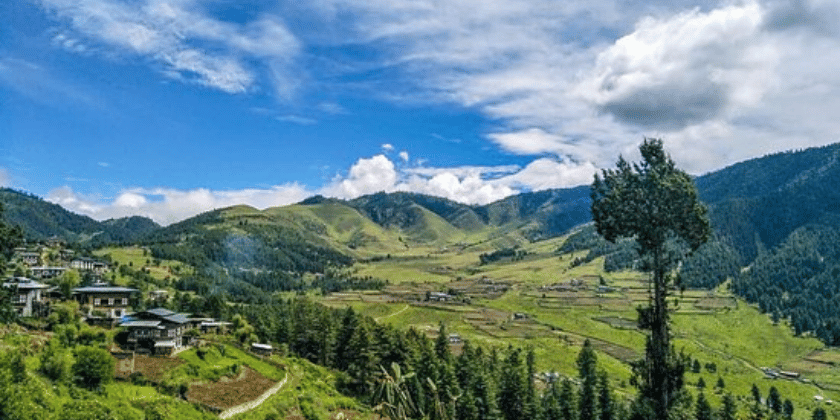
Visitors to the Gangtey Monastery can also take part in various cultural activities such as traditional Bhutanese dances and rituals. The monks at the monastery are known for their warm hospitality and are happy to share their culture and traditions with visitors.
Another attraction in the Gangtey Valley is the Gangtey Nature Trail. This scenic trail takes visitors through the valley, past pristine forests, tranquil lakes, and traditional Bhutanese villages. Along the way, visitors can observe the Black-Necked Cranes in their natural habitat and learn about the importance of conservation efforts to protect these majestic birds.
For those interested in outdoor activities, the Gangtey Valley offers plenty of opportunities for hiking, camping, and exploring the surrounding mountains and valleys. The valley is also a popular destination for birdwatching, with over 450 species of birds recorded in the area.
In addition to its natural beauty and cultural significance, the Gangtey Valley is also known for its warm and welcoming people. The locals are proud of their heritage and are happy to share their customs and traditions with visitors. From traditional Bhutanese meals to lively festivals and celebrations, the people of Gangtey Valley offer a glimpse into the rich and vibrant culture of Bhutan.
In conclusion, a visit to Gangtey Valley is a must for any tourist exploring Bhutan. From its stunning natural beauty and cultural significance to the warm hospitality of the locals and the unique wildlife conservation efforts, there is something for everyone to enjoy. Whether you are interested in outdoor activities or simply soaking in the peaceful atmosphere and immersing yourself in the local culture, Gangtey Valley is an unforgettable destination that will leave you with lasting memories of your time in Bhutan.
- Jigme Dorji National Park
As one of the largest national parks in Bhutan, Jigme Dorji National Park is a natural wonderland that offers visitors a chance to experience the country’s unique flora and fauna up close. Named after the third king of Bhutan, the park covers over 4,300 square kilometers and is home to an incredible variety of wildlife and landscapes.
As a tourist visiting Jigme Dorji National Park, one is immediately struck by the stunning beauty of the park’s forests, rivers, and mountains. The park is located in the western part of Bhutan and covers an area that ranges from sub-tropical to alpine. The park’s diverse landscapes offer visitors a chance to explore everything from lush jungles to snow-capped peaks.
One of the main attractions of Jigme Dorji National Park is its incredible wildlife. The park is home to over 40 species of mammals, including tigers, snow leopards, and the elusive Himalayan black bear. The park is also home to several endangered species, such as the clouded leopard, the Asiatic wild dog, and the takin, Bhutan’s national animal.
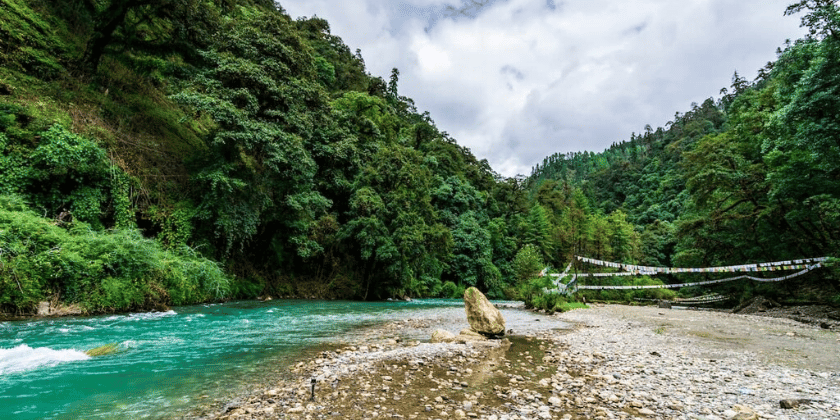
Visitors to Jigme Dorji National Park can explore the park on foot or on horseback, with several well-marked trails winding through the park’s forests and valleys. The park is also a popular destination for birdwatchers, with over 300 species of birds recorded in the area.
One of the highlights of a visit to Jigme Dorji National Park is the opportunity to learn about Bhutan’s unique conservation efforts. The park is home to several programs that work to protect the park’s wildlife and ecosystems, including anti-poaching initiatives and reforestation projects. Visitors can learn about these programs and the challenges facing conservation efforts in Bhutan.
Another attraction in Jigme Dorji National Park is the picturesque Phobjikha Valley. This stunning valley is home to several traditional Bhutanese villages and offers visitors a chance to experience rural Bhutanese life. The valley is also home to the endangered black-necked crane, which migrates to the valley each winter.
For those interested in history and culture, Jigme Dorji National Park is home to several historic sites, including the ruins of the Wangduecholing Palace and the Lhuentse Dzong. Visitors can explore these sites and learn about Bhutan’s rich history and cultural heritage.
In conclusion, a visit to Jigme Dorji National Park is a must for any tourist exploring Bhutan. From its stunning natural beauty and unique wildlife to its important conservation efforts and rich cultural heritage, there is something for everyone to enjoy. Whether you are interested in outdoor activities or simply immersing yourself in the local culture and learning about Bhutan’s conservation efforts, Jigme Dorji National Park is an unforgettable destination that will leave you with lasting memories of your time in Bhutan.
- Wangdue Phodrang Dzong
Nestled in the heart of the Punakha Valley, Wangdue Phodrang Dzong is a must-visit destination for any tourist exploring Bhutan. Built in 1638, the dzong is a stunning example of traditional Bhutanese architecture and is a testament to the country’s rich cultural heritage.
As a tourist visiting Wangdue Phodrang Dzong, one is immediately struck by the dzong’s imposing size and the intricate details of its construction. The dzong sits on a ridge overlooking the Punakha River and offers stunning views of the surrounding valley. The dzong is a maze of courtyards, temples, and administrative buildings, all adorned with traditional Bhutanese artwork and architecture.
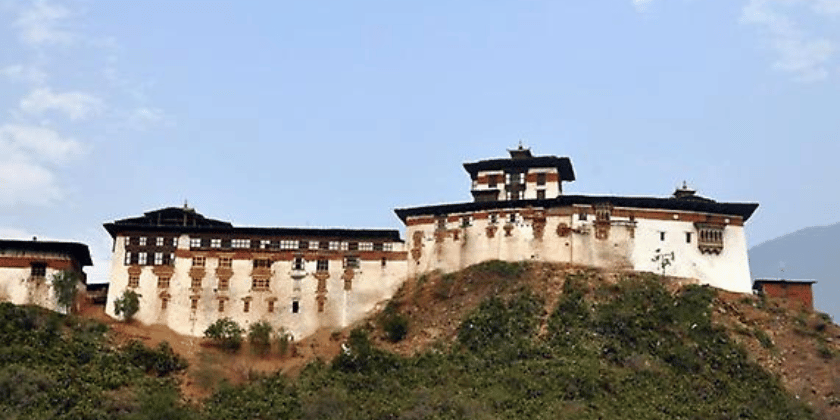
One of the main attractions of Wangdue Phodrang Dzong is its historic significance. The dzong served as the administrative center of the Wangdue Phodrang district for over 350 years and played a crucial role in the region’s political and cultural development. Visitors can explore the dzong’s many temples and administrative buildings, each of which tells a unique story about Bhutan’s rich history.
Another highlight of a visit to Wangdue Phodrang Dzong is the opportunity to witness traditional Bhutanese festivals and ceremonies. The dzong is a hub of cultural activity and plays host to several important festivals throughout the year. Visitors can witness traditional dance performances and ceremonies, sample local cuisine, and learn about the dzong’s importance to the local community.
For those interested in art and architecture, Wangdue Phodrang Dzong is a treasure trove of traditional Bhutanese craftsmanship. The dzong’s courtyards and temples are adorned with intricate carvings, paintings, and sculptures, all created by skilled Bhutanese artisans. Visitors can admire these works of art and learn about the techniques and traditions used to create them.
In addition to its cultural and historic significance, Wangdue Phodrang Dzong is also a hub of community activity. The dzong serves as a meeting place for local officials, religious leaders, and community members and plays an important role in the social and cultural life of the region. Visitors can witness this community spirit firsthand and learn about the role of the dzong in Bhutanese society.
In conclusion, a visit to Wangdue Phodrang Dzong is a must for any tourist exploring Bhutan. From its stunning architecture and intricate artwork to its cultural and historic significance, the dzong offers visitors a unique insight into Bhutanese culture and heritage. Whether you are interested in history, art, architecture, or simply immersing yourself in the local community, Wangdue Phodrang Dzong is an unforgettable destination that will leave you with lasting memories of your time in Bhutan.
- Chele La Pass
Chele La Pass is a high mountain pass located in the Haa Valley region of Bhutan. At an elevation of 3,988 meters (13,084 feet), it is one of the highest passes in the country and offers breathtaking views of the surrounding landscape. As a tourist visiting Bhutan, a trip to Chele La Pass is a must-do experience.
The journey to Chele La Pass is an adventure in itself. Visitors can either drive or hike to the pass, both of which offer their own unique experiences. The road to the pass is narrow and winding, offering stunning views of the Haa Valley and its surrounding mountains. The drive can be challenging for those who are not used to driving on mountainous roads, but the views are worth it.
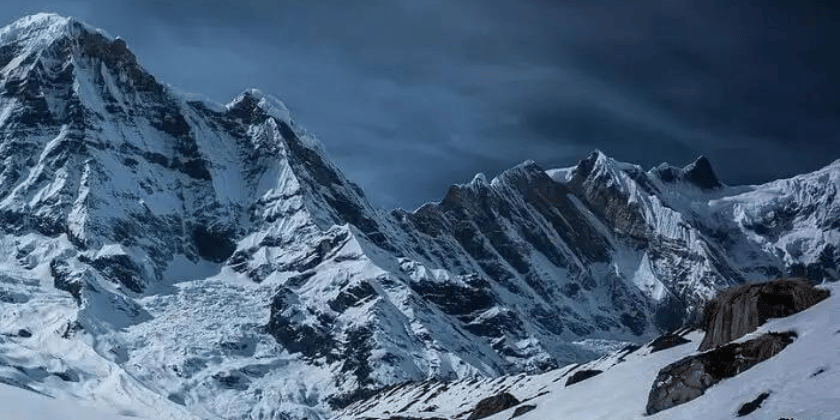
For those who prefer to hike, the trail to Chele La Pass is a moderate to challenging trek that takes approximately four hours. The trail winds through lush forests, past mountain streams and waterfalls, and offers stunning views of the surrounding landscape. Hikers should be prepared for the altitude and should bring appropriate gear and supplies.
At the top of Chele La Pass, visitors are rewarded with panoramic views of the Haa Valley and its surrounding peaks. On a clear day, it is possible to see as far as the Himalayas in the distance. The pass is also home to several prayer flags and chortens, which add to the spiritual atmosphere of the area.
In addition to its natural beauty, Chele La Pass is also home to several species of wildlife. Visitors may have the opportunity to spot yaks, musk deer, and Himalayan black bears, among other animals. Bird watchers will also be delighted by the abundance of birdlife in the area.
Chele La Pass is also an important cultural site in Bhutan. It is home to several monasteries and temples, including Kila Gompa, a monastery that is dedicated to the protection of Bhutan’s wildlife. Visitors can explore these cultural sites and learn about the importance of Buddhism and wildlife conservation in Bhutan.
In conclusion, a visit to Chele La Pass is a must for any tourist visiting Bhutan. From its stunning natural beauty and abundant wildlife to its cultural significance, the pass offers visitors a unique insight into Bhutanese culture and heritage. Whether you choose to drive or hike to the pass, the journey is an adventure in itself, and the views from the top are truly breathtaking. Chele La Pass is a destination that will leave you with lasting memories of your time in Bhutan.
- Rinpung Dzong
Rinpung Dzong, also known as Paro Dzong, is a fortress and Buddhist monastery located in the Paro Valley of Bhutan. As a tourist visiting Bhutan, a trip to Rinpung Dzong is a must-do experience that offers a glimpse into the country’s rich history and culture.
The first thing that visitors to Rinpung Dzong will notice is its impressive size and architecture. The fortress is made up of several buildings and towers that are surrounded by a large wall. The walls and towers are adorned with intricate carvings and paintings that depict Buddhist teachings and historical events.
Upon entering the dzong, visitors will be greeted by a large courtyard that leads to the main prayer hall. The prayer hall is a magnificent room that is decorated with elaborate paintings and sculptures of Buddhist deities. The room is also home to a large golden statue of Buddha that is said to be one of the largest in Bhutan.
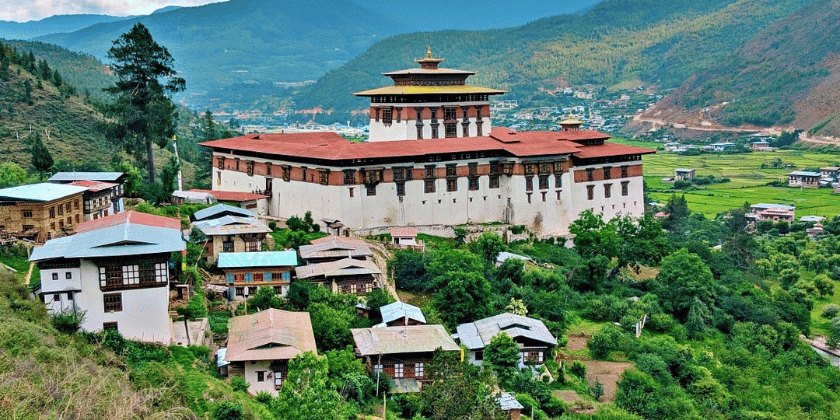
One of the most impressive features of Rinpung Dzong is its stunning wall paintings, which cover the walls of many of the dzong’s buildings. The paintings depict scenes from Buddhist mythology and history, and are considered to be some of the finest examples of Bhutanese art.
In addition to its cultural and historical significance, Rinpung Dzong is also an important religious site in Bhutan. It is home to several monks who live and study within the dzong’s walls, and visitors may have the opportunity to witness their daily rituals and prayers.
Visitors to Rinpung Dzong can also explore the dzong’s museum, which is home to a collection of Bhutanese art and artifacts. The museum offers visitors a unique insight into Bhutanese history and culture, and is a must-visit for anyone interested in learning more about the country’s rich heritage.
Overall, a visit to Rinpung Dzong is a must for any tourist visiting Bhutan. From its stunning architecture and intricate wall paintings to its cultural and religious significance, the dzong offers visitors a unique glimpse into the country’s rich history and culture. Whether you’re a history buff, an art lover, or simply looking to immerse yourself in Bhutanese culture, a trip to Rinpung Dzong is an unforgettable experience that will leave you with lasting memories of your time in Bhutan.
- Phobjikha Valley
Phobjikha Valley, also known as Gangtey Valley, is a scenic valley located in central Bhutan. As a tourist visiting Bhutan, a trip to Phobjikha Valley is a must-do experience that offers a glimpse into the country’s natural beauty and rich cultural heritage.
The valley is home to the Black-necked Cranes, a migratory bird species that are considered to be sacred in Bhutanese culture. The cranes typically arrive in Phobjikha Valley in November and stay until March, making the valley a popular destination for bird watchers and nature enthusiasts during the winter months.
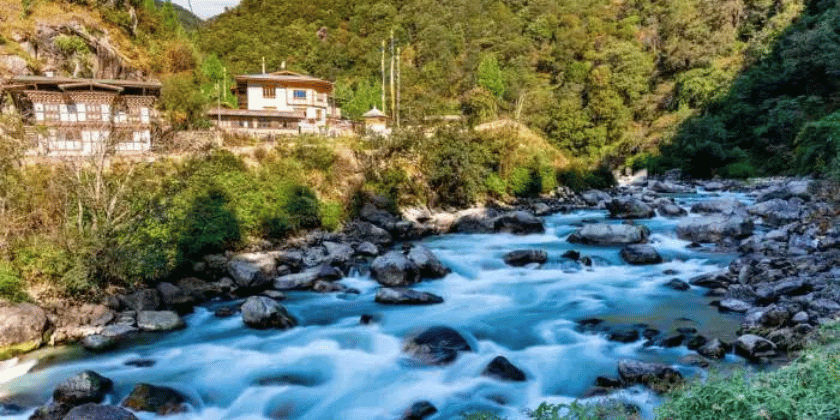
In addition to its natural beauty and wildlife, Phobjikha Valley is also home to several important cultural sites. The valley is home to the Gangtey Monastery, one of the largest and most important monasteries in Bhutan. The monastery is a stunning example of Bhutanese architecture, with its white-washed walls, red roof tiles, and intricate carvings and paintings.
Visitors to Phobjikha Valley can also explore the surrounding countryside on foot or on horseback. The valley is home to several scenic hiking trails that offer breathtaking views of the surrounding mountains and forests. Horseback riding is also a popular activity in the valley, with several local tour companies offering guided tours.
For those interested in learning more about Bhutanese culture and history, a visit to one of the valley’s traditional villages is a must-do experience. These villages offer a glimpse into rural Bhutanese life, with traditional houses and farming practices that have remained largely unchanged for centuries.
One of the most unique experiences available in Phobjikha Valley is the opportunity to participate in a homestay program. Visitors can stay with a local family in their traditional home, experiencing the daily rhythms of rural Bhutanese life and learning about the country’s rich cultural heritage firsthand.
Overall, a visit to Phobjikha Valley is a must for any tourist visiting Bhutan. From its natural beauty and wildlife to its rich cultural heritage and rural way of life, the valley offers visitors a unique and unforgettable experience that will leave them with lasting memories of their time in Bhutan. Whether you’re a nature lover, a culture enthusiast, or simply looking to immerse yourself in the beauty of Bhutan, a trip to Phobjikha Valley is an experience that should not be missed.
- Bumthang Valley
Bumthang Valley is a stunning region located in central Bhutan, offering visitors a unique glimpse into the country’s rich cultural heritage and natural beauty. As a tourist visiting Bhutan, a trip to Bumthang Valley is a must-do experience that offers a perfect blend of adventure, culture, and spirituality.
The valley is home to several important cultural sites, including the Jakar Dzong, one of the largest and most impressive fortresses in Bhutan. The dzong is a stunning example of Bhutanese architecture, with its towering walls, intricate carvings, and sweeping views of the surrounding countryside. Visitors to the dzong can explore its many courtyards, temples, and administrative buildings, learning about the history and culture of Bhutan along the way.
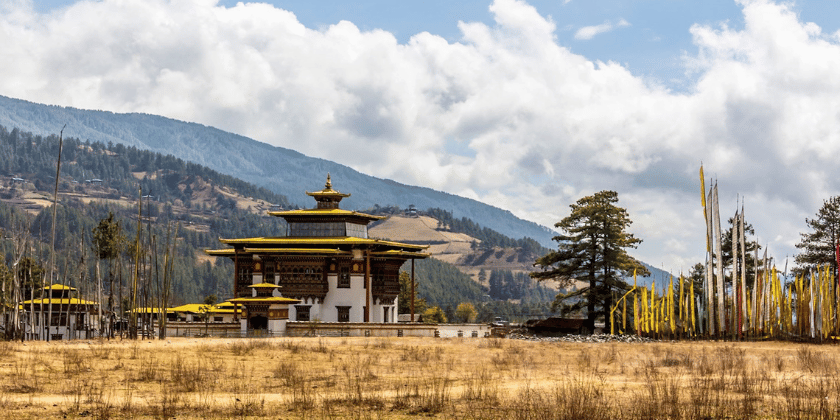
In addition to the dzong, Bumthang Valley is also home to several important Buddhist temples and monasteries, including the Jambay Lhakhang, Kurjey Lhakhang, and Tamshing Lhakhang. These temples and monasteries are important pilgrimage sites for Bhutanese Buddhists, and offer visitors a chance to witness the country’s rich spiritual heritage firsthand.
For those interested in exploring the valley’s natural beauty, there are several scenic hiking trails that wind through the surrounding forests and mountains. These trails offer breathtaking views of the valley below, as well as a chance to spot local wildlife such as deer, monkeys, and rare bird species.
One of the most unique experiences available in Bumthang Valley is the opportunity to witness a traditional Bhutanese festival, or tsechu. These festivals are held throughout the year in various locations across Bhutan, and are a celebration of the country’s rich cultural heritage and spiritual traditions. The tsechus typically involve colorful dances and performances by masked performers, as well as religious ceremonies and offerings.
For those looking for a more immersive cultural experience, a homestay program is also available in Bumthang Valley. Visitors can stay with a local family in their traditional home, learning about the daily rhythms of rural Bhutanese life and experiencing the country’s unique culture and hospitality firsthand.
Overall, a visit to Bumthang Valley is a must for any tourist visiting Bhutan. With its stunning natural beauty, rich cultural heritage, and spiritual significance, the valley offers visitors a chance to experience the best of what Bhutan has to offer. Whether you’re a nature lover, culture enthusiast, or simply seeking adventure and spiritual renewal, a trip to Bumthang Valley is an experience that should not be missed.
- Chomolhari Trek
The Chomolhari Trek is one of the most popular trekking routes in Bhutan, offering visitors an unforgettable experience of the country’s stunning natural beauty and cultural heritage. As a tourist visiting Bhutan, embarking on this trek is an excellent way to experience the country’s unique landscape and culture up close.
The Chomolhari Trek typically takes around eight to ten days to complete, and covers a distance of approximately 120 kilometers. The trek begins in Paro, where visitors will have the opportunity to visit the iconic Tiger’s Nest monastery before setting off on their adventure. From there, the route takes trekkers through a variety of landscapes, including lush forests, rocky mountain passes, and pristine alpine lakes.
One of the highlights of the Chomolhari Trek is the stunning views of the Himalayan mountain range, which includes some of the tallest peaks in the world. The trek passes through several high-altitude mountain passes, offering visitors breathtaking views of the snow-capped peaks and valleys below.
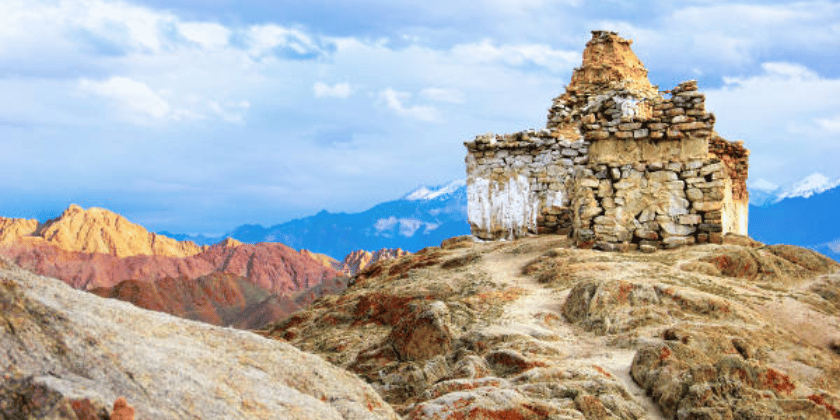
The Chomolhari Trek also takes visitors through several remote villages, where they can experience the unique culture and hospitality of Bhutanese people. The villages along the trekking route are typically small and isolated, and visitors will have the opportunity to interact with locals, learn about their way of life, and sample traditional Bhutanese food.
Another highlight of the Chomolhari Trek is the opportunity to witness Bhutan’s rich Buddhist heritage up close. The trek passes through several important Buddhist temples and monasteries, including the Jele Dzong and the famous Tshophu Lake, which is considered a sacred site by the local people.
The Chomolhari Trek is a challenging but rewarding experience, and is suitable for experienced hikers with a good level of fitness. The trek requires several days of walking at high altitudes, and visitors should be prepared for steep ascents and descents, as well as potential weather changes.
Overall, the Chomolhari Trek is an unforgettable experience that offers visitors a unique glimpse into Bhutan’s stunning natural beauty and rich cultural heritage. For tourists seeking adventure, spiritual renewal, and a deeper understanding of Bhutanese culture, the Chomolhari Trek is an experience that should not be missed.
- Haa Valley
Haa Valley, located in the western part of Bhutan, is a beautiful and remote destination that offers visitors a unique glimpse into traditional Bhutanese life and culture. As a tourist visiting Bhutan, exploring Haa Valley is an excellent way to experience the country’s rural landscape, customs, and traditions.
The Haa Valley is situated at an altitude of 2,700 meters above sea level and is surrounded by stunning Himalayan mountains. Visitors to Haa can enjoy the breathtaking scenery, which includes rolling hills, lush forests, and pristine alpine lakes. The valley is also known for its unique architecture, with traditional Bhutanese houses and temples dotting the landscape.
One of the highlights of a trip to Haa Valley is the opportunity to experience the local culture and customs up close. The valley is home to a small population of ethnic Haa people, who have maintained their traditional way of life for centuries. Visitors can participate in local festivals, sample traditional cuisine, and visit ancient temples and monasteries.
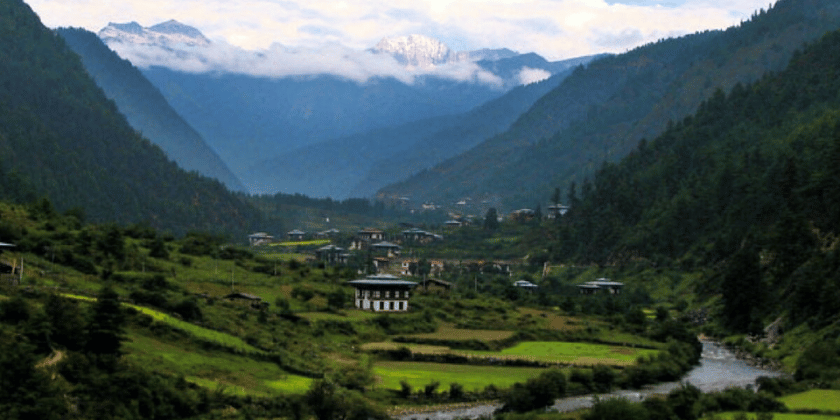
One of the most famous attractions in Haa Valley is the Lhakhang Karpo and Lhakhang Nagpo, two ancient temples that date back to the 7th century. The temples are considered sacred sites by the local people and are an important pilgrimage destination for Bhutanese Buddhists.
In addition to its cultural attractions, Haa Valley is also a great destination for outdoor enthusiasts. The valley is surrounded by pristine forests and is home to a variety of wildlife, including the endangered black-necked crane. Visitors can enjoy hiking, camping, and bird watching in the valley and surrounding areas.
One of the best times to visit Haa Valley is during the Haa Summer Festival, which takes place every year in July. The festival is a celebration of traditional Bhutanese culture and includes performances of music and dance, local food and crafts, and traditional sports such as archery and darts.
In conclusion, Haa Valley is a must-visit destination for tourists seeking an authentic Bhutanese experience. The valley’s stunning scenery, rich cultural heritage, and outdoor activities make it an ideal destination for travelers looking to escape the crowds and explore the remote corners of this beautiful country.
- Trongsa Dzong
Trongsa Dzong is a majestic fortress located in the town of Trongsa in central Bhutan. This imposing structure is not only an architectural wonder but also holds immense historical and cultural significance for the people of Bhutan. As a tourist visiting Bhutan, a visit to Trongsa Dzong is an absolute must to witness the beauty of Bhutanese architecture and learn about the country’s rich history.
Trongsa Dzong, also known as Chokhor Raptse Dzong, was built in 1648 by Chogyal Minjur Tempa. It is considered one of the largest dzongs in Bhutan and served as the seat of power for the rulers of Trongsa for over 300 years. The dzong is strategically located at the confluence of two rivers, and its impressive architecture and strategic location made it a crucial fortress for protecting Bhutan from invading forces.
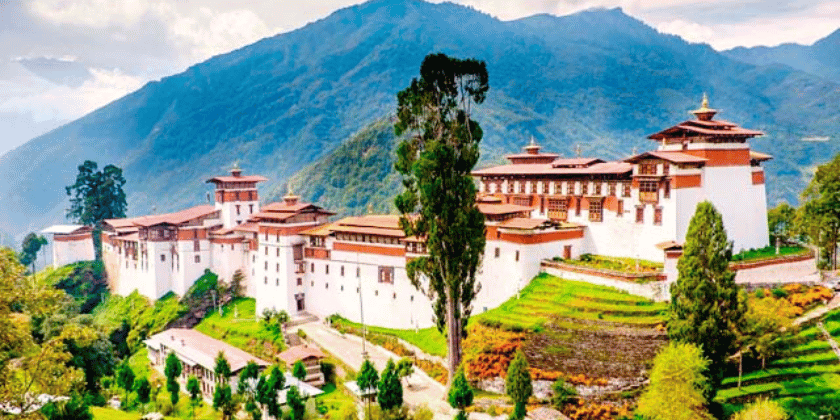
As a tourist, exploring the Trongsa Dzong is a fascinating experience. The dzong’s impressive architecture is a perfect example of traditional Bhutanese design, with intricately carved wooden beams, painted walls, and large courtyards. Visitors can walk through the various sections of the dzong, including the monastic quarters, administrative offices, and the watchtower, to get a sense of its historical and cultural significance.
One of the highlights of visiting Trongsa Dzong is the opportunity to witness the annual Trongsa Tsechu festival, which takes place in the dzong’s courtyard. The festival is a celebration of Bhutanese culture and includes masked dances, traditional music, and other performances. It is a chance to experience the vibrant culture of Bhutan and learn more about the country’s unique traditions.
Trongsa Dzong is also a great destination for outdoor enthusiasts, with numerous hiking trails that lead to stunning views of the surrounding valley and mountains. Visitors can hike to nearby villages, visit local markets, or take a scenic drive through the picturesque countryside.
In conclusion, Trongsa Dzong is a must-visit destination for tourists seeking an authentic Bhutanese experience. The dzong’s impressive architecture, historical significance, and cultural festivities make it an ideal destination for travelers looking to learn more about the rich history and traditions of Bhutan.
- Khamsum Yulley Namgyal Chorten
Nestled amidst the picturesque Punakha Valley, the Khamsum Yulley Namgyal Chorten is a unique Buddhist stupa that offers breathtaking views of the surrounding mountains and valleys. Built in 2004, the chorten is a relatively new addition to Bhutan’s rich cultural heritage, but it has quickly become one of the country’s most popular tourist attractions. As a tourist visiting Bhutan, a trip to the Khamsum Yulley Namgyal Chorten is a must-do to experience the serene beauty of the country’s traditional architecture and stunning landscapes.
The Khamsum Yulley Namgyal Chorten was built by the Queen Mother of Bhutan, Her Majesty Ashi Tshering Yangdon Wangchuck, to bring peace and prosperity to the country. It took nearly a decade to build the chorten, and it is one of the finest examples of traditional Bhutanese architecture. The chorten’s unique design and ornate carvings make it a masterpiece of Bhutanese art and craftsmanship.
To reach the chorten, visitors must take a short hike through the beautiful Punakha Valley. The trail leads through terraced rice fields and small villages, offering a glimpse into the everyday lives of the local people. The hike is relatively easy and takes around 45 minutes to an hour, depending on your fitness level.
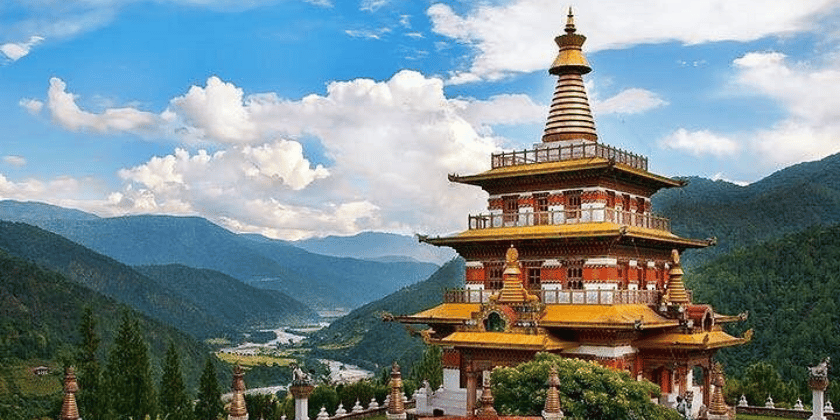
Upon arrival at the Khamsum Yulley Namgyal Chorten, visitors are greeted by the impressive structure’s towering white walls and ornate decorations. The chorten’s interior is equally impressive, with intricate murals depicting the life of Buddha and the teachings of Buddhism.
The chorten’s four floors offer panoramic views of the surrounding valley and mountains, making it an ideal spot for photography enthusiasts. Visitors can also enjoy a picnic lunch in the chorten’s tranquil courtyard or take a moment to meditate in the peaceful surroundings.
In addition to the chorten, the surrounding area is home to several other attractions that visitors can explore. These include the stunning Punakha Dzong, one of the most significant fortresses in Bhutan, and the nearby Sangchhen Dorji Lhuendrup Lhakhang, a beautiful temple that offers stunning views of the Punakha Valley.
In conclusion, the Khamsum Yulley Namgyal Chorten is a must-visit destination for anyone traveling to Bhutan. The chorten’s unique design, breathtaking views, and peaceful surroundings make it an ideal spot for travelers seeking a break from the hustle and bustle of daily life. A visit to the Khamsum Yulley Namgyal Chorten is a chance to experience the serene beauty of Bhutan’s traditional architecture and immerse yourself in the country’s rich cultural heritage.
- Royal Manas National Park
Royal Manas National Park is a beautiful and breathtaking destination located in southern Bhutan. This protected area is the oldest national park in the country and is home to a diverse range of flora and fauna, including some of the rarest and endangered species in the world. A visit to Royal Manas National Park is a must for nature lovers, wildlife enthusiasts, and adventure seekers.
The national park covers an area of approximately 1,057 square kilometers, and it is one of the largest protected areas in Bhutan. The park is situated in the southern foothills of the Himalayas, and it stretches from the subtropical lowlands of the Sankosh River to the alpine meadows of the Black Mountains. The park is known for its varied landscapes, which include dense forests, grasslands, wetlands, and rugged mountain peaks.
Royal Manas National Park is home to a remarkable range of wildlife. The park is home to over 900 species of plants, 50 species of mammals, and 350 species of birds. Among the rare and endangered species that can be found here are the Bengal tiger, Indian rhinoceros, Asian elephant, clouded leopard, and golden langur. The park is also home to several species of birds, including the Great Hornbill, which is the national bird of Bhutan.
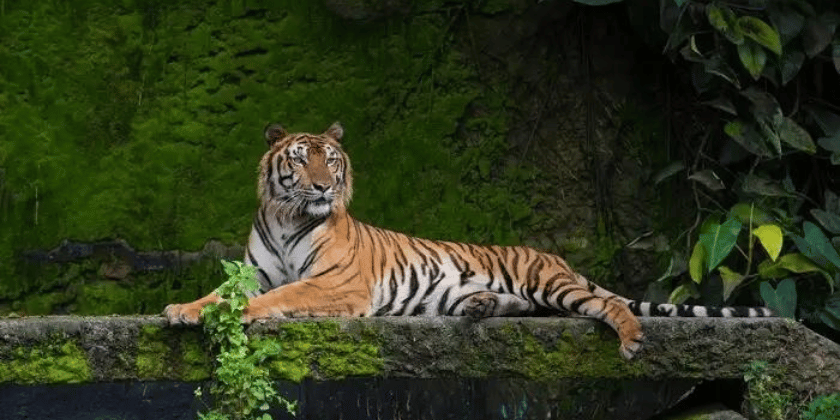
The park is also a popular destination for adventure activities such as trekking, camping, and bird watching. There are several trekking routes that visitors can take, which vary in difficulty level and duration. The park also offers a unique opportunity to explore the culture and traditions of the local communities, which have lived in the park for generations. Visitors can interact with the local people and learn about their way of life, which is closely intertwined with the natural environment.
One of the best ways to explore Royal Manas National Park is by taking a guided tour. There are several tour operators that offer customized tours to the park, which include accommodation, meals, transportation, and activities. Visitors can choose from a variety of tour packages, depending on their interests and budget.
Overall, Royal Manas National Park is a destination that should not be missed when visiting Bhutan. With its stunning landscapes, diverse wildlife, and rich cultural heritage, it offers a unique and unforgettable experience that will stay with visitors for a lifetime.
- Trashigang Dzong
Trashigang Dzong is a beautiful and historic fortress located in eastern Bhutan. Built in the 17th century, this dzong served as the administrative center for the Trashigang district for many years. Today, it is a popular tourist destination that offers a glimpse into Bhutan’s rich cultural heritage.
The dzong is perched on a hill overlooking the town of Trashigang and the surrounding valleys. It is an impressive structure that is built in the traditional Bhutanese architectural style, with towering walls and steeply sloped roofs. The dzong has several courtyards and buildings, including the main assembly hall, administrative offices, and living quarters for the monks.
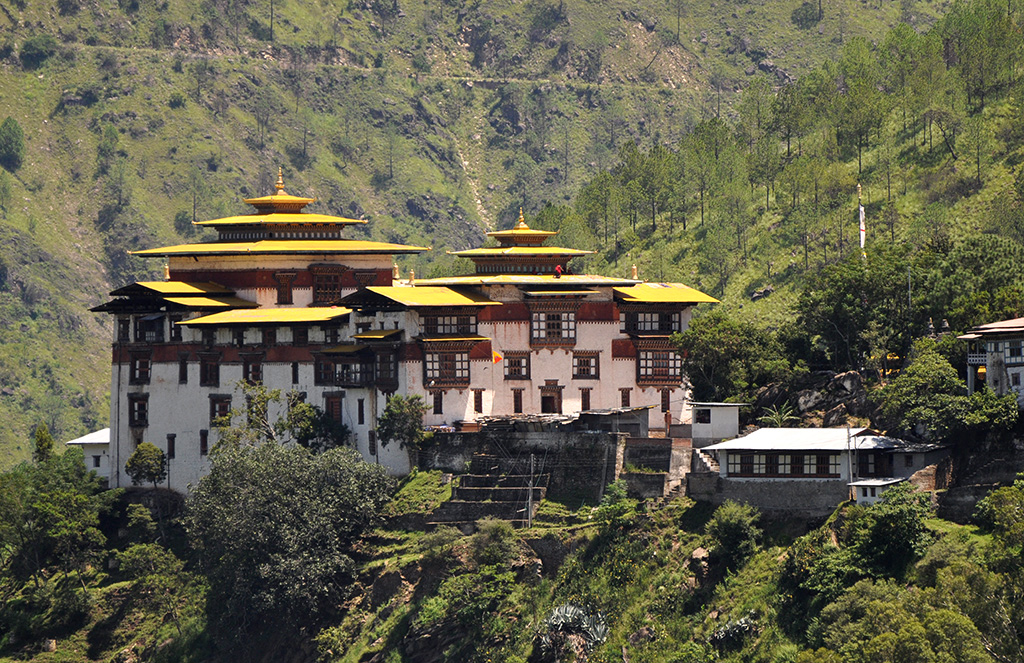
One of the main attractions of Trashigang Dzong is its beautiful paintings and murals. The walls of the dzong are adorned with intricate paintings that depict Buddhist deities, mythical creatures, and scenes from Bhutanese history and folklore. These paintings are considered some of the finest examples of Bhutanese art and are a testament to the country’s rich cultural heritage.
Another highlight of a visit to Trashigang Dzong is the opportunity to attend a traditional Bhutanese festival. The dzong hosts several festivals throughout the year, including the popular Trashigang Tsechu, which is held in the 10th month of the Bhutanese lunar calendar. During these festivals, visitors can witness colorful dances, traditional music performances, and other cultural activities.
In addition to its cultural and historical significance, Trashigang Dzong also offers breathtaking views of the surrounding landscape. From the top of the hill where the dzong is located, visitors can enjoy panoramic views of the town of Trashigang and the surrounding valleys. The dzong is also surrounded by beautiful gardens and forests, which offer a peaceful and serene atmosphere.
Visiting Trashigang Dzong is a unique and unforgettable experience that offers a glimpse into Bhutan’s rich cultural heritage. Whether you are interested in history, art, or simply want to enjoy the natural beauty of the region, a visit to this impressive fortress is a must. With its stunning architecture, beautiful paintings, and vibrant festivals, Trashigang Dzong is a destination that should not be missed when exploring the eastern regions of Bhutan.
- Pema Gatshel Dzong
Pema Gatshel Dzong is a beautiful fortress located in the town of Pema Gatshel in southeastern Bhutan. Built in the 18th century, this dzong served as the administrative center for the Pema Gatshel district for many years. Today, it is a popular tourist destination that offers a glimpse into Bhutan’s rich cultural heritage.
The dzong is built in the traditional Bhutanese architectural style, with towering walls and steeply sloped roofs. It is perched on a hill overlooking the town and the surrounding valleys, offering breathtaking views of the surrounding landscape. The dzong has several courtyards and buildings, including the main assembly hall, administrative offices, and living quarters for the monks.
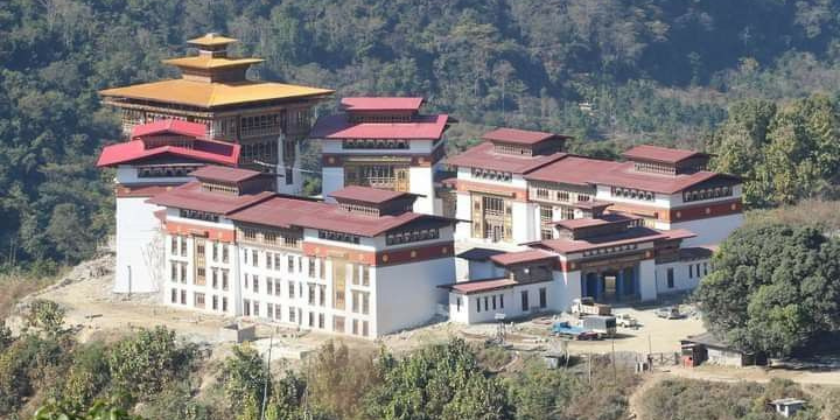
One of the main attractions of Pema Gatshel Dzong is its beautiful paintings and murals. The walls of the dzong are adorned with intricate paintings that depict Buddhist deities, mythical creatures, and scenes from Bhutanese history and folklore. These paintings are considered some of the finest examples of Bhutanese art and are a testament to the country’s rich cultural heritage.
Another highlight of a visit to Pema Gatshel Dzong is the opportunity to attend a traditional Bhutanese festival. The dzong hosts several festivals throughout the year, including the popular Pema Gatshel Tshechu, which is held in the 10th month of the Bhutanese lunar calendar. During these festivals, visitors can witness colorful dances, traditional music performances, and other cultural activities.
In addition to its cultural and historical significance, Pema Gatshel Dzong also offers breathtaking views of the surrounding landscape. From the top of the hill where the dzong is located, visitors can enjoy panoramic views of the town of Pema Gatshel and the surrounding valleys. The dzong is also surrounded by beautiful gardens and forests, which offer a peaceful and serene atmosphere.
Visiting Pema Gatshel Dzong is a unique and unforgettable experience that offers a glimpse into Bhutan’s rich cultural heritage. Whether you are interested in history, art, or simply want to enjoy the natural beauty of the region, a visit to this impressive fortress is a must. With its stunning architecture, beautiful paintings, and vibrant festivals, Pema Gatshel Dzong is a destination that should not be missed when exploring the southeastern regions of Bhutan.
- Zhemgang Wildlife Reserve
Zhemgang Wildlife Reserve is a hidden gem in Bhutan, a country that is known for its pristine natural beauty and diverse wildlife. As a visiting tourist, the reserve offers a unique opportunity to explore the dense forests of the Himalayas and experience the rich biodiversity of the region.
Located in the central part of Bhutan, Zhemgang Wildlife Reserve covers an area of around 1,500 square kilometers and is home to a wide range of wildlife species, including tigers, leopards, clouded leopards, elephants, red pandas, Himalayan black bears, and many species of birds and butterflies. The reserve is also home to several rare and endangered species, such as the golden langur, one of the world’s rarest primates.
The landscape of the reserve is diverse, ranging from subtropical forests in the lower elevations to alpine meadows and glaciers in the higher elevations. The reserve is also crisscrossed by several rivers and streams, which provide a natural habitat for aquatic species like fish and otters.
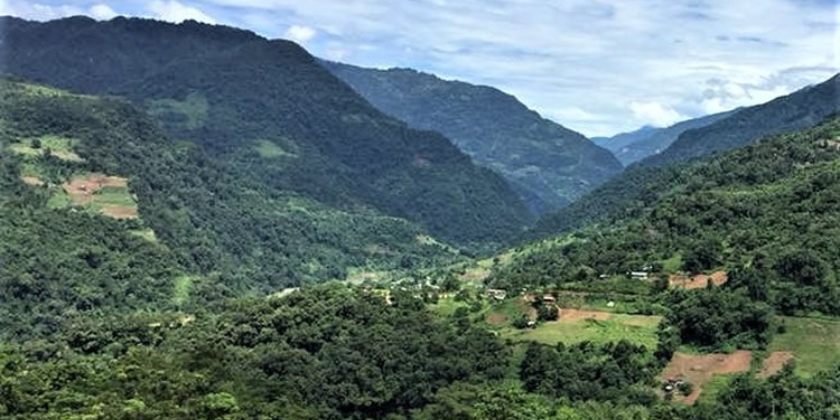
One of the most popular activities for tourists visiting Zhemgang Wildlife Reserve is trekking. The reserve offers a range of trekking options, from easy walks through the lower forests to challenging hikes up to the high mountain passes. Along the way, visitors can explore the natural beauty of the reserve, encounter wildlife in its natural habitat, and interact with the local communities who live in the surrounding areas.
Visitors can also explore the cultural heritage of the region by visiting the nearby villages and towns, which are known for their traditional architecture, handicrafts, and cuisine. The people in this region are warm and welcoming, and they are always eager to share their culture and traditions with visitors.
For those interested in wildlife photography, Zhemgang Wildlife Reserve offers excellent opportunities to capture some of the rarest and most elusive species in their natural habitat. The reserve has several observation towers and hides where visitors can wait for hours to capture the perfect shot of a tiger or leopard roaming through the forests.
Overall, Zhemgang Wildlife Reserve is a must-visit destination for any nature lover or wildlife enthusiast visiting Bhutan. It offers a unique and unforgettable experience that combines natural beauty, biodiversity, adventure, and cultural immersion.
- Tashichho Dzong
Tashichho Dzong, also known as the “fortress of the glorious religion,” is an impressive landmark and one of the most famous tourist attractions in Bhutan. Located in the capital city of Thimphu, this majestic structure is the seat of the Bhutanese government and the office of the King of Bhutan. The dzong also serves as a religious center for the Buddhist community in the country.
As a visiting tourist, stepping into Tashichho Dzong is like entering a world that is steeped in history and culture. The structure itself is an architectural marvel, featuring intricate carvings, vibrant paintings, and stunning sculptures. It is a perfect representation of Bhutanese traditional architecture and is a must-visit site for anyone interested in history, religion, and culture.
The dzong was first constructed in 1216 AD and has been rebuilt and renovated several times over the years. Today, it stands as a testament to the country’s rich history and cultural heritage. The structure is spread over an area of approximately 35 acres and is a masterpiece of Bhutanese art and architecture.
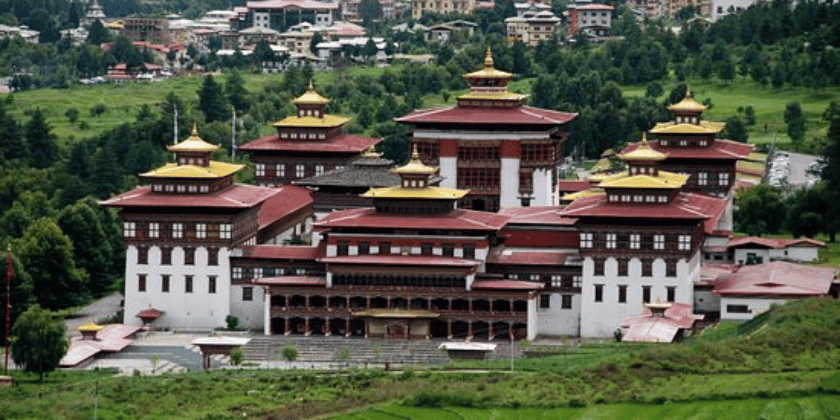
One of the most prominent features of Tashichho Dzong is its beautiful courtyard, which is surrounded by prayer wheels and offers a peaceful and serene atmosphere. Visitors can also take a stroll through the dzong’s various rooms and halls, which are adorned with intricate murals and religious artifacts.
The dzong is also home to a number of religious institutions, including the Central Monastic Body and the Office of the Je Khenpo (the highest religious authority in Bhutan). Visitors can observe the daily religious rituals and practices that take place in the dzong, including chanting, prayers, and offerings.
One of the most significant events that take place in Tashichho Dzong is the annual Thimphu Tshechu festival. This vibrant and colorful festival brings together people from all over the country to celebrate the teachings of Buddhism and the country’s rich cultural heritage. Visitors can witness the festival’s unique mask dances, traditional music, and delicious Bhutanese cuisine.
Overall, Tashichho Dzong is a must-visit destination for anyone traveling to Bhutan. Its awe-inspiring architecture, rich history, and cultural significance make it one of the most fascinating and beautiful landmarks in the country. As a visiting tourist, you can expect to be enchanted by the dzong’s peaceful atmosphere and transported to a world that is both ancient and timeless.
- Chhimi Lhakhang
Chhimi Lhakhang: A Unique Temple in Bhutan
Bhutan, a small country in the eastern Himalayas, is known for its pristine natural beauty, unique culture, and spirituality. Among the many temples and monasteries that dot the landscape of Bhutan, Chhimi Lhakhang stands out for its unique history and spiritual significance. Also known as the Temple of Fertility, Chhimi Lhakhang is a popular destination for both locals and tourists alike.
Location and History Chhimi Lhakhang is located in Punakha, about 20 km from the town center. The temple is situated on a small hill and can only be reached by foot. The trail leading to the temple takes about 20-30 minutes to complete and offers stunning views of the surrounding countryside.
The temple was built in the 15th century by the renowned Buddhist saint, Lama Drukpa Kunley, also known as the Divine Madman. Lama Kunley was known for his unorthodox teaching methods and his use of humor and sexuality to spread his message of compassion and enlightenment. Chhimi Lhakhang was built on the site where Lama Kunley subdued a demoness who was terrorizing the local people.
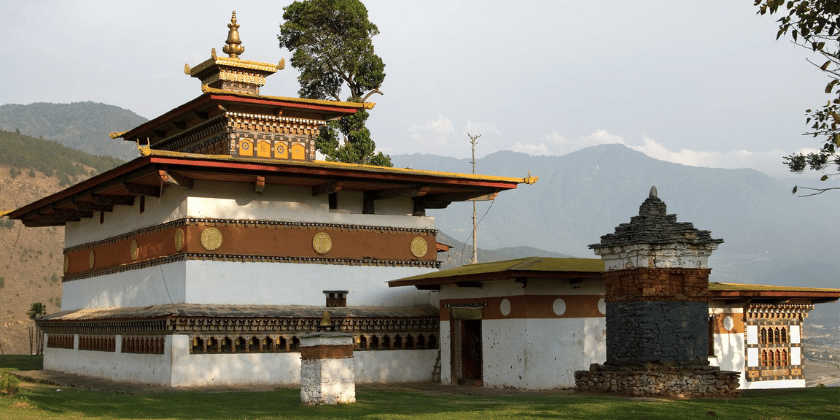
Architecture and Design Chhimi Lhakhang is a small, white-washed temple with a golden roof. The temple’s architecture is typical of Bhutanese style with its intricate wood carvings and traditional paintings. The temple’s interior is decorated with paintings of Lama Kunley, the goddess Tara, and other Buddhist deities.
The temple’s most striking feature is the large wooden phallus or “thunderbolt of enlightenment” that is displayed prominently in the temple’s main hall. The phallus is considered a symbol of fertility and is believed to have the power to bless couples with children. Visitors to the temple often seek blessings from the phallus and take home small wooden replicas as souvenirs.
Spiritual Significance Chhimi Lhakhang is considered one of the most important fertility temples in Bhutan. Couples from all over the country and even from abroad come to the temple seeking blessings for fertility and safe childbirth. The temple’s association with fertility is believed to date back to Lama Kunley’s teachings, which emphasized the importance of sexual liberation and the elimination of desire as a means to achieve enlightenment.
Apart from its association with fertility, Chhimi Lhakhang is also a place of spiritual significance for Buddhist practitioners. The temple’s location on a small hill overlooking the valley is believed to be a source of positive energy, and visitors to the temple often perform circumambulations or prayer walks around the temple to accumulate merit.
Visiting Chhimi Lhakhang Visitors to Chhimi Lhakhang are required to dress modestly and remove their shoes before entering the temple. Photography is allowed inside the temple, but visitors are advised to seek permission before taking pictures of the temple’s interior or of the monks.
The best time to visit Chhimi Lhakhang is during the spring and autumn months when the weather is mild and the surrounding countryside is in full bloom. Visitors to the temple can combine their visit with a trek to nearby villages or a visit to the nearby Punakha Dzong, one of Bhutan’s most famous landmarks.
In conclusion, Chhimi Lhakhang is a unique and fascinating temple that offers visitors a glimpse into the spiritual and cultural heritage of Bhutan. Whether you are seeking blessings for fertility or simply want to experience the beauty and tranquility of Bhutan, a visit to Chhimi Lhakhang is a must.
- Ta Dzong (National Museum)
Ta Dzong, also known as the National Museum of Bhutan, is a historic watchtower located in the heart of Paro Valley. It was constructed in the year 1656, during the reign of Tenzin Drugda, the first Paro Penlop (governor). The watchtower served as a defense fortress for the Paro Dzong and housed the district’s monks during times of conflict.
In 1968, the Bhutanese government converted the watchtower into a museum, and it has been open to the public ever since. The Ta Dzong now houses a vast collection of artifacts and exhibits that showcase Bhutanese culture, history, and religion.
As a tourist visiting Bhutan, a visit to the Ta Dzong is a must-see destination. Here is what you can expect from a trip to the National Museum.
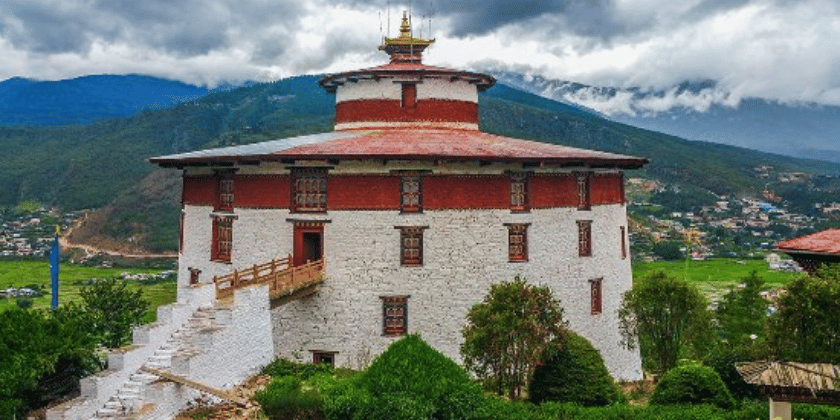
Exhibits
The museum’s main exhibition galleries are on four floors, with each level providing insights into different aspects of Bhutan’s history and culture. The first floor displays Bhutanese weapons, including traditional swords, bows, and arrows. You can also see an impressive collection of guns and ammunition, dating back to the early 20th century.
The second floor is dedicated to traditional Bhutanese clothing and jewelry. You will see a collection of gho, the traditional Bhutanese male dress, and kira, the female dress. The floor also showcases the jewelry worn by the Bhutanese people, including earrings, necklaces, and bracelets, which are crafted from precious metals and stones.
The third floor is devoted to religious art and exhibits, featuring Buddhist statues and thangkas (traditional Tibetan paintings). You can learn about the different types of religious ceremonies and practices that are carried out in Bhutan, including the annual tshechu festival.
The fourth floor, which was recently opened to the public, features an exhibition on Bhutan’s development and its transition to democracy. The gallery showcases Bhutan’s unique approach to development, which focuses on achieving Gross National Happiness rather than Gross Domestic Product.
Architecture
The Ta Dzong’s unique architecture is another reason why it is a must-see destination for tourists visiting Bhutan. The watchtower’s cylindrical shape, with its six floors and narrow windows, was designed to provide strategic advantages to its defenders during times of conflict. The architecture is a perfect example of Bhutanese traditional architecture, with its intricate woodwork, mud and brick walls, and sloping roofs.
The Ta Dzong’s location, atop a hill overlooking the Paro valley, also provides breathtaking views of the surrounding landscape. Visitors can enjoy panoramic views of the Paro valley and the Paro Dzong from the watchtower’s rooftop.
Visitor Information
The Ta Dzong is located in Paro, which is approximately 50 kilometers from Thimphu, Bhutan’s capital city. It is open from Tuesday to Saturday from 9:00 am to 4:00 pm and is closed on Sundays and Mondays. The entrance fee for the museum is Nu. 150 (approximately USD 2).
Visitors should note that photography is not allowed inside the museum, and they must store their cameras and phones in the provided lockers. However, photography is allowed in the museum’s courtyard.
In conclusion, a visit to the Ta Dzong is a must for tourists visiting Bhutan. The museum’s exhibits and architecture provide insights into the rich culture and history of Bhutan, while its location offers breathtaking views of the surrounding landscape.
- Gangkhar Puensum
Gangkhar Puensum is the highest peak in Bhutan and the world’s 40th highest mountain. It is located in the eastern Himalayas, on the border between Bhutan and China. Standing at 7,570 meters (24,836 ft), it is a formidable challenge for even the most experienced mountaineers. However, due to its religious significance in Bhutan, climbing Gangkhar Puensum has been prohibited since 2003.
As a visiting tourist, there are still plenty of opportunities to appreciate the awe-inspiring beauty of this majestic mountain. Gangkhar Puensum is visible from many locations in central and eastern Bhutan, and its snow-capped peak is a sight to behold against the blue sky. Here is a unique and detailed article on Gangkhar Puensum in Bhutan from a visiting tourist’s perspective:
Getting There:
Gangkhar Puensum is located in the far eastern part of Bhutan, near the border with China. The most common way to get there is by road from Thimphu, the capital city of Bhutan. The journey takes around 12 hours and involves crossing several mountain passes, including the famous Dochula Pass. Alternatively, visitors can fly into the nearby town of Paro and then take a road trip to Gangkhar Puensum.
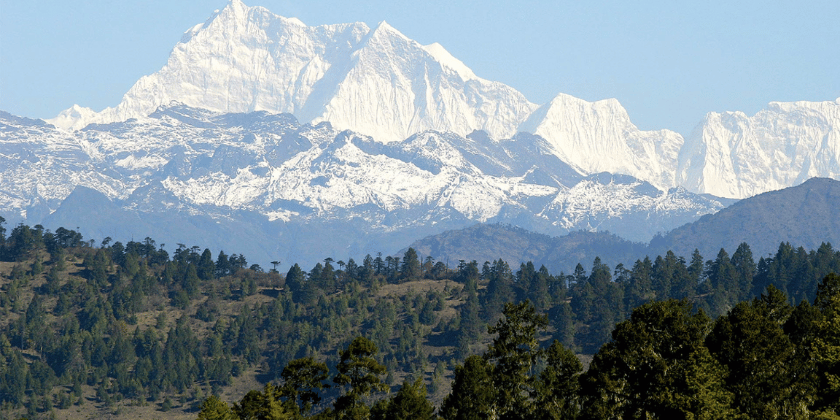
Things to Do:
- Hiking and Trekking: While climbing Gangkhar Puensum is off-limits, there are plenty of hiking and trekking opportunities in the surrounding area. The trails offer stunning views of the mountain and the surrounding landscape. Visitors can embark on short hikes to nearby villages or embark on multi-day treks to remote areas of eastern Bhutan.
- Photography: Gangkhar Puensum is a photographer’s dream, with its snow-capped peak, lush green valleys, and crystal-clear streams. Visitors can capture the beauty of the mountain from various vantage points, including nearby villages and hilltops.
- Cultural Experiences: Eastern Bhutan is home to many ethnic groups, each with its unique culture and traditions. Visitors can explore local villages and learn about the region’s history and culture.
- Wildlife Viewing: Gangkhar Puensum is located in one of Bhutan’s most remote and least explored regions, making it an ideal destination for wildlife enthusiasts. Visitors can spot rare and endangered species, such as the Bengal tiger, clouded leopard, and black-necked crane.
Best Time to Visit:
The best time to visit Gangkhar Puensum is during the dry season, which runs from October to May. The weather is sunny and clear, with low humidity and comfortable temperatures. The winter months of December to February can be chilly, with occasional snowfall in the higher elevations. Summer months, from June to September, are rainy and often cloudy, which can limit visibility.
Accommodation:
Accommodation options in Gangkhar Puensum are limited due to its remote location. However, visitors can find basic guesthouses and homestays in nearby villages. These accommodations offer a unique opportunity to experience local culture and hospitality.
Conclusion:
Gangkhar Puensum is a breathtaking mountain that offers visitors a chance to experience the beauty and culture of Bhutan’s remote eastern region. While climbing the mountain is not allowed, there are plenty of other activities to keep visitors busy. Whether you are a nature lover, photographer, hiker, or cultural enthusiast, a visit to Gangkhar Puensum is sure to be an unforgettable experience.
- Tang Valley
Tang Valley is a beautiful and serene destination located in the Bumthang district of Bhutan. It is a hidden gem of the country that offers an authentic Bhutanese experience to visitors. The valley is renowned for its cultural significance, stunning landscapes, and numerous sacred sites that attract both locals and tourists alike.
Getting to Tang Valley is an adventure in itself. The journey from Bumthang district to the valley takes approximately two hours by car, and the winding road offers panoramic views of the picturesque landscape along the way. Once in Tang Valley, visitors can explore the surrounding hills, traditional Bhutanese villages, and ancient monasteries that dot the landscape.
One of the most famous monasteries in the valley is the Tang Rimochen Lhakhang. This 14th-century temple is home to several sacred relics and is considered to be one of the most important monasteries in Bhutan. The monastery also hosts a yearly festival called the Tangbi Mani, where locals and tourists come together to celebrate with dance, music, and food.
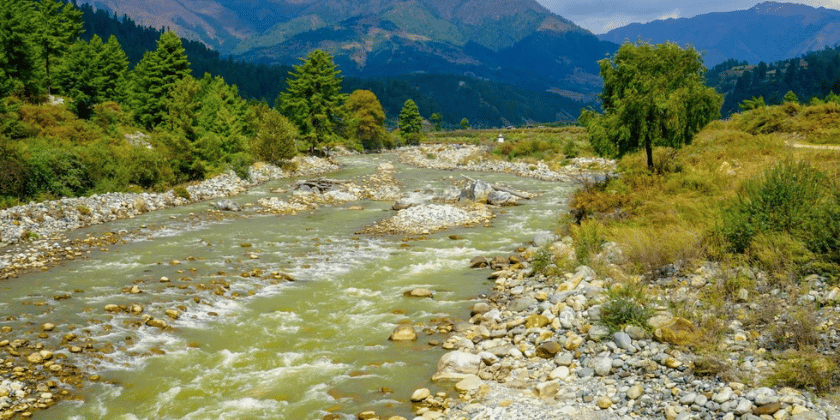
Another popular attraction in the valley is the Mebar Tsho or Burning Lake. Legend has it that in the 15th century, the treasure discoverer Pema Lingpa jumped into the lake with a butter lamp and emerged with several precious relics. The lake is now a pilgrimage site for many Bhutanese and is a serene location for visitors to sit and enjoy the peaceful surroundings.
The valley is also known for its traditional arts and crafts. Visitors can observe local artisans at work, creating beautiful handwoven textiles and intricate wood carvings. The valley is also home to several homestays, where visitors can experience the traditional Bhutanese way of life by staying with a local family and enjoying home-cooked meals.
Tang Valley is an excellent destination for hiking enthusiasts. The valley offers several hiking trails, including the Chökhor Nature Trail, which takes visitors through the heart of the valley, passing through traditional villages and ancient temples. The trail is an excellent way to experience the natural beauty of the valley while also learning about the local culture and traditions.
In conclusion, Tang Valley is a must-visit destination for anyone looking to experience the authentic Bhutanese way of life. The valley’s stunning landscapes, ancient monasteries, and traditional arts and crafts make it a unique and unforgettable experience. Whether you are a history buff, a nature lover, or simply looking for a peaceful escape from the hustle and bustle of daily life, Tang Valley is the perfect destination for you.
- Samtse Dzong
Samtse Dzong is a beautiful fortress that is located in the town of Samtse in Bhutan. This dzong is a great example of Bhutanese architecture and is a must-visit for anyone who is interested in Bhutan’s rich history and culture.
As a tourist visiting Samtse Dzong, the first thing that you will notice is its impressive size. The dzong covers a vast area and is situated on a hilltop, overlooking the town of Samtse. The dzong has been built using traditional Bhutanese architecture and is a beautiful example of the country’s unique style. The intricate woodwork and carvings that adorn the dzong are particularly noteworthy, and visitors can spend hours admiring the intricate details.
One of the most impressive features of Samtse Dzong is the large central courtyard. This courtyard is surrounded by a series of buildings that house administrative offices, monk quarters, and other important areas of the dzong. The central tower is another highlight of the dzong, with its ornate decorations and striking design.
One of the best ways to explore Samtse Dzong is to take a guided tour. Guides are available at the entrance of the dzong, and they can provide visitors with a wealth of information about the dzong’s history and significance. The tour will take you through the different areas of the dzong, including the impressive central courtyard, the monk quarters, and the administrative offices. You will also have the opportunity to see some of the beautiful religious artifacts and paintings that are housed within the dzong.
For those interested in Buddhism, Samtse Dzong is an important religious site. The dzong houses several temples and shrines, including the main prayer hall. Visitors are welcome to observe the monks as they perform their daily rituals and prayers, and they can also participate in meditation sessions and other religious activities.
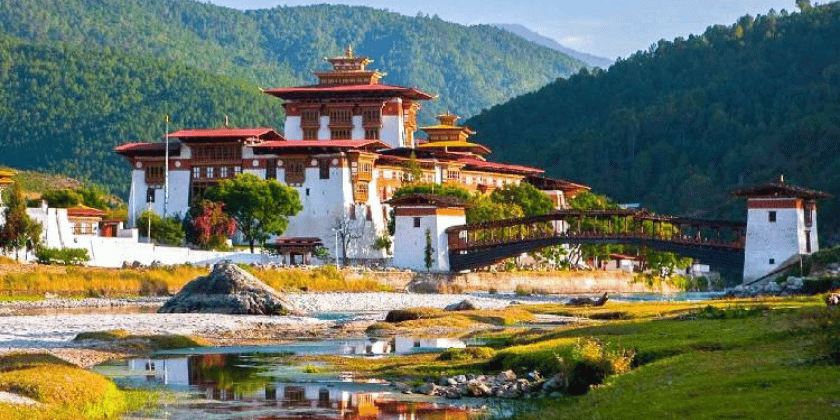
Visitors to Samtse Dzong should also take the time to explore the surrounding area. The town of Samtse is a charming place, with its small shops and cafes that sell local handicrafts and delicious Bhutanese cuisine. The nearby countryside is also stunning, with its rolling hills and verdant forests. Hiking and trekking are popular activities in the area, and visitors can explore the nearby villages and temples on foot.
In conclusion, Samtse Dzong is a beautiful and historically significant site that is well worth a visit for anyone traveling to Bhutan. The dzong’s impressive size, intricate woodwork, and beautiful architecture are a testament to the country’s rich history and culture. Visitors should take the time to explore the surrounding area and soak up the natural beauty and charm of this part of Bhutan.
- Jomolhari Base Camp Trek
Jomolhari Base Camp Trek in Bhutan from a visiting tourist’s perspective
Bhutan, the land of the thunder dragon, is a country of ancient Buddhist monasteries, majestic fortresses, and awe-inspiring mountain ranges. It is a place of natural beauty and spiritual harmony. One of the most popular trekking routes in Bhutan is the Jomolhari Base Camp Trek. This trek is a perfect combination of adventure, culture, and natural beauty. It is a once-in-a-lifetime experience that you will never forget.
The Jomolhari Base Camp Trek is a moderate to difficult trek, with altitudes ranging from 2400 meters to 4890 meters. It takes around 8-9 days to complete the trek, and it is recommended to visit Bhutan during the months of April-June or September-November for the best weather conditions.
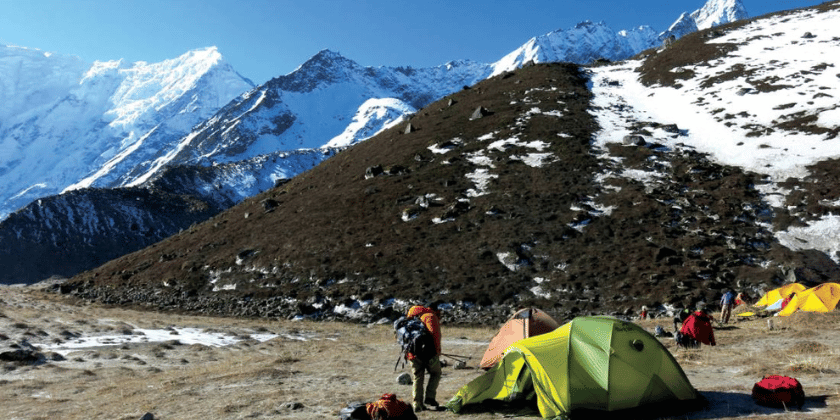
The trek begins in Paro, where you will get a chance to visit the famous Tiger’s Nest Monastery. From there, you will drive to Shana, the starting point of the trek. The trail follows the Paro River and gradually ascends through forests of oak, rhododendron, and pine trees. You will come across beautiful waterfalls, small villages, and yak herders along the way.
As you ascend higher, the views become more spectacular. You will cross several high mountain passes, including the highest point of the trek, the Nyile La Pass at 4,890 meters. The pass offers breathtaking views of Jomolhari, which is the second-highest mountain in Bhutan, standing at 7,314 meters.
As you descend from the pass, you will reach the Jangothang Valley, which is the base camp for Jomolhari. Here you can take a day to explore the surrounding areas and enjoy the beautiful landscape. You can also take a hike to Tshophu Lake, which is a beautiful glacial lake surrounded by snow-capped mountains.
After spending a day at Jangothang, you will begin your descent back to Shana. On the way back, you can stop at the village of Thangthangka, where you can visit a local farmhouse and experience the traditional Bhutanese way of life. You will also pass through beautiful forests and cross several rivers and streams.
The Jomolhari Base Camp Trek is not just about the beautiful landscape and challenging trekking, but also about experiencing the rich Bhutanese culture. Along the way, you will get a chance to visit traditional villages and interact with the locals. You will also get a chance to visit ancient monasteries and temples, where you can learn about the Bhutanese religion and its rich history.
In conclusion, the Jomolhari Base Camp Trek is a challenging and rewarding trek that offers a unique opportunity to experience the natural beauty, rich culture, and history of Bhutan. It is an adventure of a lifetime that you will never forget.
- Phuentsholing
Phuentsholing is a border town in southwestern Bhutan, which serves as the primary point of entry for tourists visiting Bhutan from India. It is located at an altitude of about 300 meters above sea level and is known for its vibrant culture, bustling streets, and warm hospitality. As a tourist, visiting Phuentsholing offers a unique perspective on Bhutanese life and an opportunity to experience the country’s border town. Here’s a guide to exploring Phuentsholing from a visiting tourist’s perspective:
Immigration and Entry Procedures As Phuentsholing is the main point of entry into Bhutan, all tourists must go through the immigration and entry procedures here. Visitors must obtain a tourist visa before arriving in Bhutan, and this can only be done through a licensed tour operator in Bhutan. Tourists must also obtain a permit to enter Bhutan, which can be arranged by the tour operator. Once you arrive at Phuentsholing, you will need to visit the immigration office to get your permit stamped. The process is straightforward, and most tour operators will help you navigate the process.
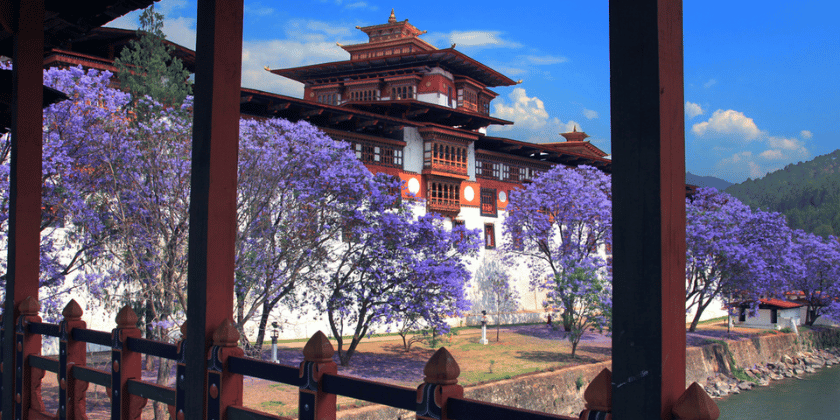
Exploring Phuentsholing Once you have completed the immigration procedures, you can start exploring Phuentsholing. The town is a melting pot of cultures, with a mix of Bhutanese, Indian, and Nepali communities. The town is bustling with activity, with shops, restaurants, and cafes lining the streets. Phuentsholing is known for its vibrant markets, where you can find everything from fresh produce to souvenirs. The Zangtho Pelri Lhakhang, a temple dedicated to Guru Rinpoche, is a popular attraction in the town and is worth a visit.
Bhutan Gate The Bhutan Gate, also known as the Friendship Gate, is located at the border between India and Bhutan. The gate is a symbol of the close relationship between the two countries and is an excellent spot to take photos. The gate is also the starting point for the road that leads to Thimphu, Bhutan’s capital city.
Karbandi Monastery Karbandi Monastery is located on a hilltop overlooking Phuentsholing and is known for its breathtaking views of the town and surrounding hills. The monastery is dedicated to Guru Rinpoche and houses a statue of the deity. It is a peaceful and serene place and is a great spot to spend an afternoon.
Crocodile Breeding Center Phuentsholing is home to a crocodile breeding center, which is managed by the Royal Government of Bhutan. The center is located a few kilometers outside the town and is a great place to learn about the conservation efforts to protect the endangered gharial crocodile. The center is home to more than 100 crocodiles, and visitors can learn about the breeding and conservation efforts.
Accommodation and Dining Phuentsholing offers a range of accommodation options, including budget guesthouses and luxury hotels. There are also several restaurants and cafes in the town that serve a variety of cuisines, including Bhutanese, Indian, and Chinese. Bhutanese cuisine is a must-try, and visitors can sample local delicacies like Ema Datshi (spicy cheese and chili dish) and Suja (butter tea).
Conclusion Phuentsholing is a unique town in Bhutan that offers visitors a glimpse into the country’s border town culture. The town’s vibrant markets, beautiful temples, and stunning views make it a great place to start your Bhutanese adventure. Whether you’re passing through on your way to other parts of Bhutan or planning to stay for a few days, Phuentsholing is a town worth exploring.
- Lhuntse Dzong
Lhuntse Dzong is a beautiful fortress located in the remote town of Lhuntse in eastern Bhutan. It is one of the oldest and most historic dzongs in the country, dating back to the 16th century. The dzong is perched on a hilltop overlooking the valley, surrounded by lush green forests and beautiful farmlands. It is a must-visit destination for tourists who want to explore the rich cultural heritage of Bhutan.
As you approach the dzong, you will be struck by its imposing size and beautiful architecture. The dzong is built in the traditional Bhutanese style, with white walls and a red roof. The entrance to the dzong is guarded by two large wooden doors, which are decorated with intricate carvings and paintings. As you enter the dzong, you will be greeted by a large courtyard, surrounded by a series of smaller buildings.
One of the main attractions of Lhuntse Dzong is the beautiful prayer hall, which is decorated with colorful murals and paintings. The hall is filled with the sound of chanting monks, creating a peaceful and serene atmosphere. The murals depict scenes from the life of the Buddha and other important figures in Bhutanese history. The intricate detail and vibrant colors of the murals are truly awe-inspiring.
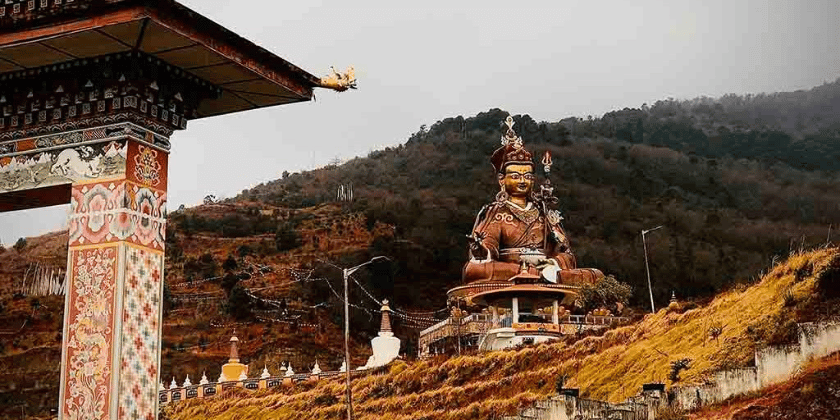
Another highlight of Lhuntse Dzong is the museum, which houses a collection of artifacts and objects related to Bhutanese culture and history. The museum has several rooms filled with exhibits, including traditional clothing, jewelry, and artwork. The displays provide a fascinating insight into the daily life of Bhutanese people, as well as the country’s rich artistic heritage.
In addition to exploring the dzong itself, visitors can also take a stroll around the town of Lhuntse. The town is known for its beautiful textiles, which are woven using traditional techniques. Visitors can visit local shops and markets to purchase handcrafted textiles, as well as other souvenirs and gifts.
One of the best times to visit Lhuntse Dzong is during one of the annual festivals, which are held throughout the year. These festivals are a celebration of Bhutanese culture and tradition, and offer a unique opportunity to experience the country’s rich heritage firsthand. The most famous festival in Lhuntse is the annual Tshechu, which is held in the autumn and features colorful dances and performances by monks and villagers.
Overall, Lhuntse Dzong is a must-visit destination for anyone interested in Bhutanese culture and history. The dzong’s beautiful architecture, vibrant murals, and fascinating museum exhibits offer a glimpse into the rich cultural heritage of the country. Whether you are a history buff, an art lover, or simply looking for a peaceful and serene atmosphere, Lhuntse Dzong is a destination that should not be missed.
- Nabji Korphu Trek
Nabji Korphu Trek in Bhutan is a beautiful and scenic journey that is perfect for nature lovers and adventure seekers. The trek takes you through the stunning landscape of Bhutan and lets you experience the authentic rural life of the country. The trek is not just about the destination but also about the journey that takes you through the picturesque villages and scenic routes. In this article, we will give you a detailed insight into the Nabji Korphu Trek in Bhutan from a visiting tourist’s perspective.
The Nabji Korphu Trek is a moderate trek that takes you through dense forests, beautiful meadows, and scenic mountain ranges. The trek starts from the village of Tongtongfey and takes you through the remote villages of Nabji and Korphu. The trek is a great way to explore the rural life of Bhutan and interact with the local communities. You will get to witness the unique culture and traditions of Bhutan up close.
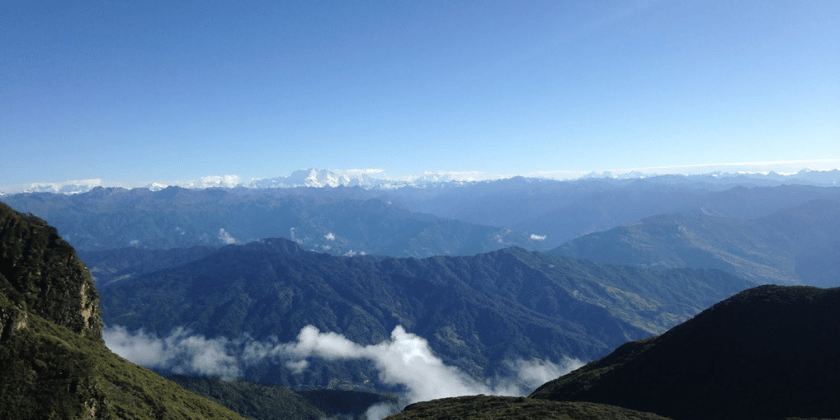
The trek is usually done in 4-5 days and covers a total distance of approximately 45-50 km. The trail is well-marked and takes you through lush green forests, rice paddies, and streams. The trek also takes you through the Jigme Singye Wangchuck National Park, which is home to a diverse range of flora and fauna. You might get a chance to spot some rare and endangered species like the Himalayan Black Bear, Red Panda, and the Royal Bengal Tiger.
The first stop on the trek is the village of Nabji, which is known for its beautiful terraced fields and unique stilted houses. The village is located in a remote area and is not accessible by road. The villagers still rely on traditional methods of farming and animal husbandry. You will get to experience the authentic rural life of Bhutan and learn about the traditional farming techniques used by the locals.
The second stop on the trek is the village of Korphu, which is known for its beautiful waterfall and hot springs. The village is located in a picturesque valley and offers stunning views of the surrounding mountains. You can take a dip in the hot springs and relax after a long day of trekking. The village is also home to a community-owned eco-lodge, which offers comfortable accommodation and delicious Bhutanese cuisine.
The Nabji Korphu Trek is not just about the trekking experience but also about the cultural immersion. The trek takes you through the heart of Bhutan and lets you experience the unique culture and traditions of the country. You will get to interact with the locals, learn about their way of life, and sample the delicious Bhutanese cuisine. The trek is a great way to disconnect from the modern world and connect with nature and the local communities.
In conclusion, the Nabji Korphu Trek is a beautiful and scenic journey that takes you through the remote villages of Bhutan. The trek offers stunning views of the surrounding mountains and lets you experience the authentic rural life of the country. The trek is a great way to explore the unique culture and traditions of Bhutan and interact with the local communities. If you are a nature lover and adventure seeker, then the Nabji Korphu Trek is a must-do activity when visiting Bhutan.
- Sakteng Wildlife Sanctuary
Sakteng Wildlife Sanctuary is a natural wonderland located in the eastern part of Bhutan. It was established in 2003 and covers an area of 650 square kilometers. The sanctuary is home to a wide range of flora and fauna and offers visitors a unique opportunity to experience the beauty and diversity of Bhutan’s wilderness.
As a tourist visiting Sakteng Wildlife Sanctuary, you will be greeted with breathtaking views of snow-capped mountains, lush green valleys, and crystal clear streams. The sanctuary is known for its high-altitude rhododendron forests, which bloom in vivid shades of pink, red, and purple in the spring. These forests are home to a variety of rare and endangered species, including the Asiatic black bear, red panda, and Himalayan musk deer.
One of the most popular activities for visitors to Sakteng Wildlife Sanctuary is trekking. The sanctuary offers several trekking routes that take you through some of the most pristine and remote regions of Bhutan. One of the most famous trekking routes in the sanctuary is the Merak-Sakteng trek. This trek takes you through the nomadic villages of Merak and Sakteng, where you can experience the traditional way of life of the Brokpa people, an ethnic group that has lived in this region for generations.
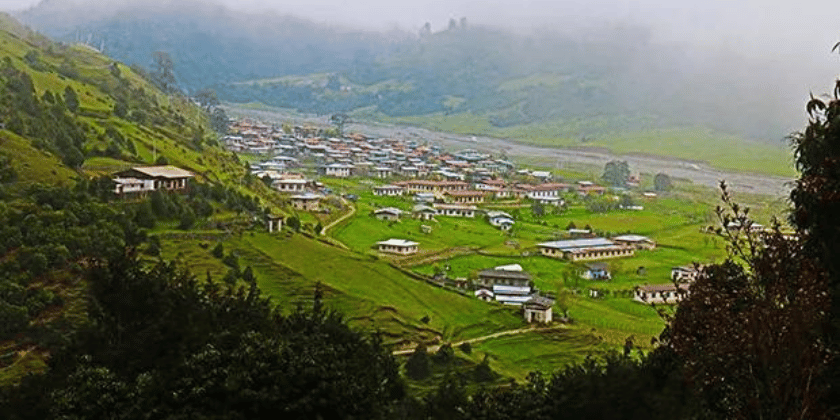
Another popular activity in Sakteng Wildlife Sanctuary is birdwatching. The sanctuary is home to over 200 species of birds, including the rare and endangered white-bellied heron, which is found only in Bhutan and Myanmar. Other bird species found in the sanctuary include the Himalayan monal, blood pheasant, and rufous-necked hornbill.
Visitors to Sakteng Wildlife Sanctuary can also learn about the local culture and traditions of the Brokpa people by visiting the village of Sakteng. The village is known for its unique architecture, which features stone houses with wooden roofs. The Brokpa people are skilled weavers and produce a variety of traditional textiles, including the famous yak hair blankets and shawls.
In addition to its natural and cultural attractions, Sakteng Wildlife Sanctuary also offers visitors a chance to experience the simple and peaceful lifestyle of the region. Visitors can stay in traditional homestays in the villages of Merak and Sakteng, where they can enjoy the hospitality of the Brokpa people and learn about their way of life.
Overall, Sakteng Wildlife Sanctuary is a must-visit destination for anyone interested in experiencing the beauty and diversity of Bhutan’s wilderness. With its stunning scenery, unique culture, and diverse wildlife, it offers visitors an unforgettable experience that they will cherish for years to come.
- Ura Valley in Bhutan
Ura Valley is a beautiful and serene destination situated in the Bumthang district of Bhutan. The valley is home to the Ura village, which is one of the highest settlements in Bhutan, located at an altitude of 3,100 meters. The valley is surrounded by lush green mountains, and the air is crisp and refreshing. Visiting Ura Valley is an excellent way to experience the authentic rural lifestyle of Bhutan and immerse yourself in the natural beauty of the region.
The Ura village is well-known for its traditional architecture and way of life. The village is organized around a central courtyard, which serves as a gathering place for the community. The houses in the village are built using traditional methods and materials, with walls made of mud and stones and roofs made of wooden shingles.
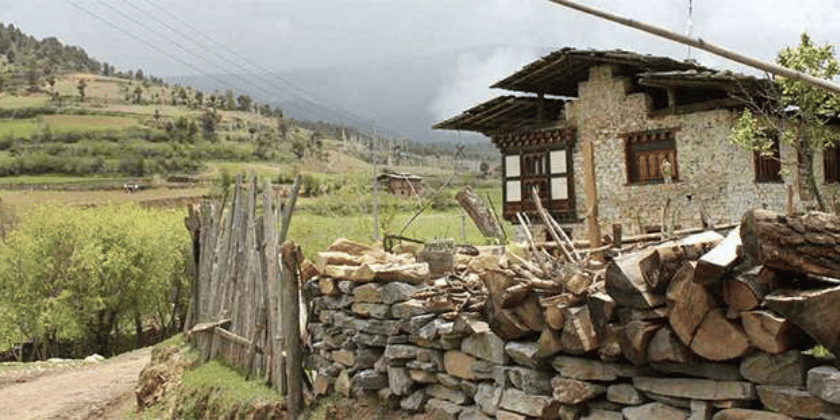
One of the most interesting things to do in Ura Valley is to take a walk around the village and admire the beautiful traditional houses. You can also visit the Ura Lhakhang, a beautiful temple located in the village. The temple is famous for its beautiful frescoes and intricate woodwork.
Another popular attraction in Ura Valley is the annual Ura Yakchoe festival, which takes place in the Ura Lhakhang. The festival is held in May or June and is a celebration of Guru Rinpoche, the founder of Buddhism in Bhutan. During the festival, locals wear traditional clothes and perform masked dances to commemorate the life of Guru Rinpoche.
Ura Valley is also a great place for hiking and trekking. There are several trails in the surrounding mountains that offer breathtaking views of the valley and the surrounding landscape. One of the most popular hikes is the Ura-Bumthang trek, which takes you through beautiful forests, pastures, and villages.
If you are interested in learning more about the traditional way of life in Bhutan, you can visit the Ura Yakchoe Museum. The museum showcases the history and culture of the region, with exhibits on traditional crafts, agriculture, and religion.
Ura Valley is also an excellent place to sample traditional Bhutanese cuisine. The village is known for its delicious buckwheat pancakes and butter tea, which are staples of the local diet. You can also try dishes made with yak meat, which is a common ingredient in the region.
Overall, Ura Valley is a must-visit destination in Bhutan for those who want to experience the natural beauty and traditional way of life of the country. The valley offers a peaceful and relaxing escape from the hustle and bustle of modern life and a chance to connect with nature and Bhutanese culture.
- Dagala Thousand Lakes Trek
Dagala Thousand Lakes Trek in Bhutan is an incredible journey for adventure seekers and nature lovers. The trek is named after the numerous lakes that dot the beautiful landscape. The journey takes you through alpine meadows, lush forests, and beautiful valleys that showcase the natural beauty of Bhutan.
The trek starts from the quaint little village of Genekha, located about an hour’s drive from Thimphu, the capital city of Bhutan. From here, you begin your ascent towards the mountain pass. The trek covers a distance of about 40 kilometers and is spread over 5 days, with each day covering a different section of the trail.
The first day of the trek is a gradual uphill climb through a dense forest of blue pine trees. The trail is well-maintained, and the cool breeze and chirping of birds make for a pleasant trekking experience. You will reach your campsite at Labatama, which is situated next to the beautiful Labatama Lake, one of the many lakes you will see on this trek.
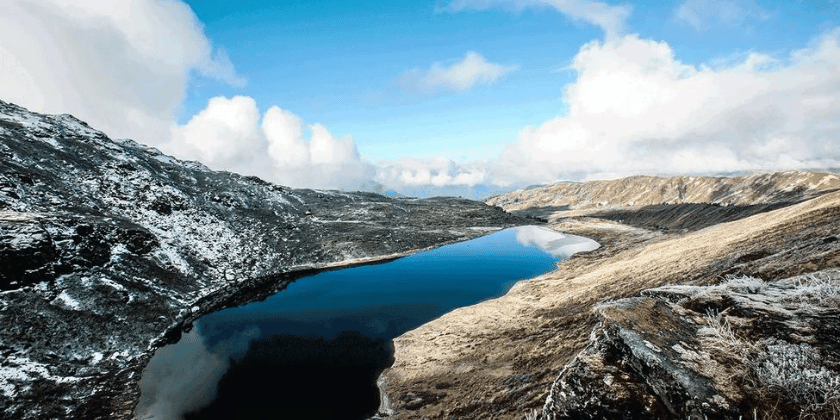
The second day of the trek is the toughest, as you will be crossing the highest pass on the trek, the Jaze La Pass, which stands at an altitude of 4,780 meters. The ascent is steep, and the air becomes thinner as you climb higher. But the stunning panoramic views of the surrounding mountains and the beautiful valley below make it all worth it.
As you descend towards the next campsite, you will come across several small lakes, including the Relitsho Lake, which is a popular spot for trout fishing. The campsite is situated near the banks of the beautiful Setso Lake, where you can spend some time admiring the natural beauty of the place.
The third day of the trek takes you through the beautiful valley of Jagetang. The trail winds through rhododendron forests, and if you are trekking during the spring season, you will be treated to a spectacular display of colors. You will pass through several villages and farmlands before reaching your campsite for the day.
The fourth day of the trek takes you towards the final campsite, which is situated near the banks of the Yutsho Lake. This lake is the largest of all the lakes you will see on this trek and is considered to be one of the most beautiful lakes in Bhutan.
The final day of the trek takes you through the picturesque village of Chamgang, where you will be greeted by friendly locals who will be happy to show you around. The trek ends in Chamgang, and from here, you can either drive back to Thimphu or continue your journey to explore other parts of Bhutan.
Overall, the Dagala Thousand Lakes Trek is a unique and unforgettable experience that takes you through some of the most beautiful landscapes in Bhutan. It is a journey that will leave you with memories that will last a lifetime.
- Trashiyangtse Dzong
Trashiyangtse Dzong, also known as Dongdi Dzong, is a magnificent fortress located in the eastern part of Bhutan. This beautiful dzong is situated in the Trashiyangtse district, which is known for its traditional handloom weaving and woodcarving.
As a visiting tourist, the Trashiyangtse Dzong is a must-see attraction. It is one of the most historically significant landmarks in Bhutan, dating back to the 15th century. The dzong was originally built as a monastery by the famous saint Pema Lingpa, who is believed to have discovered many hidden treasures in Bhutan. Later, in the 17th century, it was converted into a fortress by the governor of Trashiyangtse, Terton Sherab Wangchuk.
The Trashiyangtse Dzong is perched on a hilltop overlooking the town of Trashiyangtse and the Dangmechu River. The dzong is a stunning example of traditional Bhutanese architecture, with its whitewashed walls, red and gold woodwork, and intricate carvings. The dzong is surrounded by a beautiful courtyard with manicured gardens, and the interior is adorned with magnificent frescoes and intricate woodwork.
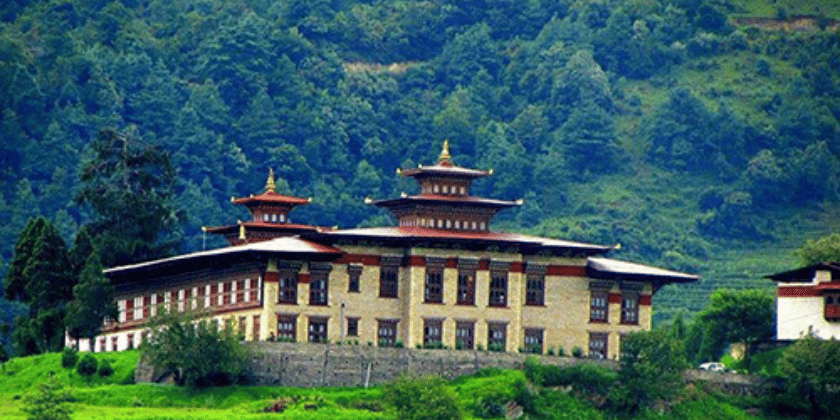
Visitors to the Trashiyangtse Dzong can explore the various temples and halls within the dzong, including the main temple dedicated to Guru Rinpoche, the protector temple dedicated to the local deity Tsheringma, and the assembly hall. The dzong also houses the administrative offices of the Trashiyangtse district.
One of the unique features of Trashiyangtse Dzong is its location on a cliff, which offers spectacular views of the surrounding valley and mountains. The dzong is also a great place to experience Bhutanese culture and history. Visitors can witness traditional Buddhist ceremonies and festivals that are held throughout the year, including the annual Trashiyangtse Tshechu.
Overall, the Trashiyangtse Dzong is a beautiful and historically significant attraction that is definitely worth a visit for any tourist in Bhutan. Its stunning architecture, beautiful location, and cultural significance make it a must-see destination for anyone interested in Bhutanese culture and history.
- Chendebji Chorten
Chendebji Chorten is one of the most iconic and sacred Buddhist structures in Bhutan. Located in the central district of Trongsa, this impressive chorten is a must-visit destination for any traveler looking to explore the unique religious and cultural heritage of the Kingdom of Bhutan.
Chendebji Chorten is believed to have been built in the 18th century by a Tibetan lama named Shida, who was known for building numerous religious structures throughout Bhutan and Tibet. The chorten is located at the junction of two important trade routes that connect Tibet to Bhutan, and was built to protect travelers and traders passing through the area.
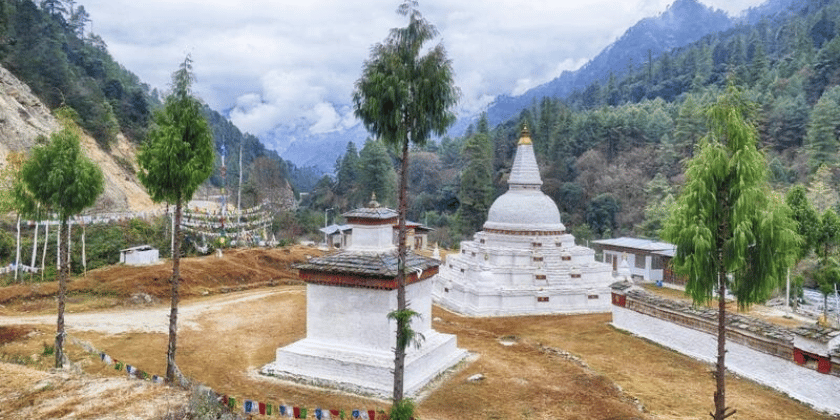
The chorten itself is an impressive structure, standing at a height of 26 meters (85 feet). It is a square-shaped structure with four entrances facing the four cardinal directions. The exterior of the chorten is adorned with intricate carvings and paintings, depicting scenes from the life of Buddha and other important Buddhist figures.
Visitors to Chendebji Chorten can explore the interior of the chorten, which houses a large prayer wheel and a central shrine room with a statue of Guru Rinpoche, a revered Buddhist master who is believed to have brought Buddhism to Bhutan. The shrine room is adorned with colorful paintings and murals depicting scenes from Buddhist teachings and legends.
Aside from its religious significance, Chendebji Chorten is also a popular destination for tourists looking to explore the natural beauty of the Trongsa district. The chorten is surrounded by lush green forests and hills, providing visitors with breathtaking views of the surrounding landscape.
One of the best times to visit Chendebji Chorten is during the annual Chendebji Tshechu, a religious festival held in honor of Guru Rinpoche. The festival is a vibrant and colorful celebration featuring traditional music, dance performances, and religious rituals.
In summary, Chendebji Chorten is an iconic and sacred Buddhist structure that provides visitors with a unique opportunity to explore the rich religious and cultural heritage of Bhutan. Whether you are a religious pilgrim or a curious traveler, a visit to Chendebji Chorten is an unforgettable experience that should not be missed.
- Zuri Dzong Trek
Zuri Dzong Trek is one of the most beautiful treks in Bhutan, offering stunning views of the Himalayas and the lush green valleys. Located in the Paro Valley of western Bhutan, this trek is a great way to experience the natural beauty and cultural richness of Bhutan.
The Zuri Dzong Trek begins with a visit to the famous Paro Taktshang Monastery, also known as the Tiger’s Nest. This famous Buddhist site is perched on a cliff 3,000 feet above the Paro Valley and is a must-visit for any tourist to Bhutan. After visiting the Tiger’s Nest, the trek starts from the base of the mountain and takes you through beautiful alpine forests, past pristine lakes and streams, and over high mountain passes.
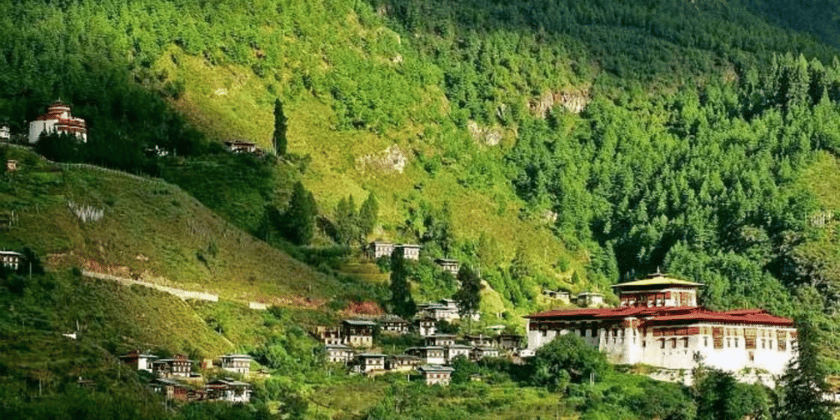
The trek covers a distance of approximately 47 kilometers and takes about 6 days to complete. The trek begins with a steep ascent through dense forests, with beautiful views of the surrounding mountains. You will also get to see some of the rare flora and fauna of Bhutan, including the blue poppy, Bhutan’s national flower.
As you climb higher, the terrain becomes more rugged, with rocky paths and steep ascents. You will cross several mountain passes, including the highest point on the trek, the Zuri La Pass, at an altitude of 4,220 meters. From here, you can enjoy breathtaking views of the snow-capped Himalayan peaks, including Mount Everest and Mount Kanchenjunga.
The Zuri Dzong Trek also takes you through several small villages, where you can experience the traditional Bhutanese way of life. You can interact with the locals, taste the local cuisine, and learn about the unique culture and customs of Bhutan.
The highlight of the trek is the Zuri Dzong, a beautiful fortress that was built in the 14th century. The Dzong is perched on a hilltop and offers panoramic views of the surrounding valleys and mountains. You can also visit the nearby Zuri Goempa, a small monastery that is home to a community of Buddhist monks.
The Zuri Dzong Trek is a moderate trek and requires a good level of fitness. The best time to visit is from March to June and from September to November, when the weather is dry and clear. The trek can be arranged through a licensed Bhutanese tour operator, who will provide a guide, accommodation, meals, and camping equipment.
In conclusion, the Zuri Dzong Trek is a fantastic way to explore the natural beauty and cultural richness of Bhutan. It offers a unique opportunity to experience the rugged terrain, stunning mountain vistas, and traditional Bhutanese way of life. If you are planning a trip to Bhutan, the Zuri Dzong Trek is definitely worth considering.
- Bumdeling Wildlife Sanctuary
Bumdeling Wildlife Sanctuary is a protected area in eastern Bhutan that offers tourists a unique opportunity to experience the rich biodiversity of the Himalayan region. The sanctuary is known for its diverse flora and fauna, including rare species like the Black-necked Crane, which is one of the most endangered bird species in the world. The sanctuary is also home to other wildlife like the Snow Leopard, Red Panda, and the Himalayan Black Bear.
The Bumdeling Wildlife Sanctuary is located in the northeastern part of Bhutan and covers an area of 1,520 square kilometers. The sanctuary is situated at an elevation of 1,500 to 6,000 meters and is surrounded by stunning landscapes, including snow-capped peaks, lush forests, and gushing rivers.
One of the major attractions of the Bumdeling Wildlife Sanctuary is the Black-necked Crane, which migrates to the region from Tibet during the winter months. The cranes are considered sacred by the Bhutanese people and are an important part of their culture and tradition. Tourists can witness the birds feeding and nesting in the sanctuary’s wetlands, which are also home to a variety of other bird species like the Rufous-necked Hornbill and the Satyr Tragopan.
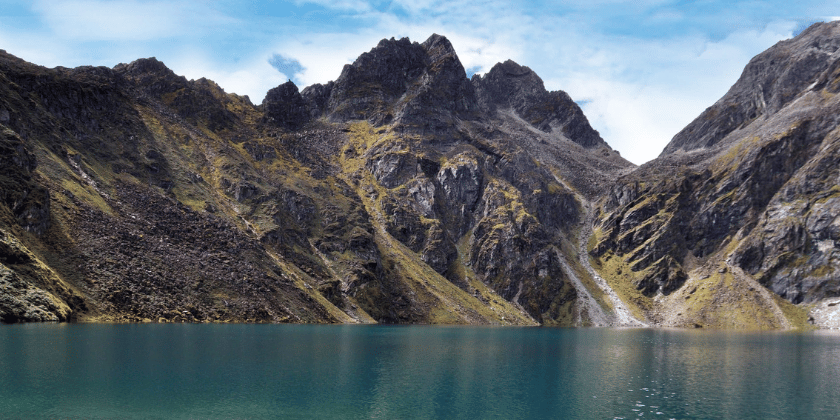
The Bumdeling Wildlife Sanctuary also offers tourists a chance to trek through its lush forests and scenic valleys. One of the popular trekking routes is the Bumdeling Trek, which takes visitors through the sanctuary’s pristine forests, alpine meadows, and remote villages. The trek offers stunning views of the surrounding Himalayan peaks and allows visitors to experience the rich culture and traditions of the local communities.
For those interested in wildlife, the Bumdeling Wildlife Sanctuary offers a range of activities like bird watching, nature walks, and wildlife safaris. Visitors can also explore the sanctuary’s rich flora, which includes rare species like the Himalayan Yew, a tree that is used to produce the anti-cancer drug, Taxol.
Accommodation in the Bumdeling Wildlife Sanctuary is limited, but visitors can stay at homestays in nearby villages, which offer an authentic cultural experience. Tourists can also visit the nearby town of Trashiyangtse, which is known for its traditional pottery and weaving techniques.
Overall, the Bumdeling Wildlife Sanctuary is a must-visit destination for nature lovers and adventure seekers. With its diverse wildlife, stunning landscapes, and rich cultural heritage, the sanctuary offers visitors a truly unique and unforgettable experience.
- Khoma Village
Khoma Village is a small and picturesque village located in the Lhuentse district of Bhutan. It is a popular tourist destination due to its unique textile industry and stunning natural beauty. As a visiting tourist, Khoma Village is a must-visit destination in Bhutan, offering a unique cultural experience and a chance to witness traditional weaving techniques.
The village is home to the Kishuthara weaving tradition, which is considered one of the most intricate and expensive forms of textile weaving in Bhutan. The women of the village are skilled in the art of weaving and use a backstrap loom to create these intricate textiles. The loom is tied around their waist and connected to a tree or post behind them, while the other end of the loom is tied around their feet. The weaver leans forward and backward to adjust the tension on the loom, while their hands work the shuttle and the thread.
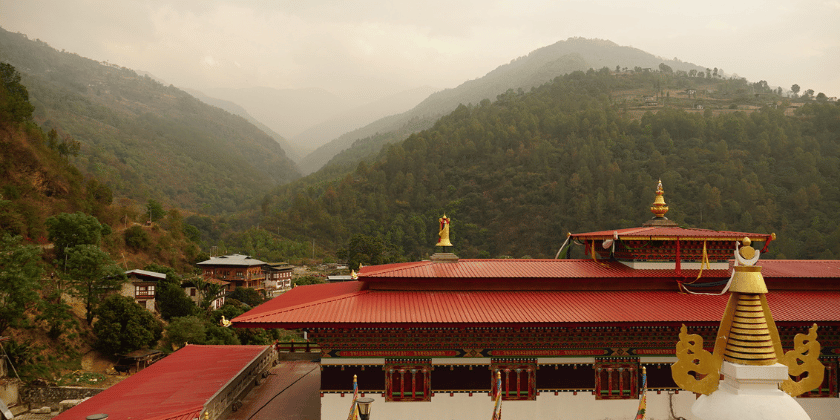
Visitors to Khoma Village can witness the weaving process and purchase beautiful and unique textiles made by the local artisans. The weavers are proud to share their tradition with visitors and are happy to explain the different patterns and motifs used in the textiles. The village also has a small museum dedicated to the history of Kishuthara weaving and the traditional dress of the Bhutanese people.
Aside from the textile industry, Khoma Village is also known for its stunning natural beauty. The village is situated in a valley surrounded by verdant forests and rolling hills. Visitors can take a leisurely walk around the village and enjoy the peaceful surroundings, or embark on a more challenging hike into the nearby mountains.
One of the most popular hikes in the area is the Lhuntse to Khoma Trek, which takes visitors through pristine forests and over high mountain passes. The trek provides breathtaking views of the surrounding landscape and offers a glimpse into the traditional way of life of the people living in the remote villages along the way.
Khoma Village is also known for its hospitality and warm welcome to visitors. The locals are friendly and eager to share their traditions and culture with tourists. Visitors can stay in traditional homestays and experience the daily life of the villagers, enjoying local food and customs.
In conclusion, Khoma Village is a must-visit destination for anyone interested in Bhutan’s unique culture and stunning natural beauty. It offers a chance to witness the intricate art of Kishuthara weaving, explore the surrounding mountains, and experience the hospitality of the local people. A visit to Khoma Village is sure to be a highlight of any trip to Bhutan.
- Gasa Hot Springs
Gasa Hot Springs in Bhutan: A Unique and Relaxing Experience for Tourists
Located in the picturesque district of Gasa, in the northern region of Bhutan, Gasa Hot Springs is a unique and relaxing destination for tourists seeking to unwind in the midst of nature. The natural hot springs are believed to have healing properties, and have been a popular destination for Bhutanese and visitors alike for centuries.
The journey to Gasa Hot Springs is an adventure in itself. The hot springs are nestled in a remote valley and can only be reached after a challenging six-hour trek through stunning landscapes of forests, mountains, and rivers. But the reward for this trek is well worth the effort. Upon arrival, visitors are greeted with a stunning view of the surrounding mountains and can enjoy the warm waters of the hot springs.
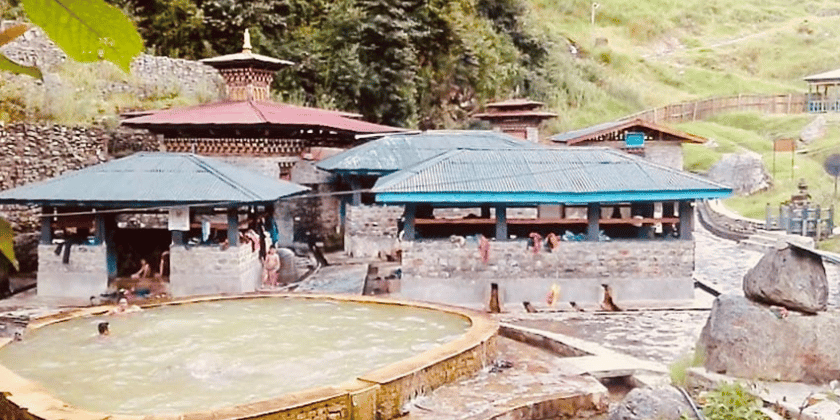
The hot springs themselves are a series of small, natural pools that are fed by the mineral-rich waters that flow from the mountain. The water temperature varies from pool to pool, and visitors can choose to soak in the temperature that suits them best. The water is known to contain a high concentration of minerals, such as sulfur, which are believed to have therapeutic properties that can help alleviate a range of ailments.
The hot springs are surrounded by lush vegetation, and the sound of the nearby river adds to the relaxing atmosphere. Visitors can also take a dip in the river or explore the nearby forest trails for a deeper immersion into the natural beauty of the area.
In addition to its natural beauty and therapeutic properties, Gasa Hot Springs also has a rich cultural history. The hot springs have been used for centuries by Bhutanese locals as a place for relaxation and healing. The Gasa Dzong, a historic fortress built in the 17th century, is also located nearby and is a popular destination for tourists interested in Bhutanese history and architecture.
Visitors to Gasa Hot Springs can stay at a nearby guesthouse, which offers comfortable accommodation and traditional Bhutanese hospitality. The guesthouse is located in the village of Gasa and offers a variety of services, including hot showers and a restaurant that serves traditional Bhutanese cuisine.
Overall, Gasa Hot Springs is a unique and memorable experience for tourists seeking a relaxing and natural escape in the midst of Bhutan’s stunning landscapes. With its therapeutic waters, cultural history, and natural beauty, it is a destination not to be missed.
- Pangbang Village
Pangbang Village in Bhutan is a quaint and picturesque village located in the southern part of the country. Situated in the district of Zhemgang, it is known for its beautiful landscapes, lush greenery, and unique cultural heritage. If you are planning to visit Bhutan, then Pangbang Village should be on your itinerary as it offers a unique and authentic Bhutanese experience.
Getting to Pangbang Village can be quite an adventure as the journey involves navigating through steep and winding mountain roads. However, the scenic beauty that surrounds the village makes the journey worthwhile. As you approach Pangbang Village, you will be greeted by rolling hills covered in lush green forests and fields of vibrant green rice paddies.
The village itself is a cluster of traditional Bhutanese houses made from mud and stones with intricately carved wooden balconies. As you wander through the village, you will encounter friendly locals going about their daily routines. You can observe the villagers engaging in traditional activities such as weaving, farming, and animal husbandry.
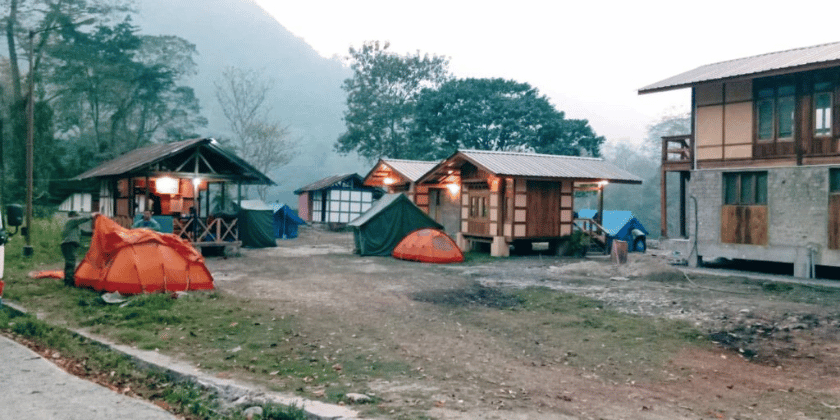
One of the major attractions in Pangbang Village is the Pangbang Lhakhang, a beautiful temple that is believed to have been built in the 16th century. The temple houses several ancient statues and frescoes that are of great religious and cultural significance. The annual Pangbang Tshechu, a festival that celebrates the life of Guru Rinpoche, is also held at the Pangbang Lhakhang and is a great time to witness the local culture and traditions.
Another unique aspect of Pangbang Village is its traditional textile industry. The village is known for its production of raw silk and cotton, and the local weavers are skilled in creating intricate patterns and designs. You can visit the village’s weaving centers to watch the artisans at work and even purchase some of their handmade textiles.
For nature enthusiasts, the Pangbang area offers several trekking and hiking opportunities. The village is located near the Jigme Singye Wangchuck National Park, which is home to a diverse range of flora and fauna, including rare and endangered species such as the black-necked crane and the snow leopard. The park also has several trekking trails that take you through the stunning landscape of the park, passing by waterfalls, rivers, and scenic viewpoints.
If you are looking for a place to relax and rejuvenate, then the Gasa Hot Springs are located nearby. The hot springs are known for their therapeutic properties and offer a great way to unwind after a long day of trekking or exploring the village.
Overall, Pangbang Village in Bhutan offers a unique and authentic experience of Bhutanese culture and traditions. Its beautiful landscape, traditional architecture, and local industries make it a must-visit destination for any traveler to Bhutan.
- Paro Valley
Paro Valley in Bhutan is a popular destination for tourists due to its stunning natural beauty, rich cultural heritage, and adventure activities. Located in the western part of Bhutan, Paro Valley is surrounded by towering mountain ranges and verdant forests, making it a scenic location for trekking, sightseeing, and exploring the local culture.
One of the most iconic attractions in Paro Valley is the Tiger’s Nest Monastery, also known as Paro Taktsang. The monastery is located on a cliff over 3,000 meters above sea level and is considered one of the most sacred sites in Bhutan. Legend has it that Guru Rinpoche, who is believed to have introduced Buddhism to Bhutan, flew to the site on the back of a tiger in the 8th century. Visitors can trek to the monastery and take in stunning views of the valley along the way.
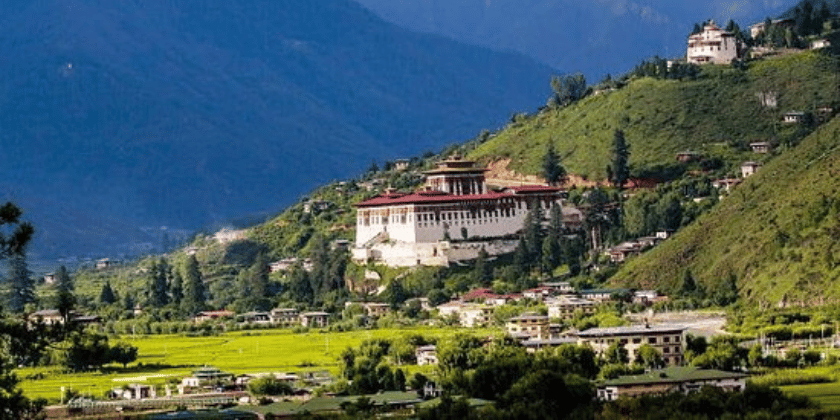
Another popular attraction in Paro is the Rinpung Dzong, a fortress-monastery built in the 17th century. The dzong houses the administrative offices of Paro district and also serves as a religious center. Visitors can explore the dzong’s intricate architecture and stunning wall paintings, and attend traditional Buddhist festivals that take place throughout the year.
Paro Valley is also home to many other significant religious sites, including Kyichu Lhakhang, one of the oldest temples in Bhutan. Visitors can admire the temple’s intricate carvings and paintings, and learn about its significance in Bhutanese history.
For those interested in outdoor activities, Paro Valley offers numerous opportunities for trekking, hiking, and mountain biking. The Chele La Pass, located at an altitude of 3,988 meters, is one of the highest motorable passes in Bhutan and offers stunning views of the valley below. The Jomolhari Trek, a popular multi-day trek, takes visitors through remote mountain villages, past glacial lakes, and across high mountain passes.
Paro Valley is also known for its rich cultural heritage and traditional handicrafts. Visitors can explore the town’s traditional architecture, browse local markets for hand-woven textiles and handicrafts, and sample traditional Bhutanese cuisine at local restaurants.
In conclusion, Paro Valley in Bhutan is a must-visit destination for those seeking natural beauty, adventure, and cultural immersion. Its iconic attractions such as the Tiger’s Nest Monastery and Rinpung Dzong, along with its opportunities for outdoor activities and traditional handicrafts, make it a truly unique and unforgettable experience for visitors.
- Jakar Dzong
Jakar Dzong, also known as the “Castle of the White Bird,” is one of the most famous and oldest dzongs in Bhutan. Located in the town of Jakar in the central region of the country, the dzong has a rich history and is a must-visit destination for tourists who want to learn more about Bhutanese culture and architecture.
History of Jakar Dzong Jakar Dzong was built in 1549 by Ngagi Wangchuk, the great-grandfather of the famous saint Pema Lingpa. The dzong was strategically built on a hilltop overlooking the Chokhor Valley to serve as a fortress to protect against Tibetan invasions. Over the years, the dzong has undergone numerous renovations and repairs, with the most recent one taking place in the 1990s.
Architecture of Jakar Dzong Jakar Dzong is built in the traditional Bhutanese architectural style with thick walls and tall towers. The dzong is spread over a large area and has multiple courtyards, temples, and administrative offices. The most notable feature of the dzong is its central tower, which stands at 30 meters tall and is adorned with intricate carvings and paintings.
The dzong also has a large prayer hall where important religious ceremonies and events are held. Visitors can see the detailed murals and paintings on the walls of the prayer hall, which depict scenes from Buddhist teachings and legends.
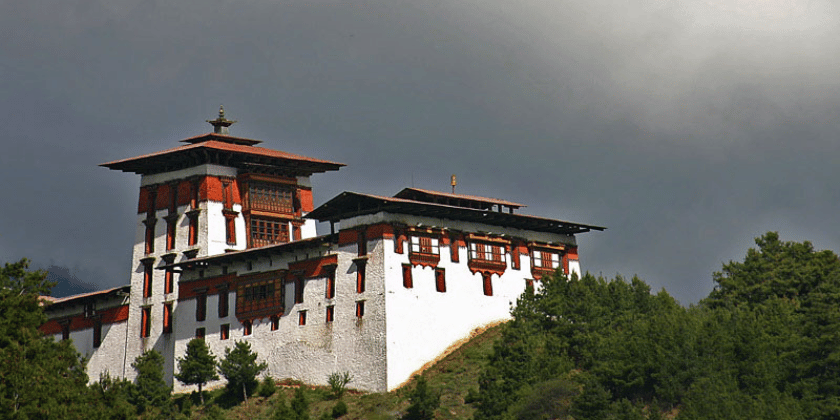
Visiting Jakar Dzong To enter the dzong, visitors must first cross a wooden bridge over the river and climb up a steep set of stairs. Once inside, visitors can explore the various courtyards and temples, including the main prayer hall, which is the most sacred part of the dzong. Visitors can also visit the administrative offices and learn more about the history and significance of the dzong from the local guides.
One of the best times to visit Jakar Dzong is during the Jakar Tshechu festival, which takes place every year in the Bhutanese lunar calendar. During the festival, locals and tourists gather to watch traditional dances, masked performances, and religious ceremonies, and the dzong is beautifully decorated with colorful banners and lights.
In conclusion, Jakar Dzong is a must-visit destination for anyone interested in Bhutanese history and architecture. With its rich history, stunning architectural design, and breathtaking views of the Chokhor Valley, the dzong is a symbol of Bhutanese culture and tradition.
- Talo Village
Talo Village: A Serene Escape in Bhutan
Tucked away in the mountains of Bhutan lies a serene village known as Talo. The village is located in the Punakha district of western Bhutan and is a popular destination for tourists seeking a peaceful escape from the hustle and bustle of city life. The village is located at an elevation of 2,800 meters and is surrounded by lush green forests, terraced fields, and traditional Bhutanese houses. Here is a unique and detailed article on Talo Village in Bhutan from a visiting tourist’s perspective.
History of Talo Village
Talo Village is one of the oldest settlements in Bhutan and has a rich cultural and historical significance. The village was established in the 13th century and is believed to have been founded by a Bhutanese saint known as Pema Lingpa. The saint is revered in Bhutanese culture for his spiritual teachings and his contributions to the development of the country.
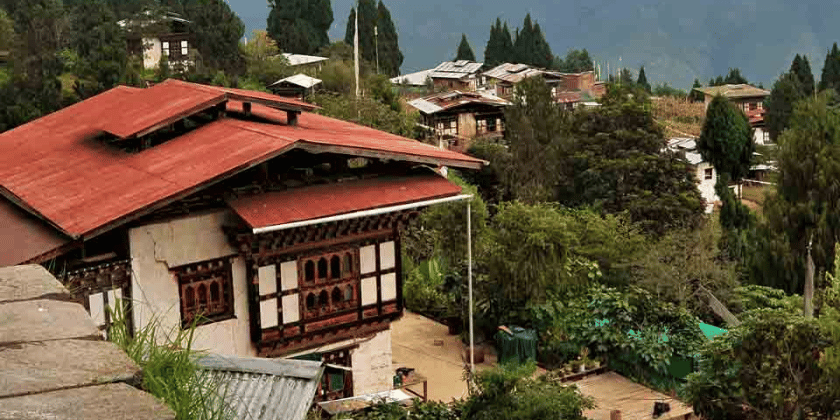
The village is also known for its traditional architecture and is home to some of the most well-preserved Bhutanese houses in the country. The houses are built using locally-sourced materials such as wood, stone, and clay, and are designed to withstand the harsh mountain weather.
Things to do in Talo Village
- Visit Talo Monastery: Talo Monastery is one of the main attractions in the village and is a must-visit for anyone interested in Bhutanese culture and history. The monastery is located on a hill overlooking the village and offers stunning views of the surrounding mountains and valleys. It is known for its intricate carvings and paintings and is home to some of the most well-preserved religious artifacts in Bhutan.
- Explore the village: Talo Village is a great place to explore on foot. The village is home to several traditional Bhutanese houses and offers visitors a glimpse into the daily lives of the locals. The terraced fields in the village are also a great place to take a stroll and enjoy the natural beauty of the area.
- Attend a local festival: Talo Village is known for its vibrant festivals, which are held throughout the year. The festivals are a great way to experience Bhutanese culture and are marked by traditional dances, music, and food.
- Trekking: Talo village is located near the Jigme Dorji National Park, which is one of the best trekking destinations in Bhutan. Treks to the park offer visitors a chance to experience the natural beauty of the area and spot some of the unique wildlife found in Bhutan.
- Visit the Royal Botanical Garden: The Royal Botanical Garden in Talo Village is a must-visit for nature lovers. The garden is home to a wide variety of plants and flowers, many of which are native to Bhutan.
Accommodation in Talo Village
Talo Village offers visitors a range of accommodation options, including traditional Bhutanese guesthouses and modern hotels. Most of the accommodation options in the village offer stunning views of the surrounding mountains and valleys, and are located within walking distance of the main attractions in the area.
Getting to Talo Village
Talo Village is located approximately 30 kilometers from Punakha and can be reached by car or bus. The journey takes around 1 hour and offers visitors stunning views of the surrounding mountains and valleys.
Conclusion
Talo Village is a serene and peaceful escape in Bhutan that offers visitors a chance to experience the natural beauty and rich culture of the country. The village is home to several historical and cultural attractions, as well as some of the most well-preserved Bhutanese houses in the country. Whether you are interested in trekking, exploring the local culture, or simply taking a break from the hustle and bust
- Mongar Dzong
Mongar Dzong is an impressive fortress located in the eastern region of Bhutan. The dzong is perched on a hilltop, overlooking the town of Mongar, and is one of the newer dzongs in the country. Built in the 1930s, Mongar Dzong is a testimony to the Bhutanese architectural style and is a must-visit destination for anyone traveling to Bhutan.
The dzong was built by the third king of Bhutan, Jigme Dorji Wangchuck, to replace an earlier fortress that had been destroyed by fire. The construction of the dzong took nearly a decade and was completed in 1953. The dzong serves as the administrative center for the Mongar district and is also home to a monastic community.
One of the unique features of Mongar Dzong is its location. Unlike most other dzongs in Bhutan, which are built on flat land, Mongar Dzong is perched on a steep hilltop. The dzong is accessible only by a steep stone staircase that leads up to the entrance gate. Once inside the dzong, visitors are greeted by a large courtyard, surrounded by administrative offices, living quarters for the monastic community, and a temple.
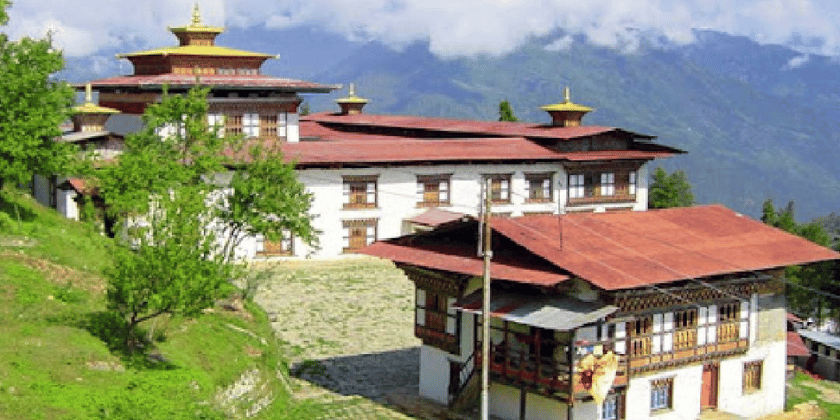
The main temple inside the dzong is dedicated to the Buddhist deity, Mahakala. The temple is adorned with beautiful murals and statues, and visitors can witness the daily prayers and rituals performed by the monks. Another highlight of the dzong is the stunning view it offers of the surrounding valley and the distant mountains. The view is particularly beautiful at sunset when the sun bathes the valley in a warm, golden glow.
Visitors to Mongar Dzong can also explore the town of Mongar, which is known for its lively markets and traditional Bhutanese architecture. The town is situated on a hillside, and visitors can enjoy a scenic stroll through the town’s winding streets, lined with shops selling local handicrafts, fresh produce, and other goods.
Overall, Mongar Dzong is a fascinating destination that offers visitors a glimpse into Bhutan’s rich history and culture. The stunning location, beautiful architecture, and peaceful surroundings make it an ideal destination for anyone looking to experience the beauty and tranquility of Bhutan.
- Taktshang Goemba Trek
Taktshang Goemba, also known as Tiger’s Nest Monastery, is a sacred Buddhist site located in the Paro Valley of Bhutan. Perched on the edge of a steep cliff, this beautiful and unique monastery is one of Bhutan’s most iconic landmarks and a popular destination for visitors to the country. The Taktshang Goemba Trek is an unforgettable experience that allows visitors to explore the monastery and its surrounding area while taking in stunning views of the Himalayan landscape.
The Taktshang Goemba Trek begins in Paro, where visitors will need to obtain a permit to enter the monastery. The trek is a challenging one, but it is well worth the effort for the breathtaking views and unique cultural experience. The hike takes approximately two to three hours to complete, depending on the fitness level of the hiker.
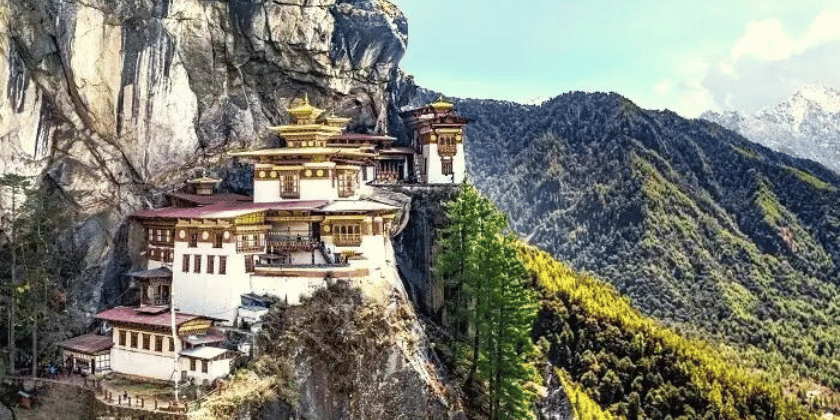
The trail is steep and rugged, with switchbacks and stairs leading up to the monastery. Along the way, hikers will pass through a beautiful forest of blue pine trees, which provides shade from the sun and a refreshing break from the heat. The trail is well-maintained, and there are plenty of rest areas and viewpoints to take in the scenery.
As hikers approach the monastery, they will be greeted with a stunning view of the monastery perched on the edge of a cliff. The monastery was built in the 17th century and is considered one of Bhutan’s most sacred sites. It is believed that Guru Rinpoche, the founder of Tibetan Buddhism, flew to this location on the back of a tiger and meditated in a cave here for three months.
The monastery consists of four main temples, each with its own unique architecture and design. Visitors are free to explore the temples and take in the intricate artwork and religious artifacts on display. The main temple, called the Guru Rinpoche Temple, is home to a statue of Guru Rinpoche and is considered the most sacred of the four temples.
Visitors are also welcome to explore the surrounding area, which is home to several meditation caves and waterfalls. The caves are believed to have been used by Guru Rinpoche during his time at the monastery, and visitors can still see the meditation cushions and offerings left behind by previous visitors.
The Taktshang Goemba Trek is an unforgettable experience that offers visitors a glimpse into Bhutan’s unique culture and natural beauty. From the challenging hike to the stunning views and sacred temples, this trek is an absolute must-see for anyone visiting Bhutan.
- Dechenphu Lhakhang
Dechenphu Lhakhang is a famous Buddhist temple located in Thimphu, the capital city of Bhutan. The temple is situated on a hill above Thimphu and offers stunning views of the city and surrounding mountains. It is one of the most popular places of worship in Bhutan, and it attracts a large number of tourists and locals alike.
As you make your way up the hill towards Dechenphu Lhakhang, you will be struck by the peaceful atmosphere and beautiful scenery. The climb is steep in places, but the journey is well worth it when you reach the top. The temple is surrounded by lush green forests and a serene environment, making it an ideal place for meditation and reflection.
Dechenphu Lhakhang is also known for its intricate architecture and beautiful paintings. The temple is believed to have been built in the 15th century by a famous Bhutanese saint named Lama Ngawang Chogyel. The temple features intricate carvings, colorful murals, and stunning frescoes that depict various aspects of Buddhism and Bhutanese culture.
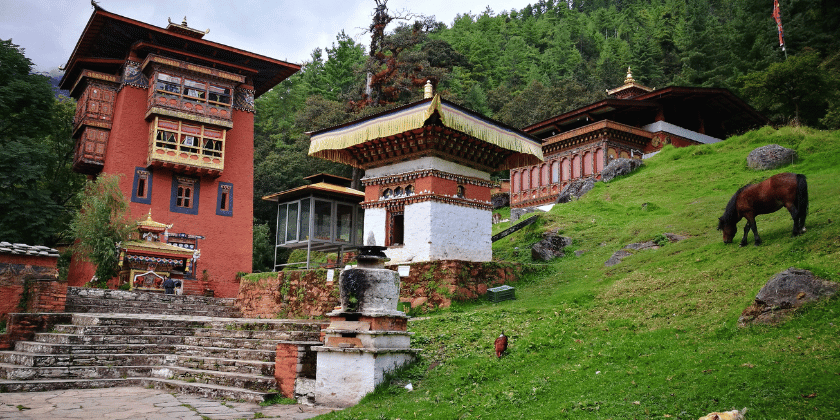
One of the main attractions of Dechenphu Lhakhang is the statue of Guru Rinpoche, also known as Padmasambhava, who is considered to be the patron saint of Bhutan. The statue is located inside the main shrine room and is surrounded by offerings of flowers and incense. The shrine room also features beautiful paintings of various Buddhist deities and religious figures.
Dechenphu Lhakhang is not just a place of worship, but it also serves as an important cultural and social center in Thimphu. The temple hosts several cultural events and festivals throughout the year, including the popular annual Thimphu Tshechu festival. During the festival, locals and tourists gather to witness traditional dances and performances, enjoy delicious food, and participate in religious ceremonies.
In conclusion, Dechenphu Lhakhang is a must-visit destination for anyone traveling to Bhutan. The temple’s serene atmosphere, stunning views, and intricate architecture are sure to leave a lasting impression on visitors. Whether you are a Buddhist or simply interested in exploring Bhutanese culture, Dechenphu Lhakhang is a must-see attraction that should not be missed.
- Lhuentse
Lhuentse is a picturesque district located in the northeastern part of Bhutan, known for its stunning landscapes, rich culture, and historic landmarks. As a visiting tourist, there are plenty of experiences to be had in Lhuentse, ranging from exploring ancient temples to hiking through pristine forests. In this article, we will take a closer look at what Lhuentse has to offer and what you can expect as a tourist.
One of the highlights of Lhuentse is its impressive dzong. The Lhuentse Dzong is perched on a hill overlooking the Kurichu River, and it is one of the largest and most majestic dzongs in Bhutan. Built in the 17th century, the dzong is a masterpiece of Bhutanese architecture and is still in use as a government administrative building and religious center. Visitors can explore the dzong’s intricate wooden carvings, beautiful frescoes, and stunning courtyards, all while taking in the sweeping views of the surrounding valley.
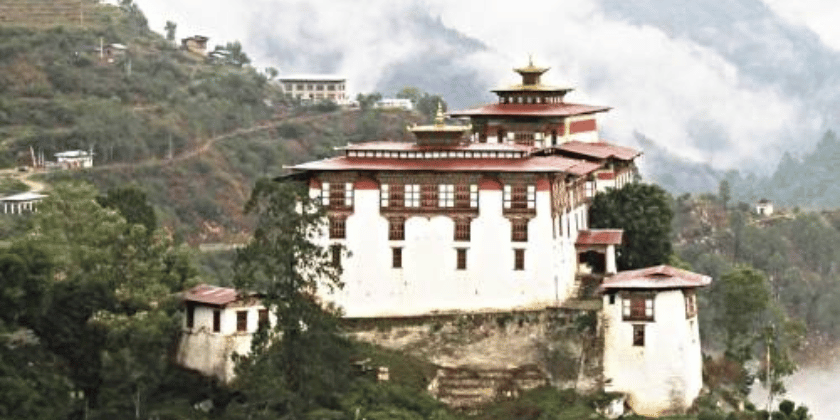
Another must-see attraction in Lhuentse is the Khoma Village, famous for its intricately woven kushuthara textiles. Kushuthara is a traditional Bhutanese fabric made by expert weavers who use a backstrap loom to create intricate patterns and designs. Visitors to Khoma Village can watch these talented weavers in action and even purchase their own kushuthara garments to take home as souvenirs.
For those looking for a more active experience, Lhuentse also offers some great hiking opportunities. One popular trek is the Duer Hot Springs Trek, which takes you through dense forests, past rushing rivers, and over high mountain passes. The trek culminates at the Duer Hot Springs, where you can relax in the warm waters and take in the stunning views of the surrounding mountains.
Another great hiking option is the Singye Dzong Trek, which takes you to an ancient fortress located high in the mountains. The trek is challenging but rewarding, with stunning views at every turn and plenty of opportunities to spot local wildlife along the way.
As you explore Lhuentse, you’ll also have the chance to experience Bhutanese culture up close. The locals are friendly and welcoming, and you can often participate in traditional dances, music performances, and religious ceremonies during your stay. One particularly interesting cultural attraction is the Koma Tshechu, a colorful festival held every year in Khoma Village to celebrate Bhutanese culture and history.
In terms of accommodations, Lhuentse offers a range of options to suit different budgets and preferences. There are several guesthouses and homestays in the area that provide comfortable lodgings and authentic Bhutanese meals. Alternatively, you can opt to stay in one of the more upscale hotels or resorts in the nearby town of Mongar.
Overall, Lhuentse is a must-visit destination for anyone traveling to Bhutan. Its stunning scenery, rich culture, and historic landmarks make it a truly unique and unforgettable experience. Whether you’re interested in hiking, exploring ancient temples, or simply soaking up the local culture, Lhuentse has something to offer everyone.
- Jigme Singye Wangchuck National Park
Jigme Singye Wangchuck National Park, named after the fourth King of Bhutan, is one of the largest national parks in the country. Located in central Bhutan, the park covers an area of over 1,700 square kilometers and is home to a wide range of flora and fauna, including several endangered species. A visit to Jigme Singye Wangchuck National Park is a must for any nature enthusiast, and offers an unforgettable experience to visitors.
As you enter the park, you will be greeted by a stunning landscape of rolling hills, thick forests, and pristine rivers. The park is known for its diverse range of habitats, which include alpine meadows, temperate forests, and subtropical jungles. This diversity of habitats makes the park a haven for a variety of wildlife species, including tigers, snow leopards, red pandas, Himalayan black bears, and many more.
The park is also a birdwatcher’s paradise, with over 450 species of birds recorded within its boundaries. The park’s birdlife includes several species of pheasants, such as the beautiful Himalayan monal and the endangered white-bellied heron.
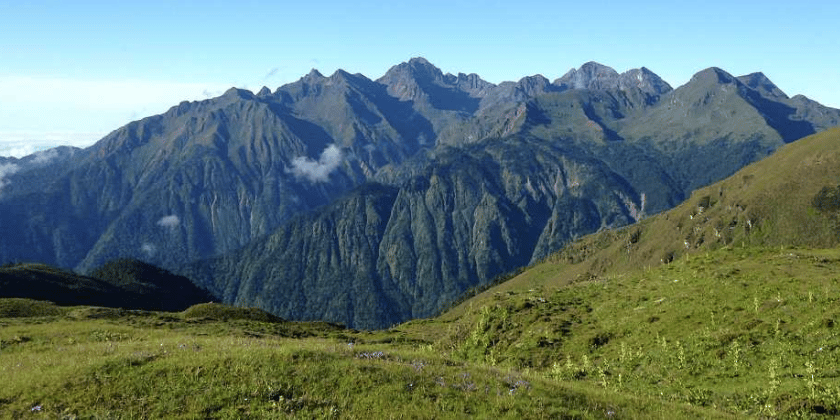
A popular attraction within the park is the Phobjikha Valley, also known as the “Gangtey Valley,” which is a glacial valley that is home to the endangered black-necked crane. These majestic birds arrive in the valley every winter, after their long migration from Tibet, and are a sight to behold as they roost in the wetlands and feed on the valley’s vegetation.
Another attraction within the park is the Bumdeling Wildlife Sanctuary, which is located in the northeastern part of the park. The sanctuary is home to the rare and endangered white-bellied heron, as well as several other bird and mammal species.
Visitors to the park can participate in a variety of activities, including trekking, birdwatching, and camping. The park offers several trekking routes, ranging from easy day hikes to challenging multi-day treks, all of which offer stunning views of the park’s landscape and wildlife.
Camping is also a popular activity within the park, and visitors can set up their tents at designated campsites or stay in one of the park’s eco-lodges. These lodges offer comfortable accommodation in the heart of the park, and provide visitors with an immersive nature experience.
Overall, a visit to Jigme Singye Wangchuck National Park is a must for anyone who loves nature and wildlife. With its stunning landscape, diverse range of habitats, and wide range of flora and fauna, the park offers an unforgettable experience to visitors and is a true gem of Bhutan’s natural heritage.
- Tangbi Goemba
Tangbi Goemba, also known as Tang Rimochen Lhakhang, is a revered Buddhist monastery located in the picturesque village of Tangbi in the Bumthang district of Bhutan. It is one of the oldest monasteries in the region and is highly revered by the local community. The monastery is located on a hill overlooking the village, offering panoramic views of the surrounding landscape.
As a visiting tourist, a visit to Tangbi Goemba offers a unique insight into Bhutan’s rich cultural and religious heritage. The monastery is easily accessible by road from Bumthang town and can be reached after a short 30-minute drive through scenic countryside. Upon arrival, visitors are greeted by the serene and peaceful atmosphere of the monastery, with the sound of prayer flags fluttering in the wind and the aroma of burning incense in the air.
The main prayer hall of Tangbi Goemba is an impressive sight to behold. The walls of the hall are adorned with intricate murals depicting various Buddhist deities and scenes from Buddhist mythology. The highlight of the prayer hall is the statue of Guru Rinpoche, the legendary Indian saint who introduced Buddhism to Bhutan in the 8th century. The statue is said to have been blessed by Guru Rinpoche himself and is therefore considered to be highly sacred.
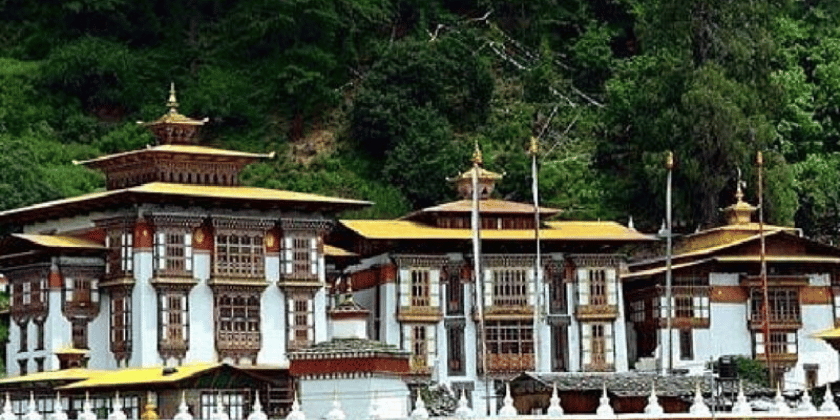
Another interesting feature of Tangbi Goemba is the temple’s library, which contains a rare collection of ancient Buddhist texts and scriptures. The library is open to visitors, and those interested in learning more about Bhutan’s religious and cultural history can spend hours exploring the collection of books and manuscripts.
For those interested in exploring the surrounding area, there are several short hiking trails that lead from the monastery to nearby villages and valleys. The village of Tangbi itself is also worth exploring, with its traditional Bhutanese architecture and friendly locals. Visitors can also witness the daily life of the monks who reside at the monastery, who can often be seen going about their daily routines, praying, meditating, and engaging in other monastic activities.
In conclusion, Tangbi Goemba is a must-visit destination for anyone interested in exploring Bhutan’s rich cultural and religious heritage. The monastery’s serene and peaceful atmosphere, ancient murals, and rare collection of books and manuscripts make it a unique and unforgettable destination. Whether you’re a seasoned traveler or a first-time visitor to Bhutan, a visit to Tangbi Goemba is sure to be a highlight of your trip.
- Merak and Sakteng Trek
Merak and Sakteng Trek in Bhutan is a unique and adventurous journey that takes you to the easternmost part of the country, offering a glimpse into the traditional lifestyles of the nomadic Brokpa people. The trek covers two remote villages of Merak and Sakteng, located in the midst of the spectacular landscape of the Sakteng Wildlife Sanctuary.
Starting from the small town of Trashigang, the trek takes about six days to complete and covers a distance of approximately 50 kilometers. It is a moderate to challenging trek that requires a good level of physical fitness, as the trail climbs up and down through the rugged terrain of the Himalayan foothills.
The trek starts with a drive from Trashigang to Chaling, where you can visit the Chaling monastery and enjoy the panoramic view of the surrounding landscape. From there, the trail winds through dense forests of rhododendrons and pine trees, with occasional views of the snow-capped peaks in the distance.
On the third day of the trek, you will reach the remote village of Merak, where you will spend a night in a traditional Brokpa house. The Brokpa people are known for their unique way of life and their ability to survive in the harsh mountain environment. They have a rich culture and tradition that is different from the rest of Bhutan and have preserved their way of life for centuries.
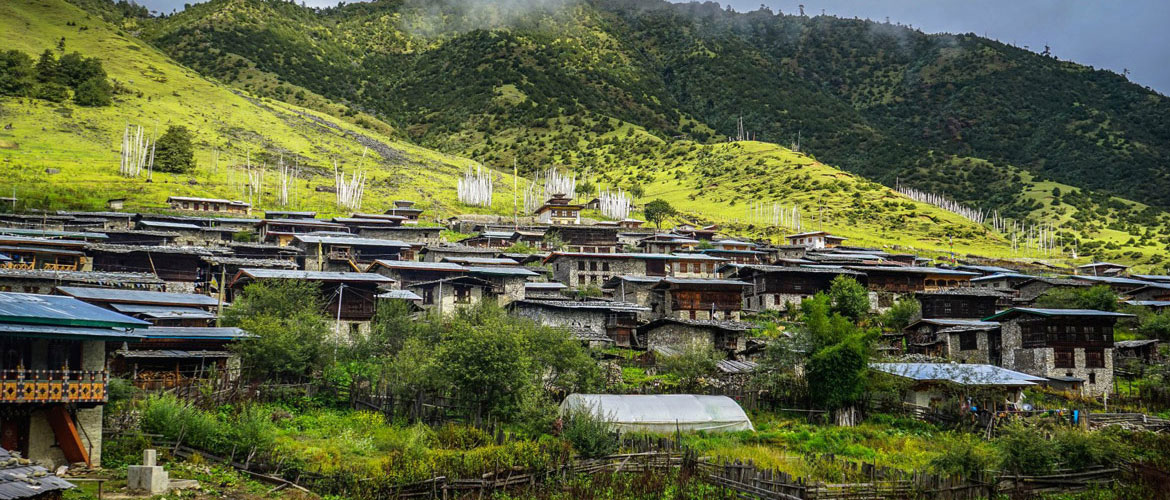
From Merak, the trek continues to Sakteng, passing through picturesque valleys, dense forests, and rolling hills. Sakteng is another remote village, located at an altitude of 3,500 meters, and is the gateway to the Sakteng Wildlife Sanctuary. Here, you can explore the sanctuary and spot some of the rare and endangered species of flora and fauna that call this place home, such as the snow leopard, Himalayan black bear, and the red panda.
The trek ends with a visit to the Sakteng Dzong, a fortress that was built in the 8th century and is one of the oldest dzongs in Bhutan. It is also the center of the local administration and is used as a venue for various cultural events and festivals.
Overall, the Merak and Sakteng Trek offers a unique and unforgettable experience of Bhutan’s rich culture, natural beauty, and biodiversity. It is a perfect way to explore the lesser-known parts of Bhutan and immerse yourself in the traditional way of life of the Brokpa people.
- Dochula Druk Wangyal Chortens
Dochula Druk Wangyal Chortens, located in the Dochula Pass, is one of the most popular tourist destinations in Bhutan. The pass, situated at an altitude of 3,140 meters, offers breathtaking views of the Himalayan mountain range and is also home to 108 chortens built in honor of Bhutanese soldiers who died fighting insurgents from India in 2003.
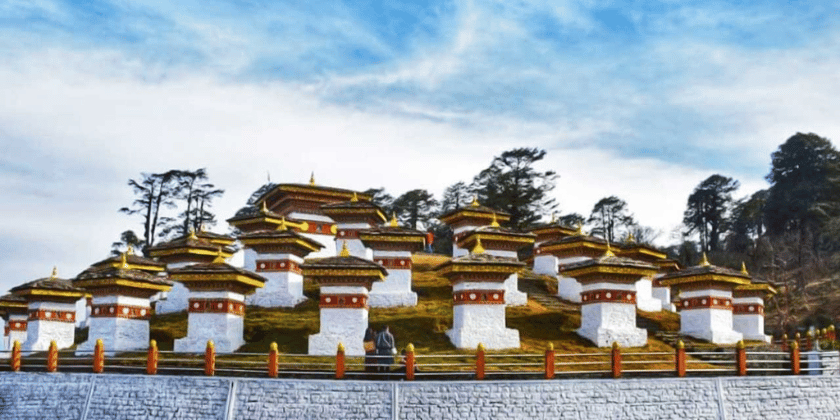
As a visiting tourist, there are several reasons why you should add a visit to Dochula Druk Wangyal Chortens to your itinerary:
- Scenic beauty: The Dochula Pass offers panoramic views of the Himalayan mountain range, making it a popular spot for photographers and nature enthusiasts. The area is surrounded by lush green forests and is home to a variety of wildlife, including macaques, barking deer, and Himalayan black bears.
- Cultural significance: The 108 chortens that dot the pass are not only a symbol of Bhutanese culture but also pay tribute to the brave soldiers who fought and died for their country. Each chorten is beautifully adorned with intricate carvings and colorful prayer flags, making it a must-visit destination for those interested in Bhutanese culture and history.
- Religious significance: The chortens are not just decorative, but also serve as a place of worship for the locals. Visitors can see people offering prayers and lighting butter lamps at the base of the chortens, creating a serene and peaceful atmosphere.
- Outdoor activities: The Dochula Pass is also a popular destination for hiking and trekking enthusiasts. The surrounding hills offer a variety of trails, ranging from easy walks to challenging hikes, and provide an excellent opportunity to explore the beautiful natural surroundings.
- Local cuisine: The area around the Dochula Pass is also home to several local restaurants that serve traditional Bhutanese cuisine. Visitors can sample local delicacies like Ema Datshi (chilies and cheese), Phaksha Paa (pork curry), and Jasha Maroo (spicy chicken).
In conclusion, a visit to Dochula Druk Wangyal Chortens is a must for any tourist visiting Bhutan. The stunning natural beauty, cultural significance, and outdoor activities make it a perfect destination for travelers of all interests. Don’t forget to bring your camera and hiking boots!
- Thangtong Dewachen Nunnery
Thangtong Dewachen Nunnery, also known as Zangtopelri Nunnery, is a beautiful Buddhist nunnery located in the capital city of Bhutan, Thimphu. This unique nunnery is not only a place of worship but also a place of cultural and educational importance. It is an ideal place for those who seek peace and tranquility and wish to learn about Bhutanese culture and Buddhism.
History
The nunnery was founded in 1976 by the 16th Karmapa, Rangjung Rigpe Dorje, as a way to provide an education and spiritual guidance to young girls and women in Bhutan. The Karmapa, who was a prominent figure in Tibetan Buddhism, envisioned the nunnery as a way to empower women in Bhutan and promote gender equality. The nunnery was built with the help of local villagers and has since become a prominent religious and cultural institution in Bhutan.
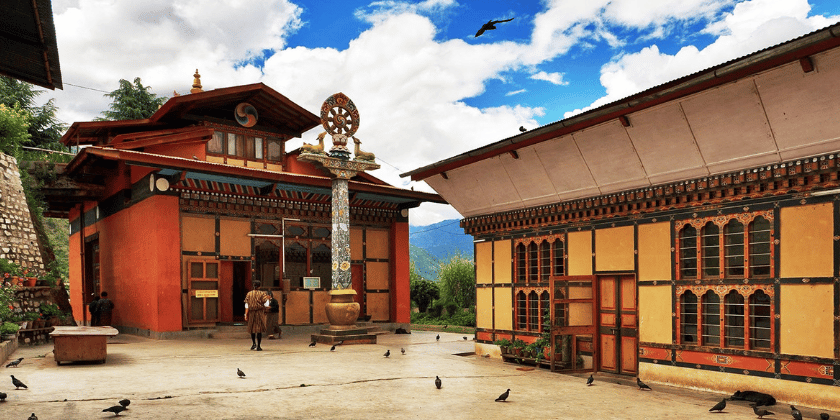
Architecture
The nunnery is situated on a hill overlooking the Thimphu Valley and has a breathtaking view of the surrounding mountains. The nunnery’s architectural style is typical of Bhutanese buildings with colorful paintings and intricate wood carvings. The main temple of the nunnery is adorned with beautiful murals and thangkas (Buddhist paintings) that depict scenes from the life of Buddha and other Buddhist deities.
Activities
Thangtong Dewachen Nunnery offers a variety of activities for tourists to experience Bhutanese culture and Buddhism. Visitors can attend morning and evening prayers at the main temple where the nuns chant mantras and perform various rituals. The nunnery also offers traditional Bhutanese food and tea, which visitors can enjoy while taking in the peaceful surroundings.
One of the unique features of the nunnery is the Chorten Kora, a large stupa that houses over 1000 miniature stupas. Visitors can walk around the Chorten Kora while reciting prayers and spinning prayer wheels. This activity is said to bring good fortune and purification of negative karma.
Visitors can also participate in meditation and yoga classes at the nunnery. These classes are led by experienced nuns and are a great way to learn about Buddhist philosophy and practices.
Conclusion
Thangtong Dewachen Nunnery is a must-visit destination for those interested in Bhutanese culture and Buddhism. The nunnery’s peaceful surroundings and stunning views make it an ideal place for meditation and reflection. Visitors can learn about the role of women in Buddhism and Bhutanese culture and experience traditional Bhutanese food and tea. With its unique architecture and rich history, Thangtong Dewachen Nunnery is a truly unforgettable experience.
- Royal Botanical Park
Royal Botanical Park, located in Lamperi, is a magnificent natural attraction in Bhutan. It is a must-visit for nature enthusiasts and those who appreciate the natural beauty of flora and fauna. The park is home to a diverse range of plant species, including medicinal plants, rare orchids, rhododendrons, and bamboos. The park also houses various species of animals, such as the red panda, barking deer, and sambar deer.
Upon entering the park, visitors are welcomed by the beautiful floral displays at the entrance gate. As you walk further into the park, you’ll be surrounded by lush greenery and towering trees. The park is well-maintained, and there are well-paved trails that make it easy for visitors to explore.
One of the most impressive features of the park is the rhododendron garden, which boasts over 46 species of rhododendrons. The garden is in full bloom from April to June and is a treat for the eyes. The bamboo garden is another must-see attraction in the park, where visitors can witness the diversity of bamboos found in Bhutan.
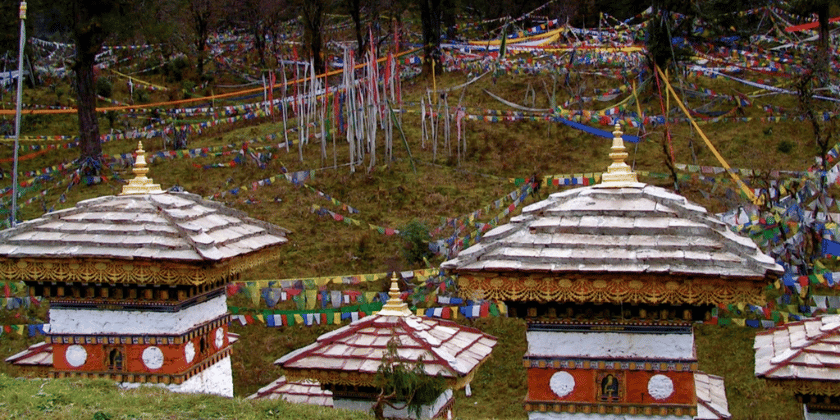
The park is also home to a wide variety of birds, and bird enthusiasts can enjoy spotting rare species like the yellow-billed magpie and the Himalayan monal. There are bird watching towers scattered throughout the park that offer a unique perspective of the surrounding natural beauty.
One of the most popular hiking trails in the park is the Dochula Nature Trail, which takes visitors through the dense forests, bamboo groves, and rhododendron gardens. The trail also provides excellent views of the surrounding mountains and valleys.
For those who want to take a break from the hikes, there is a picnic area with benches and tables where visitors can relax and enjoy a packed lunch. The park also has a cafeteria that serves simple meals and beverages.
Overall, the Royal Botanical Park in Bhutan is a fascinating and educational experience for nature lovers. The park is well worth the visit and offers a peaceful respite from the hustle and bustle of daily life.
- Ugyen Wangchuck Institute for Conservation and Environmental Research
The Ugyen Wangchuck Institute for Conservation and Environmental Research (UWICER) in Bhutan is a research and training institute dedicated to promoting environmental conservation and sustainable development in the country. As a visiting tourist, UWICER provides a unique opportunity to learn about Bhutan’s conservation efforts and witness the country’s stunning natural beauty.
Located in the Wangchuck Centennial Park, UWICER was established in 2014 and is named after Bhutan’s first king, Ugyen Wangchuck. The institute conducts research on a range of environmental issues, including biodiversity conservation, climate change, and sustainable development. UWICER also provides training and education programs for Bhutanese citizens, including courses on environmental management, conservation biology, and sustainable agriculture.
Visitors to UWICER can take part in guided tours of the institute’s facilities and learn about the ongoing research and conservation projects. The institute features a research center, library, auditorium, and guesthouse for researchers and visitors. The center also has a butterfly garden, where visitors can learn about Bhutan’s butterfly species and their importance to the ecosystem.
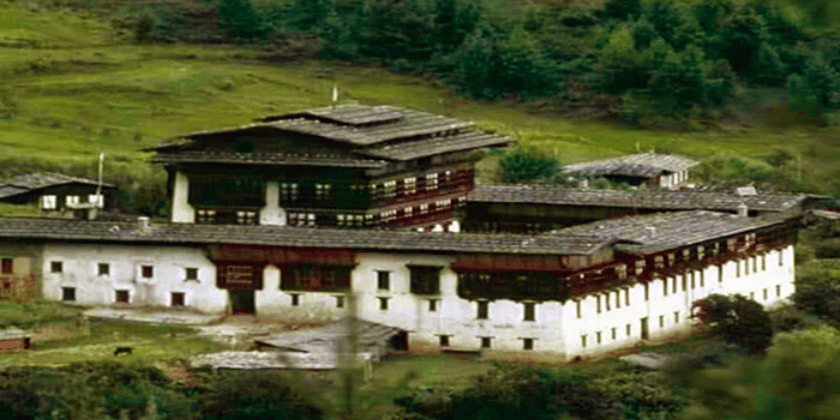
One of the highlights of a visit to UWICER is exploring the nearby Wangchuck Centennial Park. Covering an area of over 4,900 square kilometers, the park is home to a diverse range of wildlife, including tigers, snow leopards, and Himalayan black bears. The park also contains several important cultural sites, including the 16th-century Chendebji Chorten.
UWICER offers a unique perspective on Bhutan’s approach to environmental conservation and sustainable development. As a country that is often cited as a model for environmental sustainability, Bhutan’s conservation efforts have gained international attention. Visiting UWICER is an excellent way to learn about Bhutan’s conservation efforts and explore the country’s stunning natural landscapes.
- Dobji Dzong
Dobji Dzong, located in the picturesque mountains of Bhutan, is a unique and historic fortress that is well worth a visit for any tourist interested in Bhutanese architecture and culture. The Dzong, also known as Dobji Lhakhang, is situated in the district of Paro, just a few hours’ drive from Bhutan’s capital city of Thimphu.
The history of Dobji Dzong dates back to the 16th century, and it was initially built as a temple by the famous Tibetan lama, Thangtong Gyalpo. However, in the 17th century, the Bhutanese rulers transformed the temple into a fortress to protect the region from invading Tibetan armies. Since then, the Dzong has played a crucial role in the country’s history and served as a significant administrative center for the Paro district.
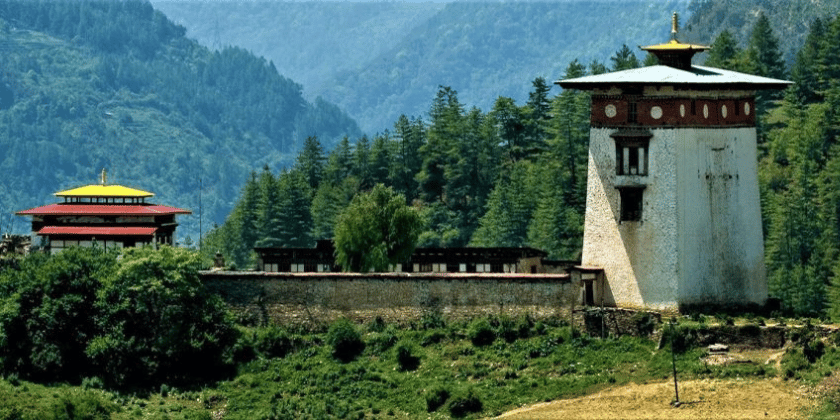
The Dzong’s architecture is typical of Bhutanese fortress style, with thick walls and narrow, winding passages. Visitors can see a unique feature of the Dzong’s architecture- the zig-zag bridge that leads to the main entrance of the fortress. This bridge is not only a unique design feature but also a strategic one. It was built in such a way that the enemy had to walk in a zig-zag pattern to get to the entrance, making it easier for the defenders to shoot arrows at them.
Inside the Dzong, visitors can see several chapels and temples that reflect Bhutan’s rich religious and cultural heritage. One of the main attractions is the statue of Chenrezig, the Bodhisattva of compassion. Visitors can also see various murals and frescoes that depict important events and personalities from Bhutan’s history.
One of the most impressive features of Dobji Dzong is its location. Situated atop a hill, visitors can enjoy breathtaking views of the surrounding mountains and valleys. The surrounding scenery is also perfect for hiking and trekking enthusiasts who can explore the beautiful terrain and natural beauty of Bhutan.
The Dzong is easily accessible from Paro and Thimphu and can be visited as part of a day trip. Visitors should note that the Dzong is an active religious and administrative center, and some areas may not be open to the public. It is advisable to check the Dzong’s opening hours before planning a visit.
In conclusion, Dobji Dzong is a unique and historic fortress that provides a glimpse into Bhutan’s rich cultural and architectural heritage. The location and surrounding scenery make it an ideal destination for tourists looking for a blend of history, culture, and natural beauty. A visit to Dobji Dzong is an experience that is sure to stay with visitors long after they leave Bhutan.
- Paro Rinpung Dzong Museum
Paro Rinpung Dzong Museum, also known as the National Museum of Bhutan, is a cultural institution located in the town of Paro in western Bhutan. The museum is housed within the Paro Rinpung Dzong, a historic fortress and monastery that was built in the 17th century. The museum’s collection includes a wide range of artifacts and artworks related to Bhutanese history, religion, and culture.
Visitors to the museum will have the opportunity to explore a variety of exhibits and displays, including traditional Bhutanese clothing, weaponry, and household items. The museum’s collection also includes a number of Buddhist artifacts, such as thangkas (religious paintings on cotton or silk) and statues of important Buddhist figures like Guru Rinpoche and Buddha Shakyamuni. Visitors can also learn about Bhutanese folk traditions, including traditional dances and festivals, through exhibits showcasing colorful costumes, masks, and musical instruments.
One of the highlights of a visit to the Paro Rinpung Dzong Museum is the opportunity to view the famous “Thanka of Zhabdrung Ngawang Namgyal”. This large and impressive thangka was created in the 17th century by Zhabdrung Ngawang Namgyal, the founder of the Bhutanese state. It is considered to be one of the finest examples of Bhutanese art and is rarely displayed due to its size and delicate nature. The thangka is brought out for public viewing only during the annual Paro Tsechu festival, which takes place in the spring.
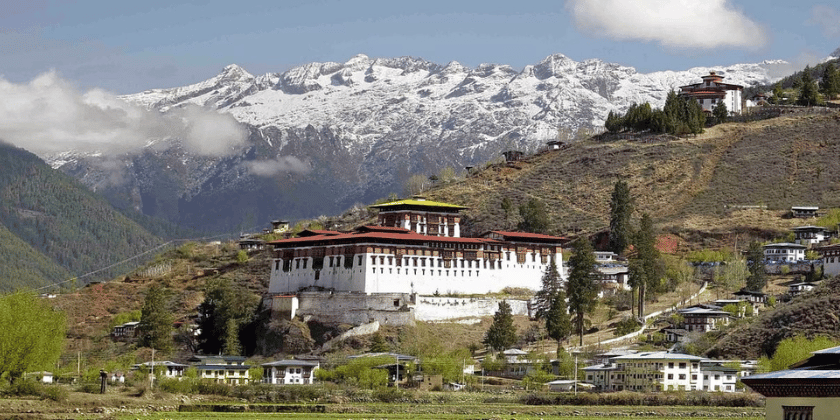
Visitors can also explore the Paro Rinpung Dzong itself, which is an impressive architectural and cultural landmark. The dzong is surrounded by high walls and features ornate wooden galleries, large courtyards, and several chapels and shrines. Visitors can climb up to the roof of the dzong for panoramic views of the surrounding countryside and the nearby Paro River.
The Paro Rinpung Dzong Museum is an important cultural attraction in Bhutan, providing visitors with a fascinating insight into the country’s rich history and traditions. It is open daily from 9 am to 4 pm, except on national holidays. Visitors are required to pay a small admission fee and must adhere to the museum’s dress code, which requires modest clothing that covers the shoulders and knees. Photography is also not allowed inside the museum.
In conclusion, a visit to the Paro Rinpung Dzong Museum is a must for anyone interested in Bhutanese culture and history. With its extensive collection of artifacts and artworks, as well as its impressive architecture and stunning views, the museum offers a unique and memorable experience for visitors.
- Trongsa
Trongsa is a small town in central Bhutan that holds immense historical and cultural significance. It is known as the ancestral home of the Royal Family of Bhutan and is situated in a beautiful valley with stunning views of the surrounding mountains. Trongsa is also home to one of the most impressive dzongs (fortress-monastery) in the country, which has been an important political and religious center for centuries.
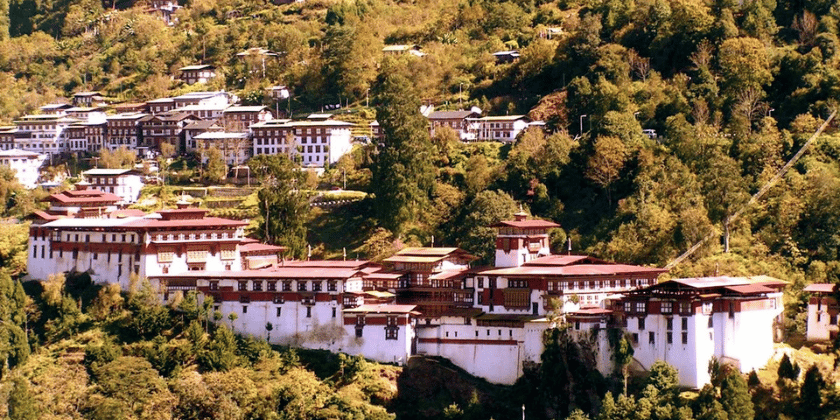
As a visiting tourist, there are many things to see and do in Trongsa. Here is a unique and detailed guide to exploring this charming town from a tourist’s perspective.
- Trongsa Dzong:
The Trongsa Dzong is the most famous attraction in Trongsa and is a must-visit for any tourist exploring the town. This impressive fortress-monastery is situated on a hill overlooking the Mangde Chhu River and has been an important political and religious center for over 300 years. The dzong is beautifully decorated with intricate wood carvings and is home to many holy relics and religious artifacts. Visitors can explore the various courtyards, temples, and administrative offices within the dzong and learn about its rich history and significance to Bhutanese culture.
- Ta Dzong:
The Ta Dzong is a small museum situated just above the Trongsa Dzong. It was originally built in the 17th century as a watchtower and was later converted into a museum in 2008. The museum houses a fascinating collection of artifacts, including traditional Bhutanese costumes, weapons, and religious objects. Visitors can also learn about the history of the Royal Family and the importance of Trongsa in Bhutanese culture.
- Trongsa Market:
The Trongsa Market is a bustling and colorful place where locals come to buy and sell fresh produce, textiles, and handicrafts. It’s a great place to get a sense of daily life in Bhutan and to pick up some unique souvenirs to take home with you. Visitors can also sample some of the local cuisine, including momos (dumplings), ema datshi (spicy cheese and chili dish), and suja (butter tea).
- Kuenga Rabten Palace:
The Kuenga Rabten Palace is a summer residence of the Royal Family, situated just outside of Trongsa town. It was built in 1904 by the first King of Bhutan, Ugyen Wangchuck, as a retreat for his father, Jigme Namgyel Wangchuck. The palace is a beautiful example of Bhutanese architecture, with colorful paintings and intricate wood carvings. Visitors can take a guided tour of the palace and learn about the history of the Royal Family.
- Trongsa Festival:
The Trongsa Festival is held annually in December and is one of the most important religious festivals in Bhutan. It is a time for locals to come together and celebrate their culture through dance, music, and prayer. Visitors can witness the colorful masked dances and learn about the significance of the festival to Bhutanese culture.
- Bumthang Valley:
The Bumthang Valley is located just a short drive from Trongsa and is known for its stunning natural beauty and rich cultural heritage. It is home to many important religious sites, including the Jakar Dzong and Jambay Lhakhang, as well as several traditional Bhutanese villages. Visitors can take a scenic drive through the valley, stopping at various sites along the way to explore and learn about the local culture.
- Yathra Weaving Center:
The Yathra Weaving Center is located in the nearby village of Chumey and is a great place to learn about traditional Bh
- Dorji Lopen’s Monastery
Dorji Lopen’s Monastery, also known as Talo Monastery, is a beautiful and historic Buddhist monastery located in the village of Talo in Bhutan. This monastery is an important part of Bhutan’s cultural heritage and is revered by the locals as well as the visitors who come to witness its beauty and learn about its rich history.
As you travel through the scenic valleys and hills of Bhutan, you will come across many monasteries and religious sites, but Dorji Lopen’s Monastery stands out for its unique blend of architecture, history, and spiritual significance. This monastery is situated in Talo, a picturesque village located in the Punakha district of Bhutan, which is known for its traditional way of life and the natural beauty of its surroundings.
The history of Dorji Lopen’s Monastery dates back to the 17th century when it was built by Lama Drukpa Kunley, also known as the “Divine Madman”, who was a legendary figure in Bhutanese folklore. Lama Drukpa Kunley is believed to have tamed a ferocious demon with his phallus, which is why he is often depicted holding a wooden phallus in his hand. This unique approach to Buddhism and his unconventional teachings have made him a revered figure in Bhutanese culture.
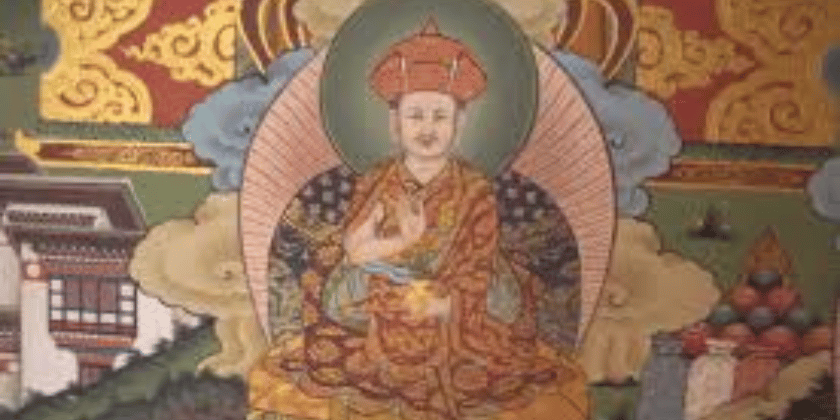
The monastery was later expanded by Dorji Lopen, who was the Chief Abbot of Bhutan and an important religious figure in the country. He was responsible for establishing the Dratshang Lhentshog, which is the highest religious council in Bhutan. The monastery was named after him in recognition of his contributions to Bhutanese culture and religion.
The monastery is surrounded by lush greenery and offers stunning views of the valley below. The architecture of the monastery is unique, with a blend of Bhutanese and Tibetan styles. The main prayer hall is adorned with beautiful murals depicting various Buddhist deities and is a must-see for any visitor.
In addition to the main prayer hall, the monastery also houses a collection of sacred artifacts, including ancient manuscripts, thangkas, and statues of Buddha and other deities. Visitors can learn about the history and significance of these artifacts from the knowledgeable monks who reside in the monastery.
The monks who reside in Dorji Lopen’s Monastery lead a simple and austere life, following the principles of Buddhism. Visitors can witness their daily routine, which includes prayer, meditation, and other religious activities.
The village of Talo, where the monastery is located, is also worth exploring. It is known for its traditional architecture and is home to several traditional Bhutanese houses. Visitors can learn about the traditional way of life in Bhutan and witness the unique architecture of the region.
In conclusion, Dorji Lopen’s Monastery is a must-visit for anyone traveling to Bhutan. Its unique blend of history, architecture, and spiritual significance make it a fascinating destination for visitors of all ages. The monastery is a testament to the rich cultural heritage of Bhutan and a symbol of the country’s commitment to preserving its unique identity.
- Samdrup Jongkhar
Samdrup Jongkhar is a bustling town in the southeastern part of Bhutan, near the border with India. It is the gateway to eastern Bhutan and the Indian states of Assam and Arunachal Pradesh. The town is situated in a lush, subtropical valley at an altitude of 200 meters above sea level, making it a popular destination for tourists who want to experience the natural beauty and cultural diversity of the region.
The town is famous for its bustling market, which is the largest in eastern Bhutan. Visitors can wander through the colorful stalls selling fresh produce, handicrafts, and textiles. The market is also a great place to sample local delicacies such as momos (steamed dumplings), suja (butter tea), and phaksha paa (spicy pork curry).
One of the most popular attractions in Samdrup Jongkhar is the Zangdopelri Temple, a beautiful Buddhist temple located in the heart of the town. The temple is adorned with intricate carvings and paintings, and visitors can join in with the locals in prayer and meditation.
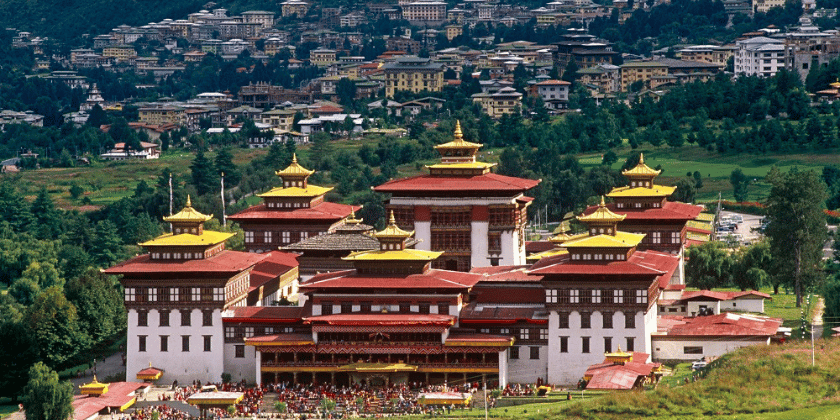
Another must-see attraction in Samdrup Jongkhar is the Samdrup Jongkhar Dzong, a fortress-like structure that dates back to the 18th century. The dzong is built on a hill overlooking the town and is an excellent example of traditional Bhutanese architecture. Visitors can explore the dzong and admire its intricate woodwork, beautiful paintings, and stunning views of the surrounding countryside.
For nature lovers, Samdrup Jongkhar has plenty to offer. The town is surrounded by lush forests, sparkling rivers, and beautiful waterfalls. Visitors can take a guided hike to the nearby Khaling Wildlife Sanctuary, which is home to a variety of endangered species such as the clouded leopard, red panda, and Himalayan black bear.
Samdrup Jongkhar is also home to the Royal Manas National Park, which is the oldest and largest national park in Bhutan. The park is home to a diverse range of flora and fauna, including the Bengal tiger, Asian elephant, and Indian rhinoceros. Visitors can take guided tours of the park to learn about its conservation efforts and witness its incredible wildlife.
Overall, Samdrup Jongkhar is a fascinating town that offers visitors a unique blend of natural beauty, cultural diversity, and historical significance. Whether you’re a nature lover, a history buff, or simply looking to experience the vibrant energy of Bhutan, Samdrup Jongkhar is a destination not to be missed.
- Sengor
Sengor, also known as Sengor Dzong, is a small town located in the Trashigang district of eastern Bhutan. Situated at an elevation of 1,400 meters, the town is surrounded by verdant hills and pristine forests, making it an ideal destination for nature lovers and adventure seekers.
Getting to Sengor can be an adventure in itself as the town is only accessible via a winding and scenic road that passes through the beautiful Kanglung village. The journey takes visitors through dense forests, rushing streams, and stunning mountain views, offering a glimpse of Bhutan’s untouched natural beauty.
One of the main attractions of Sengor is the Sengor Dratshang, also known as the Sengor Monastery. This beautiful monastery is perched on a hill overlooking the town and is home to a community of Buddhist monks. Visitors can witness the daily rituals and prayers performed by the monks and soak in the serene and peaceful atmosphere of the monastery.
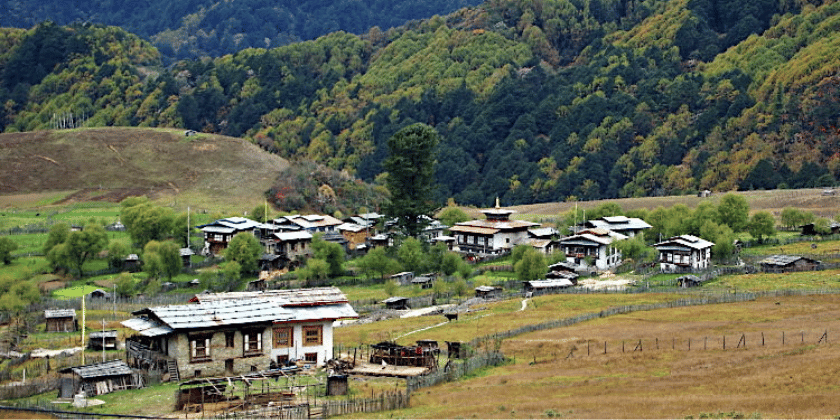
Another popular attraction in Sengor is the nearby Khaling Wildlife Sanctuary. Spread over an area of 273 square kilometers, the sanctuary is home to a wide range of flora and fauna, including several endangered species such as the white-bellied heron and the Asian elephant. Visitors can go on guided tours through the sanctuary, which offers the chance to spot various animals and birds in their natural habitat.
For those interested in Bhutan’s rich cultural heritage, a visit to the nearby Khaling village is a must. The village is known for its traditional handloom weaving and visitors can witness the intricate process of weaving by the local women. The village is also home to several important cultural sites, including a beautiful temple and a traditional Bhutanese house.
Overall, Sengor is a charming and peaceful town that offers visitors a chance to experience Bhutan’s natural beauty and rich cultural heritage. With its beautiful monastery, wildlife sanctuary, and traditional weaving village, Sengor is a must-visit destination for anyone looking for an authentic Bhutanese experience.
- Khamsa Yulley Namgyal Chorten
Khamsa Yulley Namgyal Chorten, also known as the Dochula Chorten, is a beautiful and iconic landmark located in the Dochula Pass, about 45 minutes from the capital city of Thimphu in Bhutan. It is a popular tourist attraction that offers panoramic views of the surrounding mountains and valleys. The chorten was built in 2004 as a memorial to commemorate the victory of Bhutanese soldiers over Indian militants in 2003.
The Dochula Pass is located at an altitude of 3,100 meters above sea level, and the chorten is situated at the top of the pass. Visitors can reach the chorten by road, which takes them through a winding mountainous route, offering breathtaking views of the landscape along the way.
The chorten is a large white structure that stands tall and proud amidst the natural beauty of the surroundings. It is adorned with intricate carvings and paintings that depict various Buddhist deities and symbols. Visitors can take a closer look at these intricate details, which are a testament to the skill and craftsmanship of Bhutanese artists.
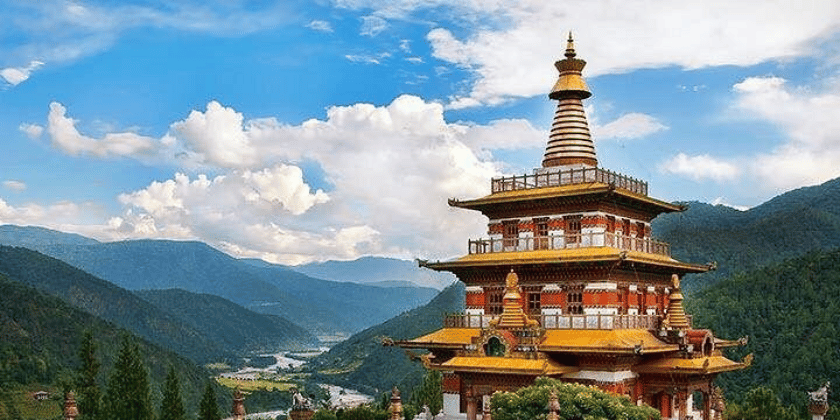
In addition to the chorten, visitors can also explore the Dochula Pass, which offers stunning views of the snow-capped Himalayan mountain ranges. The pass is covered with prayer flags that flutter in the wind, adding to the spiritual and peaceful ambiance of the area.
At the base of the chorten, there is a small temple that houses a statue of Guru Rinpoche, a revered figure in Bhutanese Buddhism. Visitors can offer prayers and make offerings at the temple, which is a great way to experience the local culture and traditions.
The chorten is also a popular spot for picnics and outdoor activities. Visitors can relax and enjoy the scenic beauty of the area, take a stroll along the winding mountain trails, or even have a family picnic amidst the beautiful surroundings.
Overall, the Khamsa Yulley Namgyal Chorten is a must-visit destination for tourists in Bhutan. It offers a unique blend of natural beauty, cultural heritage, and spiritual significance that is sure to leave a lasting impression on visitors.
- Dzongdrakha Temple
Dzongdrakha Temple in Bhutan: A Visiting Tourist’s Perspective
Nestled in the mountains above the Paro Valley, the Dzongdrakha Temple is a stunning Buddhist monastery that is a must-visit for tourists to Bhutan. The temple is located about 20 kilometers from the Paro International Airport and offers a breathtaking view of the surrounding valley.
The Dzongdrakha Temple is believed to have been built in the 16th century by the legendary saint, Guru Rinpoche. The temple is made up of four smaller temples that are situated on the edge of a cliff overlooking the Paro Valley. Legend has it that Guru Rinpoche flew to the site on the back of a flying tigress and meditated there for several years.
As you approach the temple, you will be greeted by a series of prayer flags that flutter in the breeze. The temple is reached by a steep climb up a series of stone steps that wind their way up the hillside. As you climb higher, you will be rewarded with stunning views of the valley below.
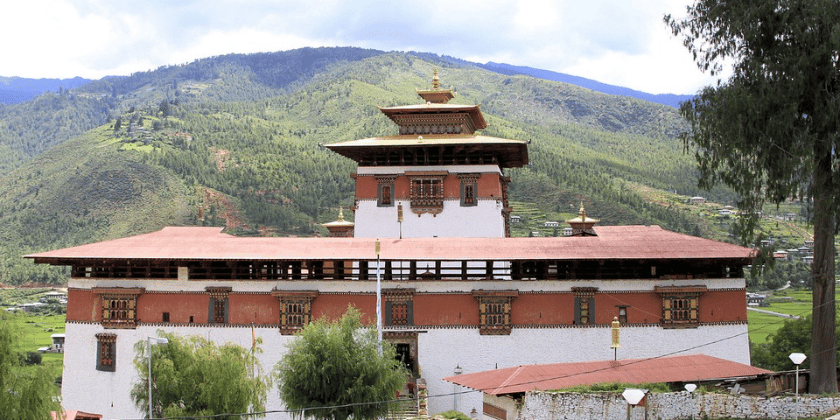
The temple complex itself is small but intricately decorated. The four temples are connected by a narrow path that winds its way around the cliff face. Each of the temples is dedicated to a different Buddhist deity and features stunning murals and intricate wood carvings.
One of the highlights of the Dzongdrakha Temple is the meditation cave that is said to have been used by Guru Rinpoche himself. The cave is located behind one of the temples and requires a short climb up a set of stairs. Inside the cave, you will find a small shrine and several prayer flags.
Visitors are welcome to explore the temple complex at their leisure. However, it is recommended that you take a guided tour in order to fully appreciate the history and significance of the site. Your guide will be able to provide you with a wealth of information about the temple’s history and the role it plays in Bhutanese culture.
The Dzongdrakha Temple is also a popular destination for pilgrims. It is believed that by visiting the temple, you can receive blessings and purification. It is not uncommon to see groups of Bhutanese pilgrims making their way up the steep hillside to offer prayers and perform rituals at the temple.
In conclusion, the Dzongdrakha Temple is a must-visit destination for anyone traveling to Bhutan. It offers a unique insight into Bhutanese culture and history and provides visitors with an unforgettable experience. The stunning location, intricate decorations, and rich history of the temple make it a truly special place that should not be missed.
- Sakteng
Sakteng, located in the eastern part of Bhutan, is a unique and isolated village that is a must-visit for tourists who want to experience the authentic culture of Bhutan. The village is nestled in the Himalayan mountains at an altitude of 3,500 meters and is home to the Brokpa people, who have their own distinct culture, language, and customs.
To reach Sakteng, visitors have to embark on a challenging trek that takes them through some of the most breathtaking landscapes in Bhutan. The trek takes around four days and passes through remote villages, dense forests, and high mountain passes. Visitors will have the opportunity to see the Brokpa people’s way of life, including their traditional dress, food, and customs.
One of the main attractions of Sakteng is the Sakteng Wildlife Sanctuary, which is home to a variety of endangered species such as the snow leopard, red panda, and Himalayan black bear. Visitors can go on guided tours of the sanctuary to see these animals in their natural habitat. The sanctuary is also home to a variety of bird species, making it a paradise for bird watchers.
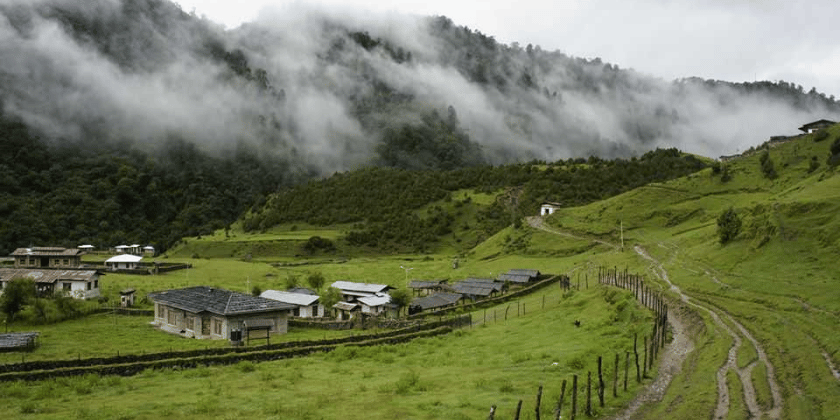
In Sakteng village, visitors can see traditional Brokpa houses made of stone and wood, with distinctive architectural features such as carved wooden windows and doors. Visitors can also see the Brokpa people’s traditional attire, which includes a distinctive black skirt, a white jacket with colorful embroidery, and a conical bamboo hat.
Visitors can also learn about the Brokpa people’s unique customs, such as their practice of polyandry, where one woman marries multiple men. The Brokpa people also have their own language, which is different from the national language of Bhutan, Dzongkha.
In addition to the village and wildlife sanctuary, there are several scenic spots near Sakteng that visitors can explore, including the sacred lake of Membar Tsho and the holy mountain of Gochen Monastery.
Overall, Sakteng offers a unique and authentic cultural experience that is unlike any other in Bhutan. Visitors who are willing to undertake the challenging trek to reach the village will be rewarded with breathtaking scenery, fascinating cultural experiences, and a chance to see some of the rarest wildlife species in the world.
- Pemagatshel
Pemagatshel is a beautiful district in southeastern Bhutan, known for its stunning natural landscapes and rich cultural heritage. Located in the eastern part of Bhutan, the district is famous for its unique festivals, beautiful monasteries, and pristine forests. If you’re planning to visit Bhutan, Pemagatshel is definitely a destination worth considering.
One of the highlights of Pemagatshel is its stunning natural beauty. The district is home to several beautiful valleys, including Kharungla and Ngangla, which are popular trekking destinations. The forests in Pemagatshel are home to a variety of wildlife, including the rare black-necked crane, which can be seen in the winter months. The district is also known for its beautiful waterfalls, including the Khachu Dratsang and Yonphula Lhakhang waterfalls.
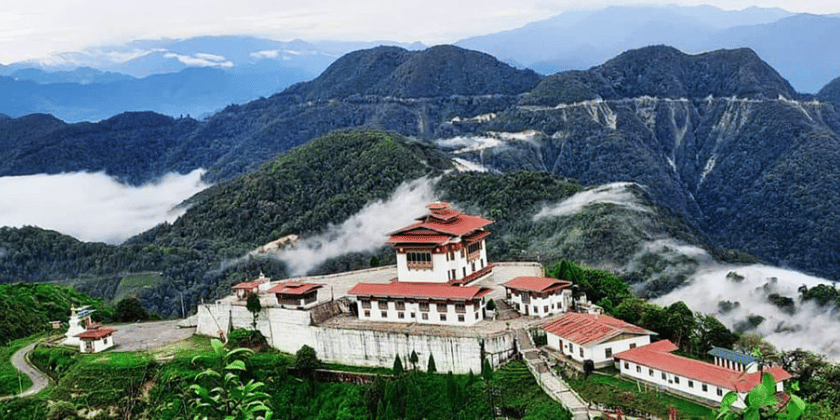
Pemagatshel is also home to several beautiful monasteries and temples, including the Pemagatshel Dzong, which is one of the oldest and most important Dzongs in Bhutan. Built in the 18th century, the Dzong is an important administrative and religious center, and is known for its beautiful architecture and stunning views of the surrounding mountains and valleys. Other important religious sites in Pemagatshel include the Kharkhil Monastery and the Chokyi Gyatso Institute.
One of the most unique cultural attractions in Pemagatshel is the annual Tshechu festival, which is held in the district’s various villages and monasteries. The festival is a colorful celebration of Bhutanese culture, featuring traditional music, dance, and costumes. The Tshechu festival is a great way to experience Bhutanese culture and learn about the local traditions and customs.
If you’re interested in hiking and trekking, Pemagatshel is a great destination to explore. The district is home to several beautiful trails, including the Kharungla Trek, which takes you through beautiful valleys and forests to the top of Kharungla Pass. The Ngangla Trek is another popular trek, which takes you through pristine forests and past beautiful waterfalls. These treks are a great way to explore the natural beauty of Pemagatshel and experience Bhutan’s stunning landscapes.
Overall, Pemagatshel is a beautiful district that offers a unique blend of natural beauty, cultural heritage, and adventure. Whether you’re interested in exploring the district’s stunning valleys and forests, or learning about Bhutan’s rich cultural traditions, Pemagatshel is a destination that should not be missed.
- Black-Necked Crane Information Centre
The Black-Necked Crane Information Centre in Bhutan is a must-visit destination for any tourist interested in the unique and beautiful bird species of Bhutan. The centre is located in the Phobjikha Valley, which is the winter home of the black-necked cranes, and provides visitors with information about these endangered birds and the efforts being made to protect them.
The black-necked crane is a rare and endangered species that is found in only a few places in the world. Bhutan is one of these places, and the Phobjikha Valley is one of the few winter habitats of the birds. The black-necked crane is an important part of Bhutanese culture and folklore, and is considered a symbol of longevity, good fortune, and peace.
The Black-Necked Crane Information Centre was established to educate visitors about these birds and their importance to Bhutanese culture and ecology. The centre has a small museum that displays information about the black-necked crane, including its habitat, behavior, and conservation efforts. There are also exhibits on traditional Bhutanese culture and handicrafts.
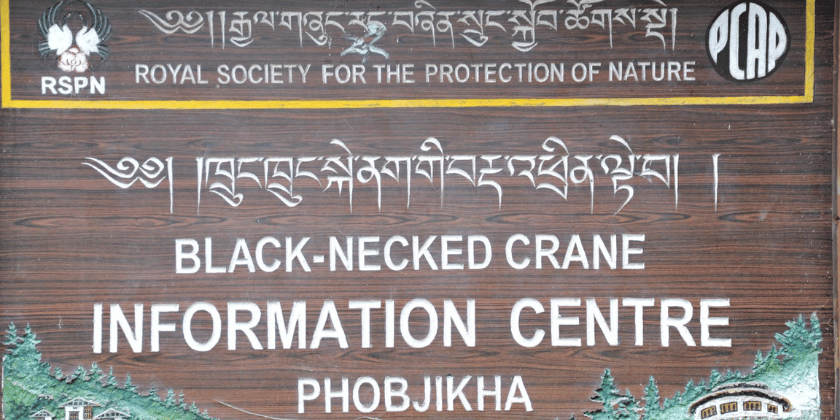
The centre offers guided tours of the Phobjikha Valley, where visitors can see the black-necked cranes in their natural habitat. The tours are led by knowledgeable guides who provide information about the birds, their habitat, and the efforts being made to protect them. Visitors can also enjoy the beautiful scenery of the valley, which is surrounded by snow-capped mountains and pristine forests.
In addition to the museum and guided tours, the Black-Necked Crane Information Centre has a small gift shop that sells souvenirs and handicrafts made by local artisans. The proceeds from the shop go towards supporting conservation efforts for the black-necked cranes and their habitat.
Visitors to the Black-Necked Crane Information Centre should plan to spend several hours exploring the museum, taking a guided tour of the valley, and shopping for souvenirs. The centre is open every day except for Tuesdays and admission is free.
In conclusion, the Black-Necked Crane Information Centre is a unique and important destination in Bhutan that offers visitors the opportunity to learn about the black-necked crane, its habitat, and the efforts being made to protect it. The centre is a must-visit for any nature lover or bird enthusiast, and is a great way to experience the beauty and culture of Bhutan.
- Mongar
Mongar is a bustling town located in eastern Bhutan, surrounded by lush green hills and valleys. It is one of the fastest-growing towns in the country, offering visitors a unique blend of traditional Bhutanese culture and modern development.
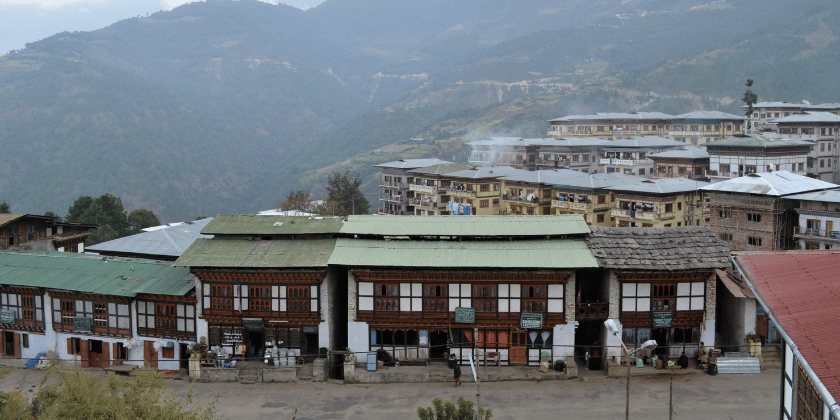
As a tourist, Mongar is a great place to explore the natural beauty of Bhutan while also experiencing its rich history and culture. Here are some of the top attractions and activities to do in Mongar:
- Mongar Dzong: One of the main attractions in Mongar is the Mongar Dzong, which sits atop a hill overlooking the town. This impressive fortress was built in the 1930s and is one of the newest dzongs in Bhutan. It serves as the administrative headquarters of the Mongar district and is a great place to learn about Bhutanese history and architecture.
- Drametse Ngacham: The Drametse Ngacham is a traditional Bhutanese dance that originated in Mongar. This dance is performed during the annual Dakpa Kora festival, which is held in March. Visitors can witness this lively dance at other festivals as well, such as the Paro Tsechu.
- Yagang Lhakhang: Yagang Lhakhang is a small temple located about 30 minutes from Mongar. It is known for its beautiful murals and statues, as well as its peaceful and serene atmosphere.
- Kurje Lhakhang: Kurje Lhakhang is a sacred site located about an hour’s drive from Mongar. It is believed to have been blessed by Guru Rinpoche, the founder of Buddhism in Bhutan, and is home to a rock with the imprint of his body.
- Village tours: The villages around Mongar offer visitors a chance to experience rural Bhutanese life firsthand. Visitors can see traditional Bhutanese homes, interact with locals, and learn about the unique customs and traditions of this region.
- Trekking: The hills and valleys surrounding Mongar are perfect for trekking, with trails that range from easy to challenging. Popular trekking destinations include the Lingmethang trek and the Rodung La trek, both of which offer stunning views of the Himalayas.
- Shopping: Mongar is known for its textiles, particularly the famous kushuthara, which is a hand-woven fabric made from silk and cotton. Visitors can shop for these and other traditional Bhutanese textiles in Mongar’s local markets.
Overall, Mongar offers a great blend of natural beauty and cultural experiences. It’s a must-visit destination for anyone looking to explore the best that Bhutan has to offer.
- Zhemgang
Zhemgang is a remote district located in central Bhutan, known for its pristine forests, rich biodiversity, and traditional culture. As a tourist, visiting Zhemgang offers an opportunity to explore an off-the-beaten-path destination and experience a more authentic side of Bhutan.
One of the main attractions of Zhemgang is the Zhemgang Dzong, a 17th-century fortress that was once the administrative center of the district. The dzong sits on a hill overlooking the Mangde Chu river and offers stunning views of the surrounding valley. Visitors can explore the dzong’s courtyards, temples, and administrative offices, and learn about the history and culture of the region.
Another popular attraction in Zhemgang is the Khomshar Wildlife Sanctuary, which spans over 420 square kilometers and is home to a wide variety of flora and fauna. Visitors can take guided tours of the sanctuary to spot rare species such as the clouded leopard, Himalayan black bear, and red panda, as well as a variety of bird species.
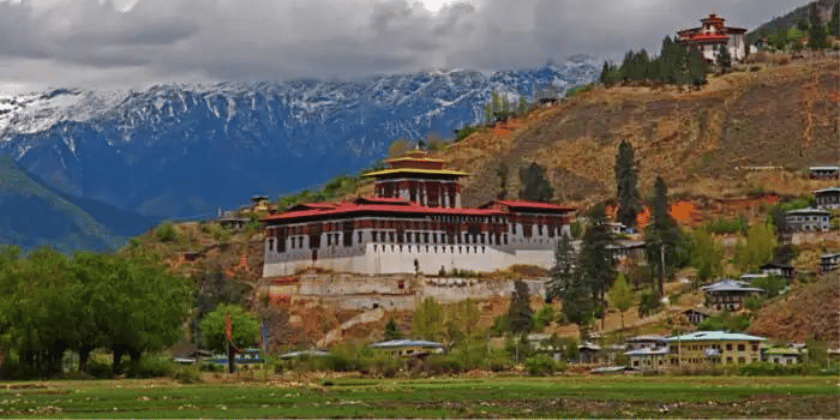
For those interested in learning about traditional Bhutanese culture, a visit to Zhemgang’s villages is a must. The district is home to several ethnic groups, including the Khengpa, who are known for their unique culture and traditions. Visitors can observe traditional dances, visit local temples, and learn about the community’s way of life.
One particularly fascinating village to visit in Zhemgang is Trong, which is known for its unique system of polyandry, where several brothers share a wife. Visitors can learn about this tradition and its significance in the local culture.
For adventurous travelers, Zhemgang offers several hiking and trekking opportunities, including the Bumthang to Zhemgang trek, which takes visitors through remote villages, lush forests, and pristine valleys.
Accommodation options in Zhemgang are limited, but visitors can choose to stay in local guesthouses or campsites to experience a more authentic Bhutanese way of life. Local cuisine is also a highlight of a visit to Zhemgang, with traditional dishes such as ema datshi (spicy cheese and chili dish) and phaksha paa (pork dish) being must-tries.
In conclusion, Zhemgang offers a unique and authentic experience for tourists looking to explore off-the-beaten-path destinations in Bhutan. With its rich culture, pristine forests, and stunning vistas, Zhemgang is a destination worth visiting for any adventurous traveler.
- Simtokha Dzong
Simtokha Dzong is one of the oldest and most important fortresses in Bhutan, located just a few kilometers south of Thimphu, the capital city. Built in 1629 by the Zhabdrung Ngawang Namgyal, the unifier of Bhutan, it is the first dzong to have been built in the country. Today, Simtokha Dzong is a famous tourist attraction and is also used as a monastic and administrative center.
As a visiting tourist, the experience of visiting Simtokha Dzong is both educational and awe-inspiring. Upon arriving at the dzong, you will immediately notice its unique architecture, with a central tower surrounded by four walls and several buildings spread throughout the complex. The dzong is located on a hill and offers beautiful views of the surrounding landscape.
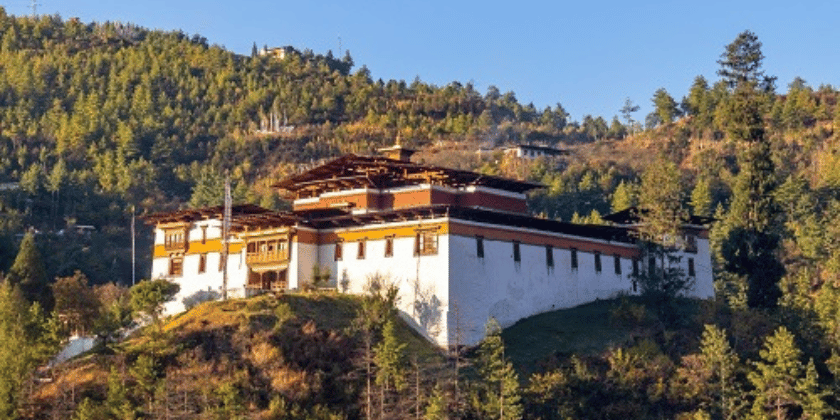
The main entrance of Simtokha Dzong is a large wooden bridge that crosses a small stream. The bridge is adorned with traditional Bhutanese paintings and carvings. Once inside, you will be greeted by a large courtyard, which is used for various events and ceremonies throughout the year. The courtyard is surrounded by beautiful gardens and several structures, including the central tower, which houses a shrine to Guru Rinpoche.
One of the most interesting things about Simtokha Dzong is that it serves as a center for the preservation of Bhutanese language and culture. The dzong houses the Institute for Language and Culture Studies, which is dedicated to promoting and preserving the Bhutanese language and culture. Visitors can learn about the various aspects of Bhutanese culture, including language, music, dance, and traditional arts and crafts.
Another notable feature of Simtokha Dzong is its religious significance. The dzong is home to several temples and shrines, including the Guru Lhakhang, the Kutey Lhakhang, and the Dukhang. These temples are beautifully decorated with traditional Bhutanese paintings and carvings, and visitors can learn about the history and significance of each one.
Overall, a visit to Simtokha Dzong is a unique and fascinating experience for any tourist visiting Bhutan. Whether you are interested in history, architecture, religion, or culture, there is something for everyone to enjoy at this ancient fortress. So, make sure to add Simtokha Dzong to your itinerary and discover the rich history and culture of Bhutan.
- Kurjey Lhakhang
Kurjey Lhakhang, located in the Bumthang valley of Bhutan, is a revered Buddhist monastery that holds significant historical and spiritual importance. As a tourist visiting Bhutan, a visit to Kurjey Lhakhang provides an opportunity to explore the country’s rich cultural and religious heritage.
The monastery complex consists of three temples, each of which has a unique history and significance. The first temple, known as Guru Lhakhang, houses a rock where Guru Rinpoche meditated and left an imprint of his body. The second temple, known as Sampa Lhundrup Lhakhang, is where the 8th-century Buddhist master Guru Rinpoche is believed to have subdued demons and left his body imprint on a rock. The third temple, known as Ka Gon Phur Sum Lhakhang, houses the statues of Guru Rinpoche, Buddha, and Chenrezig.
One of the most striking features of Kurjey Lhakhang is its beautiful architecture. The temples are built in a traditional Bhutanese style, with intricately carved woodwork and colorful murals depicting the life of Guru Rinpoche. The surrounding landscape is also breathtaking, with the lush green valley of Bumthang and the surrounding mountains providing a picturesque backdrop.
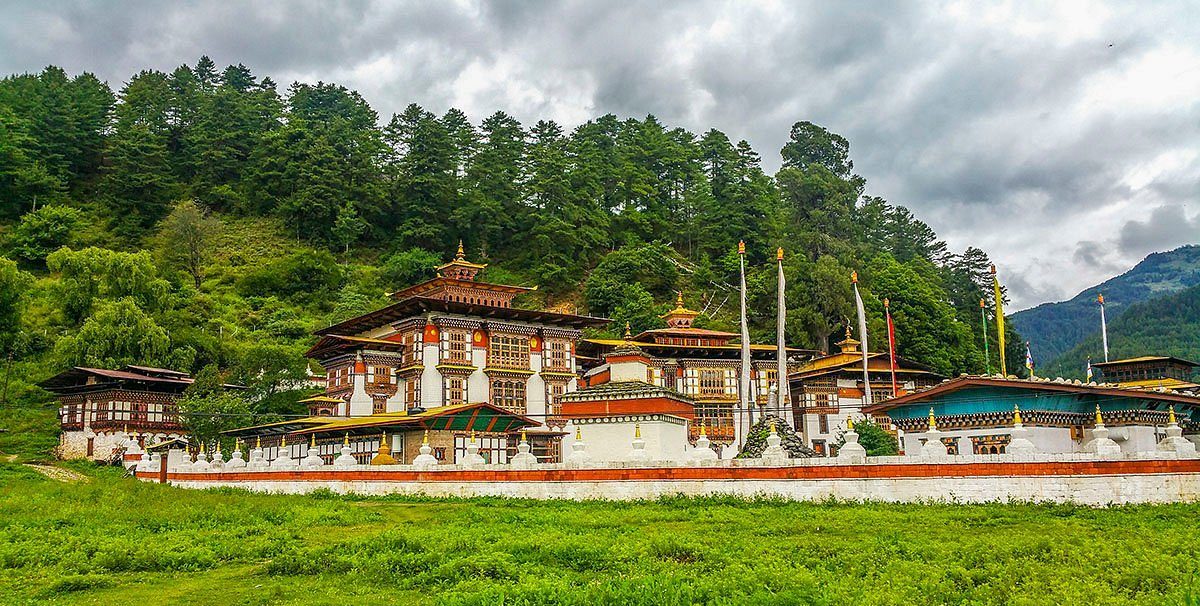
Visitors to Kurjey Lhakhang can also participate in the traditional Bhutanese practice of circumambulating the temples, which involves walking clockwise around the temples while reciting prayers and spinning prayer wheels. This is believed to accumulate merit and bring good luck and blessings.
In addition to its spiritual significance, Kurjey Lhakhang also has an important role in Bhutanese history. It was here that the first king of Bhutan, Ugyen Wangchuck, was blessed and crowned by the first Je Khenpo (chief abbot) of Bhutan, in the presence of Guru Rinpoche’s body imprint.
Overall, a visit to Kurjey Lhakhang provides a unique and enriching experience for tourists interested in Bhutanese culture and spirituality. The peaceful surroundings and rich history of the monastery make it a must-visit destination in Bhutan.
- Paro Weekend Market
Paro Weekend Market in Bhutan is an incredible cultural experience for tourists to visit. It’s a bustling market that is open only on Saturdays and Sundays, and it’s located just outside of the main town of Paro. This vibrant market is an excellent place to learn more about the local Bhutanese culture, try new foods, and find unique souvenirs to take home.
As a visiting tourist, it’s an absolute must-visit destination in Bhutan. The market is a hub of activity, with vendors selling everything from fresh produce to handicrafts, jewelry, clothing, and more. The market is popular among locals and visitors alike, and it’s the perfect place to immerse yourself in Bhutanese culture and experience the lively atmosphere of a traditional market.
The market opens early in the morning, and vendors start setting up their stalls around 6 am. The market stays open until late afternoon, giving you ample time to explore the different stalls and interact with the vendors. The market is situated in an open-air setting, so it’s a great place to take in the fresh air and enjoy the beautiful Bhutanese scenery.
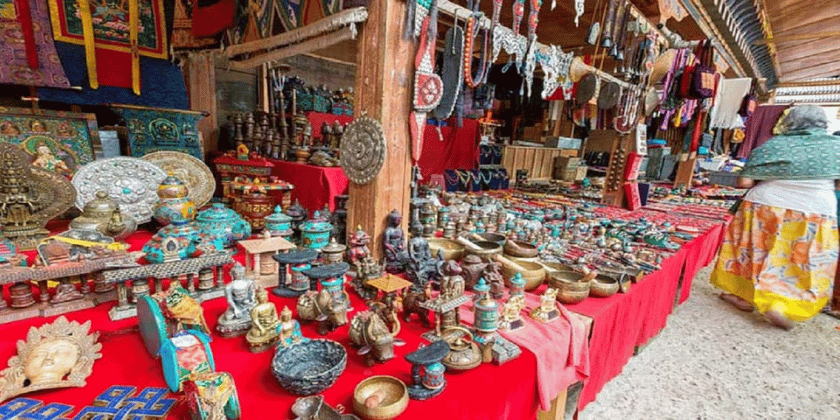
The vendors at the Paro Weekend Market sell a wide range of products, including fresh fruits and vegetables, traditional Bhutanese clothing, handmade jewelry, pottery, souvenirs, and much more. It’s an excellent opportunity to try some of the local cuisine, including ema datshi, a spicy Bhutanese dish made with chili peppers and cheese, and momos, steamed dumplings filled with meat or vegetables.
Apart from the delicious food and shopping opportunities, the Paro Weekend Market also offers a glimpse into the Bhutanese way of life. You’ll have the opportunity to interact with locals and learn about their customs and traditions. It’s a great place to practice your bargaining skills, and you may even be able to score a great deal on a unique souvenir to take back home.
Overall, the Paro Weekend Market is a fascinating cultural experience for tourists visiting Bhutan. It’s a vibrant, bustling market that offers a wide range of products, delicious food, and a glimpse into Bhutanese culture. Be sure to check it out if you’re visiting Paro over the weekend – it’s an experience you won’t forget!
- Chimi Lhakhang Temple
Chimi Lhakhang Temple, also known as the Temple of Fertility, is a popular tourist destination located in the Punakha Valley of Bhutan. This temple is dedicated to the Divine Madman, Lama Drukpa Kunley, who is a revered saint in Bhutan. The temple is famous for its unique tradition of blessing visitors who are seeking fertility, and it is a must-visit destination for couples who are trying to conceive.
As a tourist visiting Chimi Lhakhang Temple, you will be mesmerized by the scenic beauty of the surrounding hills and the lush green valley. The temple is situated on a small hill, and the journey to the temple is an adventure in itself. The trek to the temple takes around 30 minutes from the parking lot, and it passes through beautiful rice paddies, traditional Bhutanese houses, and scenic landscapes.
The temple’s unique tradition of blessing visitors seeking fertility involves a phallus symbol that is painted on the walls and used as a representation of fertility. The phallus symbol is said to ward off evil spirits and bless the visitors with fertility. Couples who visit the temple receive blessings from the temple’s monk, who hits them on the head with a wooden phallus symbol to bring them good luck and fertility.
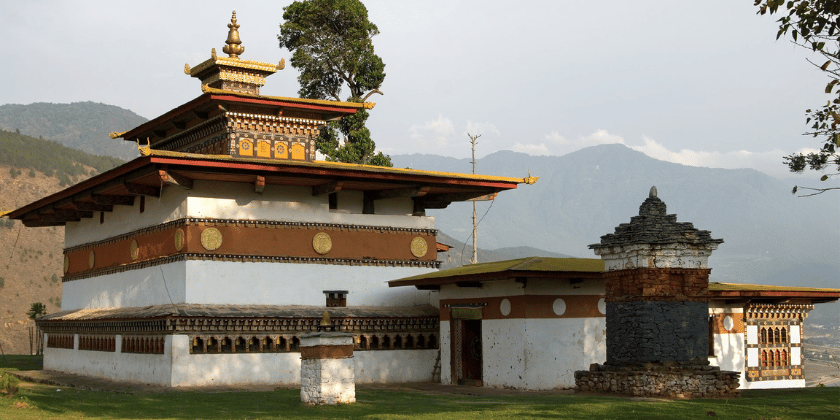
Apart from its unique tradition, the Chimi Lhakhang Temple is also renowned for its beautiful architecture. The temple’s exterior is adorned with colorful paintings of Buddhist deities, and the interior of the temple is filled with beautiful murals and religious artifacts. The temple’s serene atmosphere makes it an ideal place to meditate and reflect on life.
Visitors to the Chimi Lhakhang Temple can also explore the nearby Punakha Dzong, which is one of the most famous Dzongs in Bhutan. The Dzong is a beautiful structure made of white-washed walls and golden roofs and is set against a backdrop of lush green hills. The Dzong is open to visitors and is a perfect place to learn more about Bhutan’s rich history and culture.
In conclusion, a visit to the Chimi Lhakhang Temple in Bhutan is an unforgettable experience for tourists. From the scenic trek to the temple to the unique tradition of blessing visitors seeking fertility, this temple is a must-visit destination for anyone traveling to Bhutan. The temple’s beautiful architecture and serene atmosphere make it an ideal place to relax and reflect on life. So, if you are planning a trip to Bhutan, make sure to include a visit to Chimi Lhakhang Temple on your itinerary.
- Jakar Valley
Jakar Valley, also known as Bumthang Valley, is a picturesque and culturally rich valley located in central Bhutan. It is one of the most popular tourist destinations in Bhutan, known for its scenic beauty, traditional architecture, and historical sites. As a visiting tourist, there are many things to see and do in Jakar Valley, making it an ideal place to visit for travelers looking for an authentic Bhutanese experience.
Getting to Jakar Valley is relatively easy, with the nearest airport being in Paro. From there, it is a 10-hour drive to Jakar Valley, passing through winding mountain roads and scenic valleys. The journey itself is an experience, offering stunning views of the Himalayas and the Bhutanese countryside.
Once in Jakar Valley, there are many activities and sights to explore. The valley is home to many historical and cultural landmarks, such as the Jakar Dzong and the Jambay Lhakhang temple, which date back to the 7th century. Visitors can also take a stroll through the town’s quaint streets and admire the traditional Bhutanese architecture, which includes intricately designed wooden houses and brightly painted buildings.
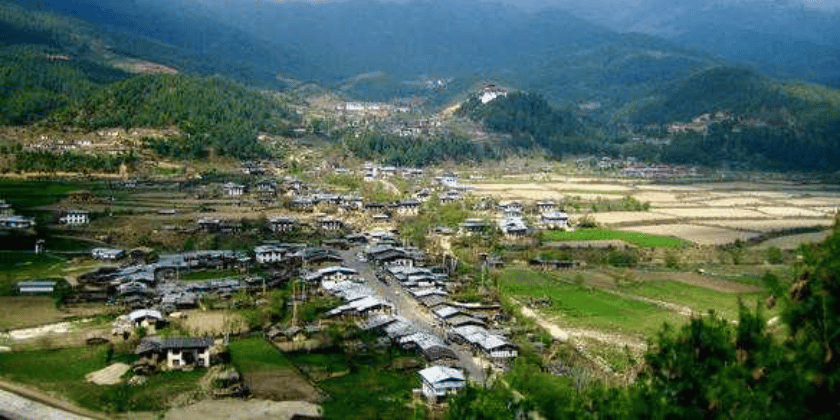
One of the most popular attractions in Jakar Valley is the Burning Lake, also known as Mebar Tsho. Legend has it that a famous Bhutanese saint, Pema Lingpa, discovered treasure hidden at the bottom of the lake after diving in with a burning lamp. Visitors can take a short hike to the lake and witness its clear blue waters and serene surroundings.
Another highlight of Jakar Valley is its natural beauty. The valley is surrounded by lush green forests and offers spectacular views of the Himalayas. Visitors can go on a hike or a trek to explore the valley’s stunning landscape and get a taste of the Bhutanese countryside.
For those looking to experience the local culture and way of life, Jakar Valley offers many opportunities. Visitors can attend a traditional Bhutanese festival, or tshechu, which is held annually in various parts of the country. The Jakar Tshechu, held in the autumn, is a particularly popular festival that showcases Bhutanese dances, music, and traditional attire.
Food lovers will also find plenty to enjoy in Jakar Valley, with local delicacies such as buckwheat pancakes, dried yak meat, and spicy cheese being a must-try. Visitors can also visit the local markets and try out the fresh fruits and vegetables grown in the valley.
Overall, Jakar Valley offers a unique and unforgettable experience for visiting tourists. From its historical landmarks and natural beauty to its rich culture and warm hospitality, the valley has something to offer for everyone. It is a must-visit destination for anyone looking to explore the beauty and charm of Bhutan.
- Trashigang
Trashigang is a bustling town located in eastern Bhutan, and it is known for its unique cultural heritage, breathtaking natural beauty, and vibrant markets. As a visiting tourist, Trashigang offers a unique and authentic experience that is not found in other parts of the world. Here is a guide to everything you need to know about visiting Trashigang.
Getting There One can reach Trashigang by either taking a domestic flight to Yonphula Airport or by driving from Thimphu, the capital city of Bhutan. The drive from Thimphu takes about 14 hours and offers spectacular views of the Himalayan mountains and valleys.
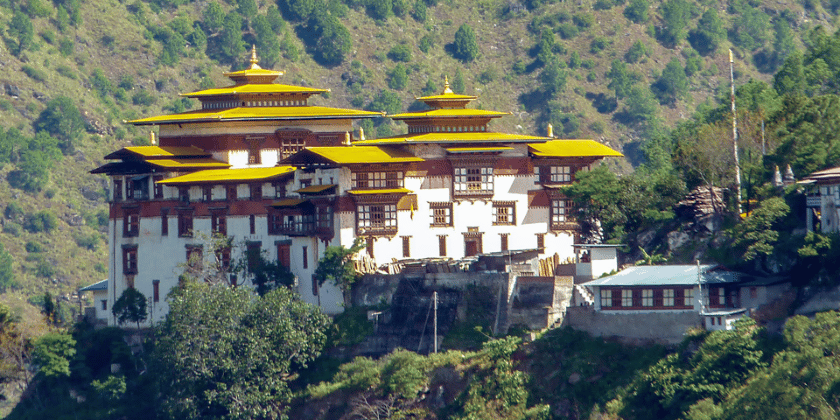
Things to Do Trashigang offers a range of activities that are perfect for tourists who want to experience the local culture and way of life. Here are some of the top things to do in Trashigang:
- Trashigang Dzong: The iconic Trashigang Dzong is a must-visit attraction in the town. The fortress is located on a hilltop overlooking the town, and it offers panoramic views of the surrounding valleys and mountains.
- Trashigang Market: The bustling Trashigang Market is a popular destination for tourists who want to experience the local culture and way of life. The market is known for its vibrant colors, local crafts, and fresh produce.
- Radhi Village: Radhi Village is located about 20 minutes away from Trashigang, and it is known for its unique weaving culture. The villagers weave textiles using traditional methods and natural dyes, and visitors can witness the process and even purchase some of the textiles.
- Kanglung Zangtopelri Lhakhang: The Kanglung Zangtopelri Lhakhang is a temple located about 10 minutes away from Trashigang. The temple is known for its unique architecture and peaceful surroundings.
- Phongmey Village: Phongmey Village is located about 2 hours away from Trashigang, and it is known for its unique bamboo weaving culture. Visitors can witness the process of weaving and purchase some of the handicrafts.
- Merak and Sakteng: Merak and Sakteng are two remote villages located about 4 hours away from Trashigang. The villages offer a unique cultural experience and are known for their traditional way of life and unique dress.
Where to Stay Trashigang offers a range of accommodation options for tourists, including guesthouses, hotels, and resorts. Some of the popular options include Druk Deothjung Resort, Druk Kuenphen Rabten Resort, and Trashigang Lodge.
When to Visit The best time to visit Trashigang is during the spring and fall seasons (March to May and September to November). During these seasons, the weather is pleasant, and the skies are clear, offering the best views of the surrounding mountains and valleys.
In conclusion, Trashigang is a unique and authentic destination that offers a range of cultural experiences and natural beauty. From exploring the iconic Trashigang Dzong to visiting the vibrant Trashigang Market, there is something for every type of traveler in this charming town.
- Namgay Artisanal Brewery
Namgay Artisanal Brewery is one of the must-visit places in Bhutan for beer lovers. This microbrewery located in Paro produces a range of craft beers using locally sourced ingredients and traditional Bhutanese brewing techniques. Here is a unique and detailed article on Namgay Artisanal Brewery from a visiting tourist’s perspective.
History and Background Namgay Artisanal Brewery was established in 2016 by a Bhutanese entrepreneur, Dorji Gyeltshen, who is passionate about craft beer and wanted to introduce a unique Bhutanese beer to the world. The brewery is located in Paro, a scenic valley town in Western Bhutan, known for its historical sites and natural beauty.
The brewery produces a range of craft beers, including the popular Red Panda Wheat Beer, Weizen, and Pale Ale. The beer is made using locally sourced ingredients, such as Himalayan barley, wheat, and hops, giving it a unique taste that is true to Bhutanese culture.
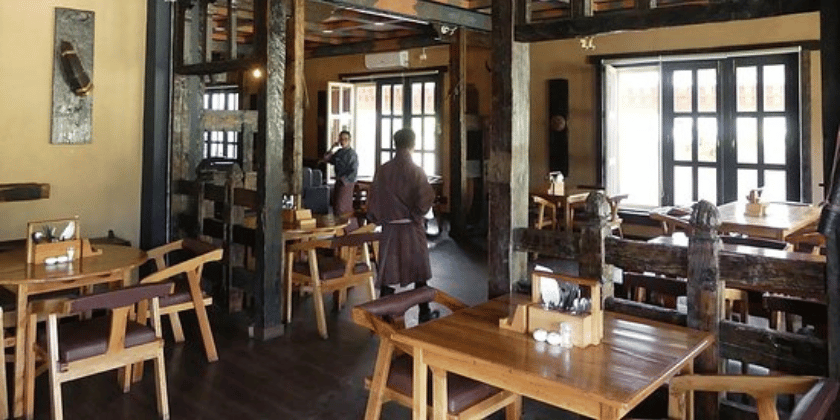
Tasting Room and Tour The brewery offers visitors a tasting room where they can sample the different beers produced on-site. The tasting room has a cozy ambiance, with wooden furnishings and traditional Bhutanese decorations, making it a perfect place to relax and unwind.
Visitors can also take a guided tour of the brewery to learn about the brewing process and the history of beer in Bhutan. The tour includes a visit to the production area, where visitors can see the brewing equipment and learn about the different stages of beer production.
The tour also includes a visit to the onsite shop where visitors can purchase Namgay Artisanal Brewery merchandise, such as t-shirts, hats, and beer glasses, as well as take home some of the locally brewed beer.
Beer Flavors Namgay Artisanal Brewery produces several unique flavors of craft beer, each with its distinct taste and character. The Red Panda Wheat Beer, made with wheat and barley, has a light and refreshing taste and is perfect for hot summer days. The Weizen beer is a Bavarian-style wheat beer with a rich and smooth taste, perfect for pairing with spicy foods.
The Pale Ale, on the other hand, is a hoppy beer with a fruity aroma and a bitter taste, perfect for those who prefer a stronger beer. In addition to these, the brewery also produces other seasonal and limited-edition beers, such as the Double IPA and the Winter Ale, which are available for a limited time.
Conclusion Namgay Artisanal Brewery is a must-visit destination for anyone who loves beer and wants to experience Bhutanese culture. The brewery offers visitors a chance to taste locally brewed beer made using traditional Bhutanese techniques and locally sourced ingredients. The brewery’s tasting room and guided tour provide an opportunity to learn about the brewing process and the history of beer in Bhutan. The unique flavors of beer produced by Namgay Artisanal Brewery make it a popular destination for beer enthusiasts and visitors alike.
- Bhutanese Traditional Medicine
Bhutanese Traditional Medicine in Bhutan – A Visiting Tourist’s Perspective
Bhutan, a small Himalayan kingdom, is known for its unique approach to measuring its progress through the concept of Gross National Happiness (GNH). A significant part of the GNH philosophy is the emphasis on traditional medicine, which has been practiced in Bhutan for centuries. Bhutanese Traditional Medicine (BTM) is a holistic system of healing that emphasizes the balance between body, mind, and spirit. As a visiting tourist, exploring BTM can offer a unique insight into Bhutan’s culture and values.
History and Philosophy of BTM Bhutanese Traditional Medicine dates back to the 17th century and has been an essential part of Bhutanese culture ever since. BTM draws on Buddhist philosophy, and practitioners believe that illness arises from an imbalance of the three bodily humors: rlung (wind), mkhris pa (bile), and bad kan (phlegm). According to BTM, the body has three parts: sa (physical), nga (mind), and lu (spirit). These three parts are interconnected, and illness in one part can affect the others.
BTM Treatments BTM treatments are holistic and aim to restore balance and harmony in the body, mind, and spirit. Treatments include a combination of herbal medicines, diet and lifestyle advice, meditation, and acupuncture. Practitioners use natural ingredients, such as herbs, minerals, and animal parts, to create medicines.
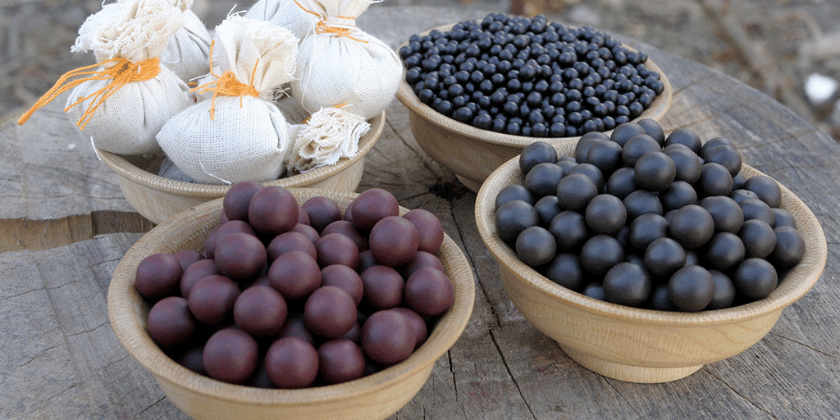
Visiting a BTM Clinic As a tourist in Bhutan, you can visit a BTM clinic to experience this traditional healing system. There are several BTM clinics across the country, including the Jigme Dorji Wangchuck National Referral Hospital in Thimphu, which has a dedicated BTM department.
During your visit, you can expect to receive a consultation with a BTM practitioner who will examine your pulse and ask questions about your symptoms, lifestyle, and medical history. The practitioner will then create a personalized treatment plan, which may include herbal medicines, dietary advice, and lifestyle changes.
It is essential to note that while BTM can be an effective form of treatment for certain conditions, it is not a substitute for modern medicine. If you have a severe or chronic medical condition, it is best to consult with a licensed medical doctor.
The Bhutanese government has also integrated BTM into the country’s healthcare system. Hospitals and clinics across the country offer BTM as a complementary therapy to modern medicine.
Conclusion Exploring Bhutanese Traditional Medicine can offer a unique and valuable insight into Bhutan’s culture and values. As a tourist, visiting a BTM clinic can be an enlightening experience, and you can learn about the country’s traditional healing system firsthand. It is essential to approach BTM with an open mind and to remember that it is a complementary therapy, not a substitute for modern medicine. By learning about BTM, you can gain a better understanding of Bhutan’s approach to healthcare and the importance of balance and harmony in daily life.
- Thangthong Dewachen Nunnery
Thangthong Dewachen Nunnery, also known as Zilukha nunnery, is one of the most popular tourist attractions in Bhutan. Located on a hill above the capital city of Thimphu, the nunnery offers a peaceful retreat for visitors seeking to explore Bhutanese Buddhism and witness the daily lives of nuns.
The nunnery was founded in 1976 by the 16th reincarnation of Thangthong Gyalpo, a legendary figure in Bhutanese history known for building numerous iron chain bridges throughout the country. The nunnery follows the Drukpa Kagyu lineage of Tibetan Buddhism and is home to around 60 nuns who have taken vows of celibacy, poverty, and service.
The main prayer hall of the nunnery houses a beautiful statue of Chenrezig, the Buddha of compassion, and a large prayer wheel that visitors can spin for good luck. The walls of the prayer hall are adorned with colorful murals depicting scenes from the life of Buddha and other important figures in Bhutanese Buddhism. Visitors are welcome to sit and observe the nuns as they chant and perform their daily prayers.
Aside from the prayer hall, the nunnery features a traditional Bhutanese-style kitchen where the nuns cook their meals, a meditation room, and a small museum dedicated to the life and works of Thangthong Gyalpo. Visitors can also take a leisurely walk around the nunnery grounds, which offer stunning views of the surrounding mountains and valley below.
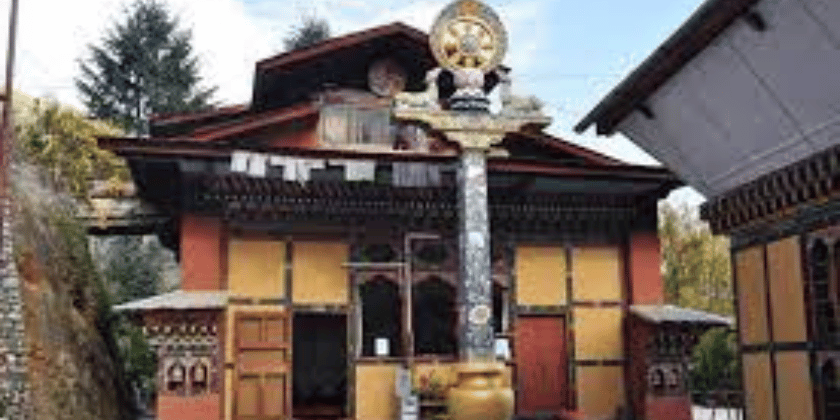
One of the unique experiences that visitors can have at the nunnery is participating in a meditation session led by one of the nuns. This offers a rare opportunity to learn more about the Buddhist practice and get a glimpse into the daily lives of the nuns.
Overall, a visit to Thangthong Dewachen Nunnery is a must-do for anyone interested in exploring the spiritual and cultural heritage of Bhutan. The nunnery offers a peaceful and serene atmosphere, making it an ideal place to escape from the hustle and bustle of city life and connect with Bhutanese Buddhism in a meaningful way.
- Phobjikha
Phobjikha is a beautiful valley located in central Bhutan, known for its stunning natural scenery and cultural significance. Visitors to this area are captivated by its pristine landscapes, unique wildlife, and rich Bhutanese culture. In this article, we will explore Phobjikha from a visiting tourist’s perspective, highlighting its top attractions and experiences.
One of the main attractions of Phobjikha is the Phobjikha Valley, a wide, glacial valley that stretches out beneath the towering peaks of the Black Mountains. Visitors can enjoy scenic walks through the valley, taking in the stunning views of the surrounding hillsides and farmland. The valley is also home to the endangered black-necked cranes, which migrate here from Tibet in the winter months. The annual Black-Necked Crane Festival, held in November, is a must-see event for those visiting during this time.
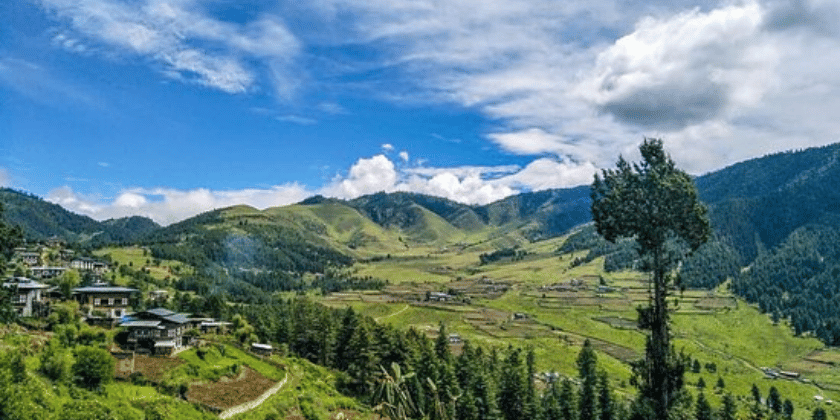
Another popular attraction in Phobjikha is the Gangtey Monastery, a 17th-century monastery built on a ridge overlooking the Phobjikha Valley. Visitors can explore the monastery’s ornate prayer halls and courtyards, as well as its impressive collection of Buddhist relics and artworks. The monastery also offers stunning views of the surrounding valley and hillsides, making it a great spot for photography.
For those looking to immerse themselves in Bhutanese culture, a visit to a local farm or homestay is a must. Visitors can learn about traditional farming practices, try their hand at making Bhutanese cuisine, and even take part in cultural activities like archery or traditional dances. Many farms in the Phobjikha Valley also offer overnight stays, giving visitors the chance to experience traditional Bhutanese hospitality firsthand.
Nature enthusiasts will also appreciate the many hiking trails and outdoor activities available in Phobjikha. Visitors can explore the valley on foot or horseback, taking in the beautiful scenery and spotting local wildlife like Himalayan black bears, red pandas, and sambar deer. Other outdoor activities in the area include birdwatching, mountain biking, and even hot air ballooning.
Finally, no trip to Phobjikha would be complete without trying some of the local cuisine. The valley is known for its fresh, organic produce and traditional Bhutanese dishes, such as ema datshi (chili and cheese stew) and phaksha paa (spicy pork). Visitors can sample these dishes at local restaurants or homestays, or even learn to cook them themselves during a Bhutanese cooking class.
In conclusion, Phobjikha is a stunning destination that offers visitors a unique blend of natural beauty and cultural significance. Whether you’re interested in hiking, wildlife, or Bhutanese culture, there is something for everyone in this picturesque valley.
- Royal Textile Academy of Bhutan
The Royal Textile Academy of Bhutan (RTA) is an institution that was founded in 2005 with the aim of preserving and promoting the traditional art of weaving in Bhutan. Located in the capital city of Thimphu, the RTA is a must-visit destination for tourists interested in Bhutanese textiles and handicrafts.
Upon entering the RTA, visitors are greeted by an impressive display of Bhutanese textiles, ranging from the intricately woven kiras and ghos (the traditional dress of Bhutanese women and men, respectively) to the more functional yak hair blankets and horsehair belts. The textiles are displayed in glass cases that are accompanied by informative labels that explain the history, materials, and techniques used in their creation.
One of the highlights of the RTA is the weaving demonstration area, where visitors can watch skilled weavers at work on traditional looms. The weavers are happy to answer any questions visitors may have about the weaving process and the meaning behind the various designs and patterns in Bhutanese textiles.
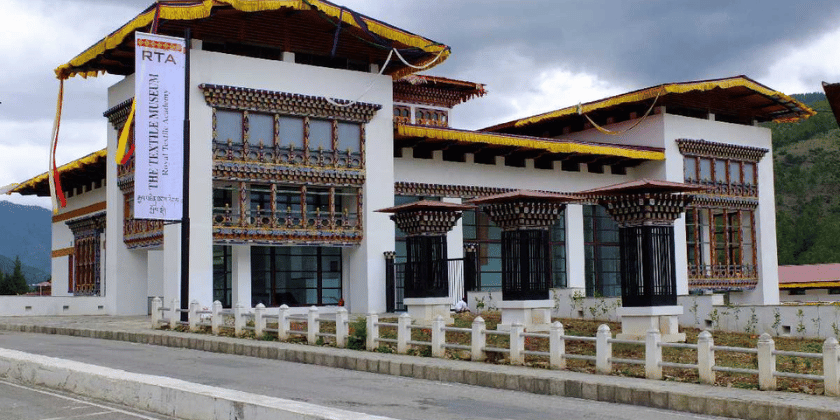
The RTA also offers workshops and classes for those who are interested in learning more about Bhutanese weaving. These workshops are taught by master weavers and cover a range of topics, from basic weaving techniques to more advanced methods such as natural dyeing.
In addition to its textile displays and weaving demonstrations, the RTA also has a gallery space that hosts rotating exhibitions of Bhutanese art and handicrafts. The exhibitions often focus on specific themes, such as the use of natural dyes or the symbolism behind certain textile patterns.
Visitors to the RTA can also enjoy a cup of tea or coffee in the charming café, which offers a selection of snacks and beverages. The café has a beautiful outdoor seating area with views of the surrounding hills, making it a great spot to relax and take in the beauty of Bhutan.
Overall, the Royal Textile Academy of Bhutan is an excellent destination for anyone interested in learning about Bhutanese textiles and handicrafts. With its informative displays, weaving demonstrations, and workshops, the RTA provides a unique insight into the rich cultural heritage of Bhutan.
- Ugyen Pelri Palace
Ugyen Pelri Palace is a beautiful royal palace situated in the heart of the lush green valley of Paro in Bhutan. It is a popular tourist attraction that offers a glimpse into the rich cultural heritage of Bhutan. The palace was built in 1909 by the 2nd King of Bhutan, Jigme Wangchuck, as a summer residence for his father, Ugyen Wangchuck, the first King of Bhutan.
The Ugyen Pelri Palace is a beautiful example of Bhutanese architecture, with its traditional sloping roofs, intricate woodcarvings, and colorful paintings. The palace is surrounded by beautiful gardens and is set against a backdrop of snow-capped mountains, making it a picturesque and tranquil location.
Visitors to the Ugyen Pelri Palace can explore the various rooms and chambers that have been preserved in their original state. The palace has three floors and features beautiful traditional Bhutanese décor, including hand-painted murals, wooden furniture, and religious artifacts. The main entrance to the palace is adorned with beautiful paintings of the four Guardian Kings, who are believed to protect the palace and its inhabitants.
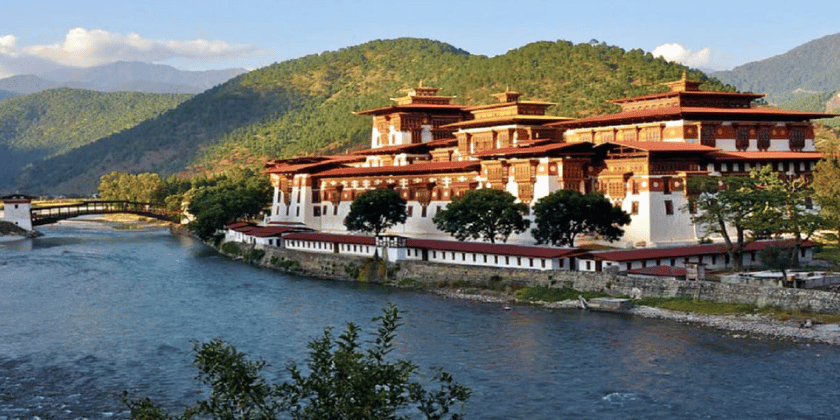
The palace also houses a beautiful temple dedicated to Guru Rinpoche, the founder of Buddhism in Bhutan. The temple is intricately decorated with colorful paintings and sculptures, and visitors can observe the daily prayer rituals conducted by the resident monks.
The Ugyen Pelri Palace also serves as a museum, showcasing various artifacts and objects that have been collected over the years by the royal family. Visitors can see a collection of traditional clothing, jewelry, and weaponry, as well as rare manuscripts and books.
The palace grounds also include a beautiful garden that is perfect for a leisurely stroll. The garden is home to a variety of indigenous plants and flowers, as well as a small pond and a traditional Bhutanese-style bridge.
Overall, a visit to the Ugyen Pelri Palace is a must-do for anyone interested in Bhutanese culture and history. The palace offers a unique glimpse into the royal heritage of Bhutan and is a great place to spend a peaceful afternoon surrounded by natural beauty and architectural splendor.
- Kuenselphodrang Nature Park
Kuenselphodrang Nature Park is a popular tourist destination in Bhutan. Located just outside of Thimphu, the capital city, the park is a beautiful natural area that provides a unique opportunity to explore Bhutan’s rich biodiversity. Visitors to the park can enjoy a variety of activities, including hiking, bird watching, and picnicking, and can also learn about Bhutan’s conservation efforts.
The park is named after the Kuenselphodrang Hill, which is a prominent feature in the area. The hill is home to a massive statue of Buddha, which is one of the largest in the world. Visitors can hike up the hill to get a closer look at the statue and enjoy breathtaking views of the surrounding area.
One of the main attractions of the park is its extensive network of hiking trails. Visitors can choose from a variety of trails that range in difficulty from easy to challenging. Some of the most popular trails include the Thimphu Viewpoint Trail, the Wangditse Loop Trail, and the Phajoding Monastery Trail.
The Thimphu Viewpoint Trail is a relatively easy hike that provides stunning views of the city of Thimphu. The trail is well-marked and takes visitors through lush forests and past several scenic overlooks. The Wangditse Loop Trail is a moderate hike that takes visitors through a beautiful rhododendron forest and past several small waterfalls. The Phajoding Monastery Trail is a more challenging hike that takes visitors up to the Phajoding Monastery, which is located at an altitude of over 3,500 meters.
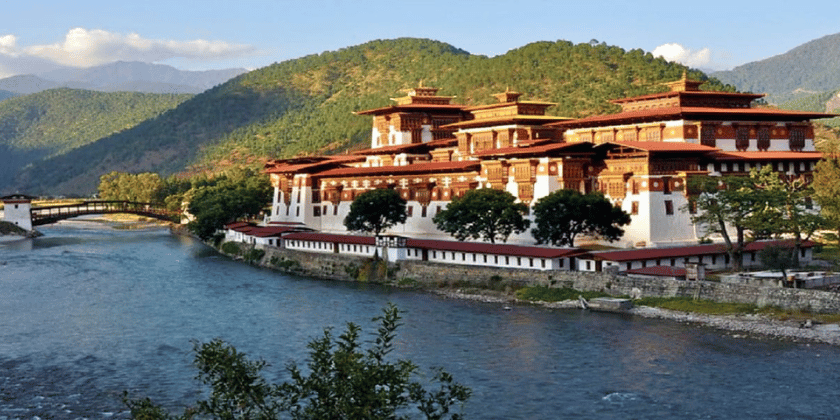
Another popular activity at the park is bird watching. The park is home to a wide variety of bird species, including several that are endemic to Bhutan. Visitors can spot birds such as the Satyr Tragopan, the Rufous-necked Hornbill, and the Beautiful Nuthatch, among many others.
For those who want to relax and enjoy the natural surroundings, the park also has several picnic areas that are perfect for a family outing. Visitors can bring their own food or purchase snacks and drinks at the park’s cafeteria.
In addition to its recreational offerings, Kuenselphodrang Nature Park is also a hub for conservation and education efforts in Bhutan. The park is home to the Bhutan Biodiversity Portal, which is a database of information on Bhutan’s flora and fauna. The park also hosts workshops and educational programs for students and community members to learn about conservation and sustainability practices.
Overall, Kuenselphodrang Nature Park is a must-visit destination for anyone interested in exploring Bhutan’s natural beauty and learning about its conservation efforts. Whether you’re an avid hiker, a bird-watching enthusiast, or just looking for a peaceful place to relax, the park has something for everyone.
- Gom Kora
Gom Kora, also known as Gomphu Kora, is a small temple and meditation site located in eastern Bhutan, near the border with India. It is a popular destination for both locals and tourists due to its unique history, stunning scenery, and spiritual significance. In this article, we will explore Gom Kora from a visiting tourist’s perspective.
History and Significance
Gom Kora dates back to the 8th century and is said to have been built by the famous Tibetan saint, Guru Rinpoche, who visited the site during his travels to Bhutan. The temple is built around a large rock, which is believed to be the body of an evil spirit that Guru Rinpoche subdued and transformed into a protective deity.
According to legend, Guru Rinpoche meditated at the site for three months and defeated a demon that was terrorizing the local villagers. The demon was believed to have been responsible for the deaths of many people, and the defeat of the demon led to the conversion of the people in the region to Buddhism.
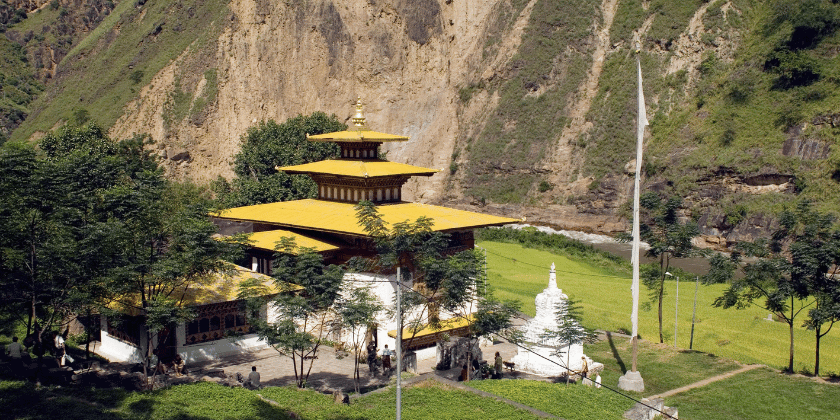
Gom Kora is also known for its annual festival, which takes place in March or April and attracts thousands of pilgrims from across Bhutan and neighboring India. The festival is a time of prayer, meditation, and celebration, and includes traditional dances and music, as well as the opportunity to receive blessings from the local monks.
Visiting Gom Kora
To reach Gom Kora, visitors must travel east from the capital city of Thimphu, passing through scenic countryside and traditional Bhutanese villages. The journey takes approximately six hours by car, and visitors are advised to hire a guide and driver to ensure a smooth and safe trip.
Upon arrival, visitors are greeted by the sight of the temple, which is perched on a hill overlooking a small river. The temple is surrounded by lush green forests, and the air is filled with the sounds of birds and the gentle murmur of the river.
Visitors are welcome to explore the temple and its surroundings, and are encouraged to participate in the daily rituals and prayers conducted by the resident monks. The temple is small and intimate, with colorful prayer flags fluttering in the breeze and the smell of incense filling the air.
One of the most popular activities at Gom Kora is to circumambulate the temple, walking clockwise around the perimeter while spinning prayer wheels and reciting mantras. This is believed to bring good luck and blessings to those who participate.
Another highlight of Gom Kora is the nearby meditation caves, which are believed to have been used by Guru Rinpoche during his stay at the site. Visitors can hike to the caves, which offer stunning views of the surrounding countryside and provide a peaceful and meditative atmosphere.
Conclusion
Gom Kora is a unique and special place, full of history, spirituality, and natural beauty. A visit to this temple is a must for anyone traveling to Bhutan, and offers a glimpse into the country’s rich cultural and religious heritage. Whether you are seeking spiritual enlightenment, cultural immersion, or simply a beautiful and peaceful retreat, Gom Kora has something to offer for everyone.
- Zangto Pelri Lhakhang
Zangto Pelri Lhakhang is a magnificent temple located in the heart of the picturesque town of Paro in Bhutan. This temple is dedicated to Guru Rinpoche, also known as Padmasambhava, who is considered to be the founder of Buddhism in Bhutan. The temple is one of the most important pilgrimage sites in Bhutan and is known for its beautiful architecture, stunning paintings, and intricate carvings.
As a tourist visiting Zangto Pelri Lhakhang, you will be amazed by the beauty of the temple and the surrounding natural landscape. The temple is located in a serene and peaceful environment surrounded by lush green forests and majestic mountains. The temple’s stunning architecture features three floors, each with its own unique design and decorations.
The first floor of the temple houses the main shrine, where you will find a statue of Guru Rinpoche surrounded by other Buddhist deities. The shrine is adorned with beautiful paintings and intricate carvings that reflect the rich cultural heritage of Bhutan. The walls of the shrine are decorated with colorful murals that depict the life of Guru Rinpoche and other important Buddhist figures.
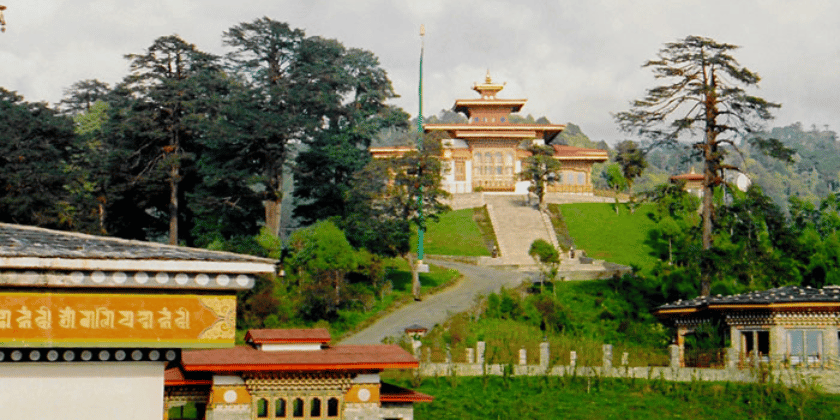
The second floor of the temple features a meditation hall where visitors can participate in meditation sessions and other spiritual practices. The meditation hall is surrounded by beautiful paintings and murals that depict various aspects of Buddhist philosophy and teachings.
The third floor of the temple features a library that contains a vast collection of Buddhist texts and scriptures. Visitors can browse through the library and learn more about the rich cultural heritage of Bhutan and its deep connection to Buddhism.
In addition to its stunning architecture and rich cultural heritage, Zangto Pelri Lhakhang is also known for its spiritual significance. The temple is believed to be a powerful source of positive energy and a place where visitors can connect with their inner selves and experience a sense of peace and tranquility.
Overall, a visit to Zangto Pelri Lhakhang is a must for anyone interested in the rich cultural heritage and spiritual traditions of Bhutan. As a tourist, you will be amazed by the beauty of the temple and the surrounding natural landscape, and you will have the opportunity to connect with your inner self and experience a sense of peace and tranquility that is truly unique to Bhutan.
- Dzong Fortress
As one of the most distinctive architectural structures in Bhutan, the dzong fortress offers visitors an immersive glimpse into the country’s history, culture, and spirituality. A dzong is a fortress that was traditionally built to serve as the administrative and religious center of a district or region. These imposing structures, which are still in use today, are known for their distinctive style, with high whitewashed walls, red roofs, and intricate woodwork. Of the many dzongs in Bhutan, some of the most famous and significant include Punakha Dzong, Trongsa Dzong, and Paro Dzong.
One dzong that is well worth visiting is the Dzong Fortress in the capital city of Thimphu. Located on a ridge overlooking the city, this impressive structure is one of the largest dzongs in Bhutan, covering an area of over 35 acres. The dzong is also known as Tashichho Dzong, which translates to “fortress of the glorious religion.” Originally built in the 17th century, the dzong has been renovated and expanded numerous times over the centuries and now serves as the seat of the Bhutanese government, as well as the summer residence of the Je Khenpo, the country’s highest religious leader.
As visitors approach the dzong, they will first notice the impressive whitewashed walls, which are punctuated by ornate wooden balconies and windows. The dzong is surrounded by a moat, which was traditionally used as a defense against invading armies. The main entrance to the dzong is via a massive wooden bridge that spans the moat. Once inside the dzong, visitors are immediately struck by the serene and peaceful atmosphere. The courtyard is paved with smooth stones and is surrounded by wooden galleries with intricate carvings. The central tower of the dzong is adorned with intricate paintings and statues, and visitors can explore the various prayer halls, offices, and living quarters of the dzong’s inhabitants.
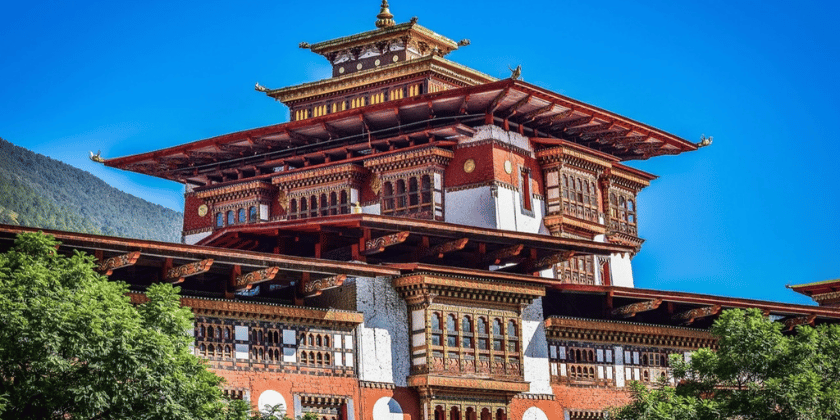
One of the most popular times to visit the dzong is during one of the many festivals or ceremonies that are held there throughout the year. One such festival is the Thimphu Tshechu, a vibrant and colorful celebration that takes place every autumn. During the festival, monks perform traditional dances and rituals, and visitors can sample traditional Bhutanese cuisine and shop for handicrafts and souvenirs.
Visitors to the Dzong Fortress can also learn about the history and culture of Bhutan by visiting the National Museum, which is housed within the dzong’s walls. The museum contains a vast collection of Bhutanese artifacts and exhibits, including traditional costumes, weapons, and artwork. Visitors can learn about the history of Bhutan, from its ancient Buddhist roots to its modern-day status as a constitutional monarchy.
In conclusion, the Dzong Fortress in Thimphu is a must-visit destination for anyone interested in Bhutan’s rich history, culture, and spirituality. This impressive structure offers visitors an immersive glimpse into the heart of Bhutan, and its peaceful and serene atmosphere is sure to leave a lasting impression. Whether you are interested in learning about Bhutanese history, exploring ancient architecture, or simply enjoying the stunning scenery, the Dzong Fortress is the perfect destination for a truly unique and unforgettable experience.
- Jigme Dorji Wildlife Sanctuary
Jigme Dorji Wildlife Sanctuary (JDWS) is one of the largest protected areas in Bhutan, covering an area of 4,316 square kilometers. The sanctuary is located in the northwestern part of Bhutan and is named after Jigme Dorji Wangchuck, the third king of Bhutan. The sanctuary is home to a diverse range of flora and fauna, including some endangered species, making it a must-visit destination for nature lovers and wildlife enthusiasts.
As a visiting tourist, exploring JDWS can be an exciting and memorable experience. The sanctuary is located in a remote and isolated area of Bhutan, which makes it an ideal place to escape the hustle and bustle of urban life and connect with nature. The sanctuary is surrounded by pristine forests, snow-capped mountains, and crystal-clear rivers, providing visitors with breathtaking views of the natural beauty of Bhutan.
One of the most notable features of JDWS is its diverse range of wildlife. The sanctuary is home to several rare and endangered species, including the Bengal tiger, snow leopard, red panda, Himalayan black bear, and takin. Visitors can go on guided tours and treks to explore the sanctuary and get a chance to spot some of these elusive creatures in their natural habitat.
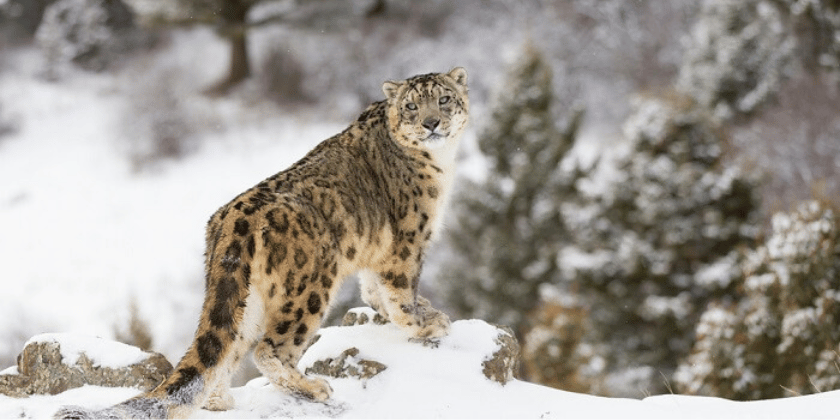
Apart from wildlife, JDWS also offers visitors a chance to experience the rich cultural heritage of Bhutan. The sanctuary is home to several villages inhabited by ethnic groups, such as the Layap, Brokpa, and Lunaps. These communities have preserved their unique cultural traditions and offer visitors an opportunity to witness their way of life firsthand.
One of the best ways to explore JDWS is by going on a trek. The sanctuary offers several trekking routes that vary in difficulty level, making it suitable for both novice and experienced trekkers. The trekking routes take visitors through some of the most scenic parts of the sanctuary, allowing them to soak in the natural beauty of Bhutan and get up close with the wildlife.
For visitors who prefer a more relaxed experience, JDWS also offers camping and picnic sites. These sites are located in some of the most picturesque locations in the sanctuary and offer visitors a chance to relax, unwind, and enjoy the natural beauty of Bhutan.
In conclusion, Jigme Dorji Wildlife Sanctuary is a must-visit destination for anyone visiting Bhutan. The sanctuary offers visitors a chance to experience the natural beauty of Bhutan, explore its diverse range of wildlife, and connect with its rich cultural heritage. Whether you are a nature lover, wildlife enthusiast, or cultural explorer, JDWS has something to offer for everyone.
- Yotongla Pass
Yotongla Pass is one of the most scenic mountain passes in Bhutan, offering breathtaking views of the surrounding Himalayan landscape. Located in the western part of the country, the pass is situated at an altitude of 3,425 meters above sea level and is a popular destination for tourists who want to experience the natural beauty of Bhutan.
As you make your way up the winding roads towards Yotongla Pass, you’ll be surrounded by lush forests, cascading waterfalls, and stunning mountain vistas. The pass itself is marked by a small stone chorten, which is a traditional Buddhist shrine, and offers panoramic views of the surrounding valleys and mountains.
One of the main attractions of Yotongla Pass is the opportunity to spot rare and endangered wildlife. The pass is part of the Jigme Dorji National Park, which is home to a wide variety of animal species, including the takin, Bhutan’s national animal, as well as snow leopards, Himalayan black bears, and red pandas.
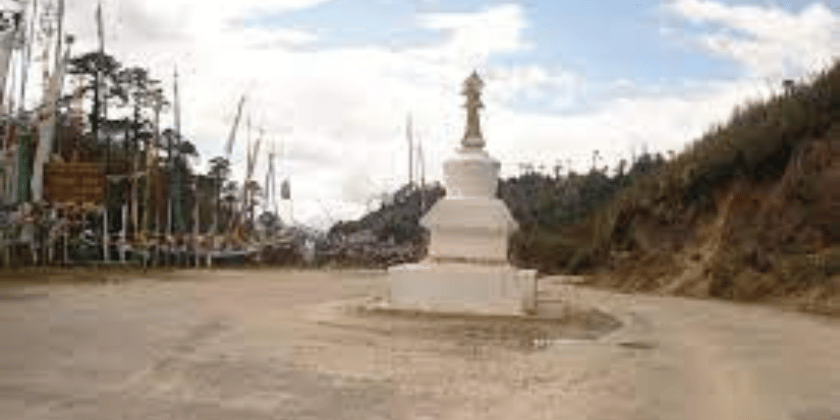
In addition to its natural beauty and wildlife, Yotongla Pass is also steeped in history and culture. The pass is named after Yotongla, a legendary figure in Bhutanese folklore who is said to have been a skilled archer and warrior. According to legend, Yotongla used his archery skills to defeat a powerful demon who had been terrorizing the local people.
There are several hiking trails around Yotongla Pass, ranging from easy walks to more challenging treks that take you deep into the heart of the Jigme Dorji National Park. One of the most popular hikes is the trail that leads to the nearby Dochula Pass, which offers even more stunning views of the Himalayan mountains.
If you’re planning a visit to Yotongla Pass, it’s important to keep in mind that the pass can be closed during the winter months due to heavy snowfall. The best time to visit is during the spring and fall, when the weather is milder and the landscape is alive with color.
In conclusion, a visit to Yotongla Pass is an unforgettable experience that offers a unique blend of natural beauty, wildlife, and culture. Whether you’re a nature lover, history buff, or simply looking for a scenic drive, Yotongla Pass is a must-see destination in Bhutan.
- Simtokha Dzong
Simtokha Dzong, located just outside of Bhutan’s capital city, Thimphu, is one of the country’s oldest and most important fortresses. Built in 1629 by the Zhabdrung Ngawang Namgyal, Simtokha Dzong is not only an impressive structure but also a fascinating piece of Bhutanese history. As a tourist, visiting this dzong is a must-do activity that offers an unforgettable glimpse into the country’s past.
Architecture
Simtokha Dzong’s architecture is unique and striking. The dzong is built in a square shape with towering walls that reach up to 30 meters high. The walls are made from thick stone and are adorned with intricate carvings and paintings, many of which depict Buddhist symbols and teachings.
The dzong’s courtyard is also a sight to behold. The central tower, or utse, rises high above the other structures and is crowned with a golden roof. The courtyard is filled with beautiful gardens and trees, and there are several smaller temples and buildings that house various administrative offices and classrooms.
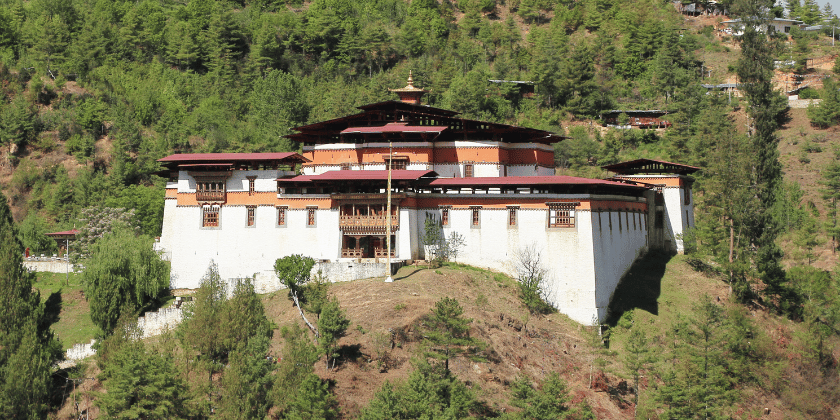
History
Simtokha Dzong has a rich history that dates back to the early 17th century. The dzong was built by the Zhabdrung Ngawang Namgyal, who is considered to be the father of Bhutan. The dzong was constructed as a fortress to protect the country against invading Tibetan armies.
Over the centuries, Simtokha Dzong has played an important role in Bhutanese history. It has served as a monastery, a seat of government, and a school for Buddhist studies. Today, it is home to the Institute for Language and Cultural Studies, which is responsible for preserving Bhutan’s unique culture and traditions.
Visiting Simtokha Dzong
Visiting Simtokha Dzong is a memorable experience that offers a glimpse into Bhutan’s past. As a tourist, you can explore the dzong’s stunning architecture and learn about its history and significance. The dzong is open to visitors all year round, although it may be closed during important religious festivals.
When visiting Simtokha Dzong, be sure to dress appropriately. Visitors are required to wear long pants and shirts that cover their shoulders. It is also customary to remove your shoes before entering any temple or monastery in Bhutan.
Inside the dzong, visitors can explore the courtyard, the central tower, and the various temples and administrative offices. You can also view the stunning murals and carvings that adorn the walls. The dzong’s museum houses a collection of historical artifacts and exhibits that offer a deeper understanding of Bhutan’s culture and traditions.
Conclusion
Simtokha Dzong is a fascinating piece of Bhutanese history and a must-see attraction for any tourist visiting the country. Its stunning architecture, rich history, and importance in Bhutanese culture make it a worthwhile destination. Whether you’re interested in history, architecture, or religion, a visit to Simtokha Dzong is sure to be a memorable experience.
Book Your Flights : Here 30% OFF on Booking
Book Your Hotels : Here 20% OFF on Booking

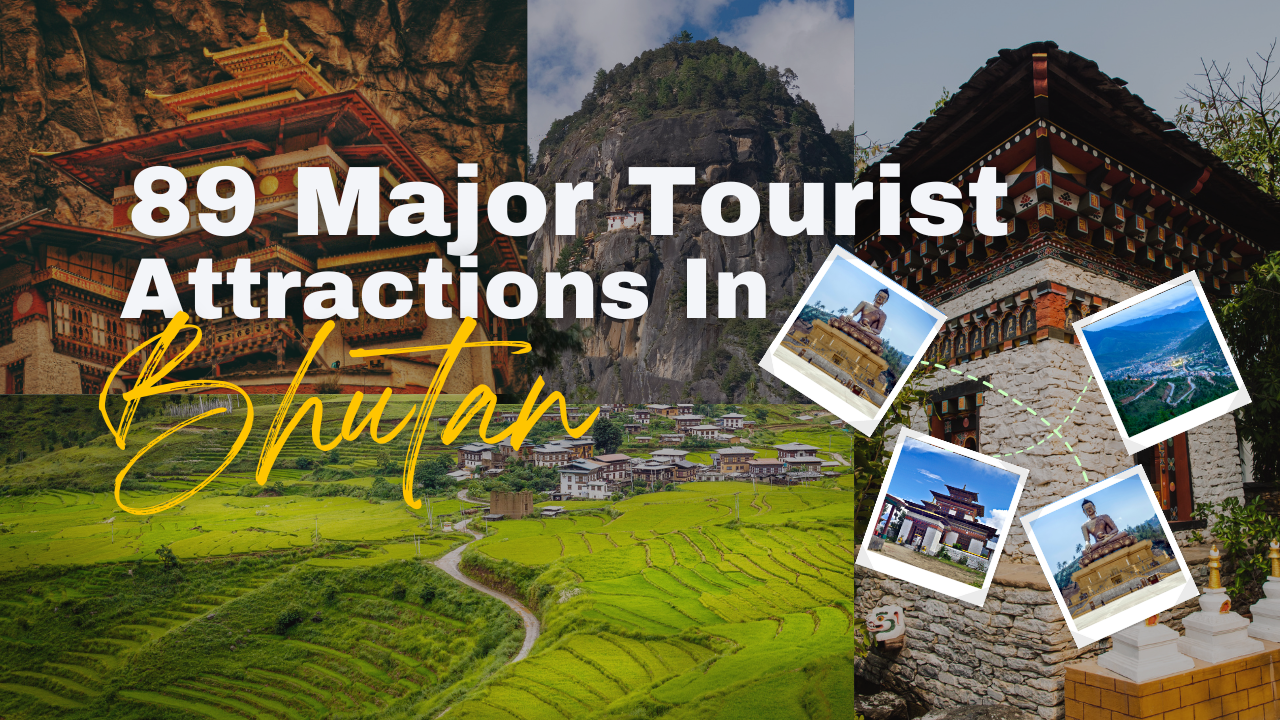
0 Comment